It seems we can’t find what you’re looking for. Perhaps searching can help.
Sign Up for newsletter!
Subscribe to get the latest eBook!
Hotline


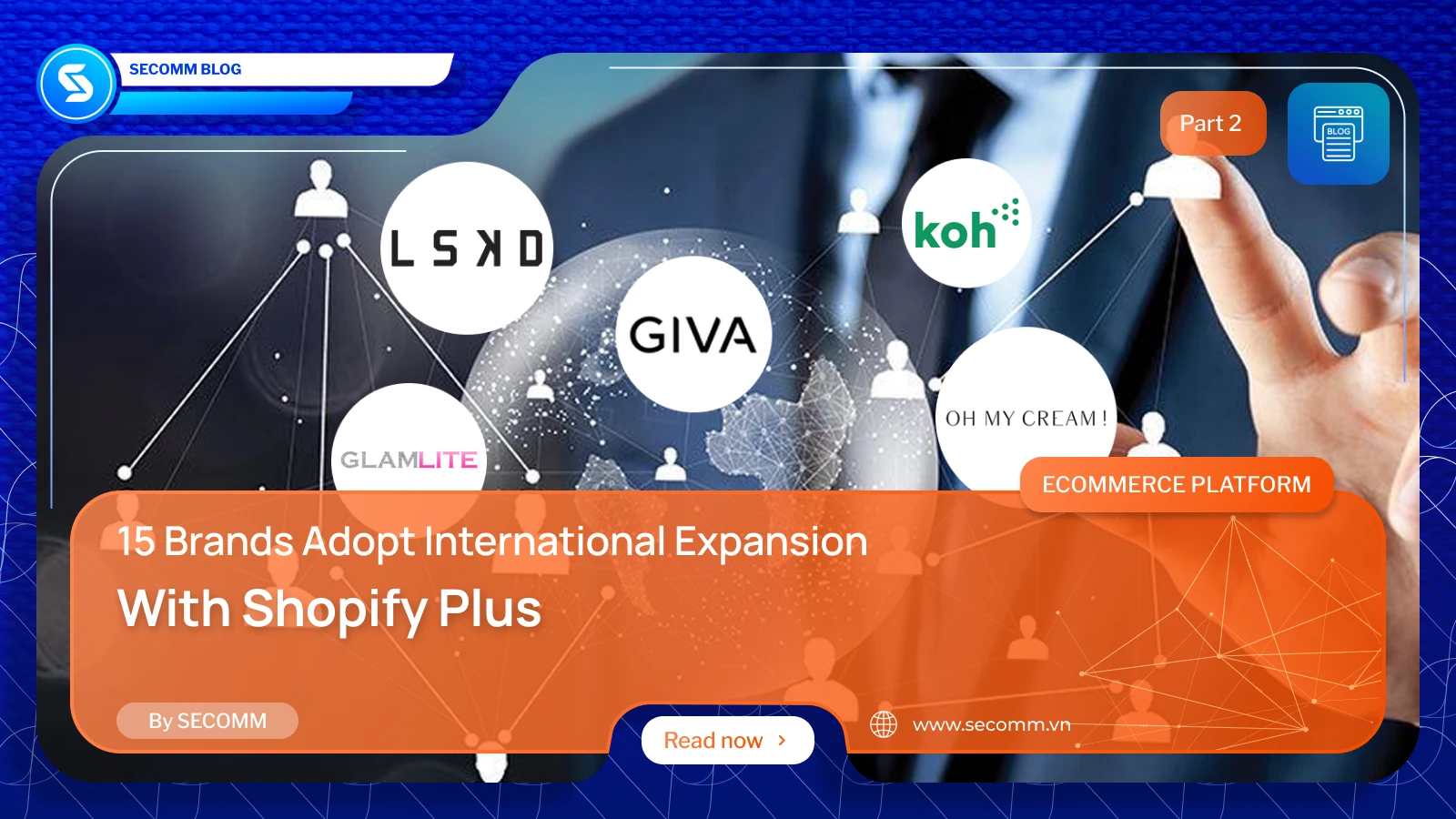
 2
2
 3,126
3,126
 0
0
 1
1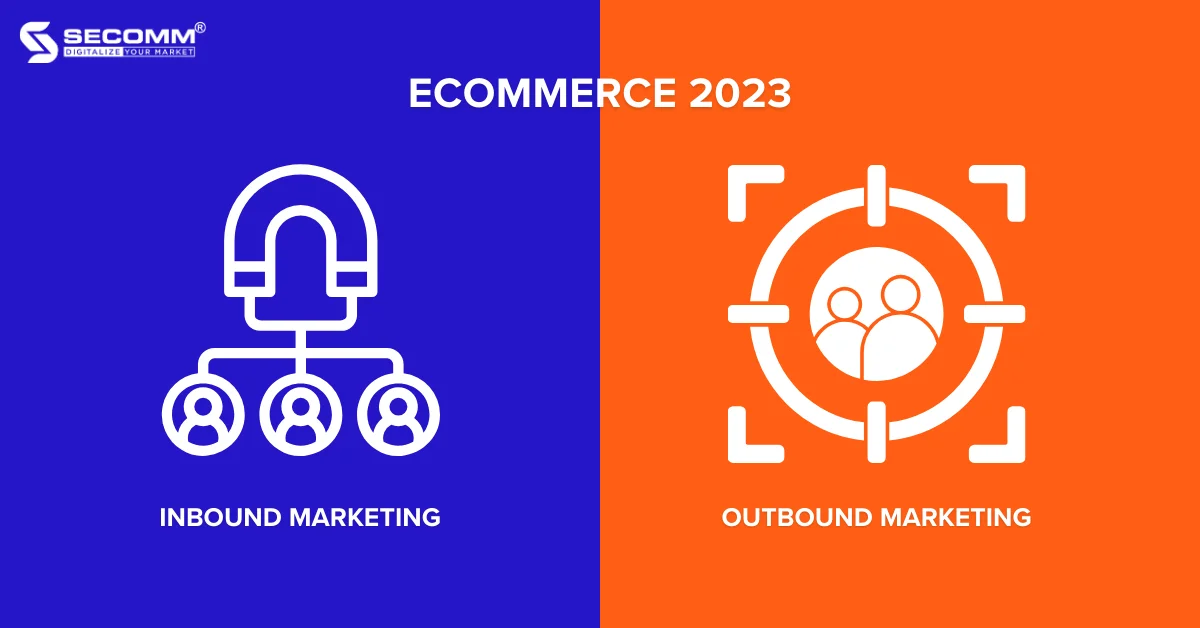
 2
2
 11,066
11,066
 0
0
 1
1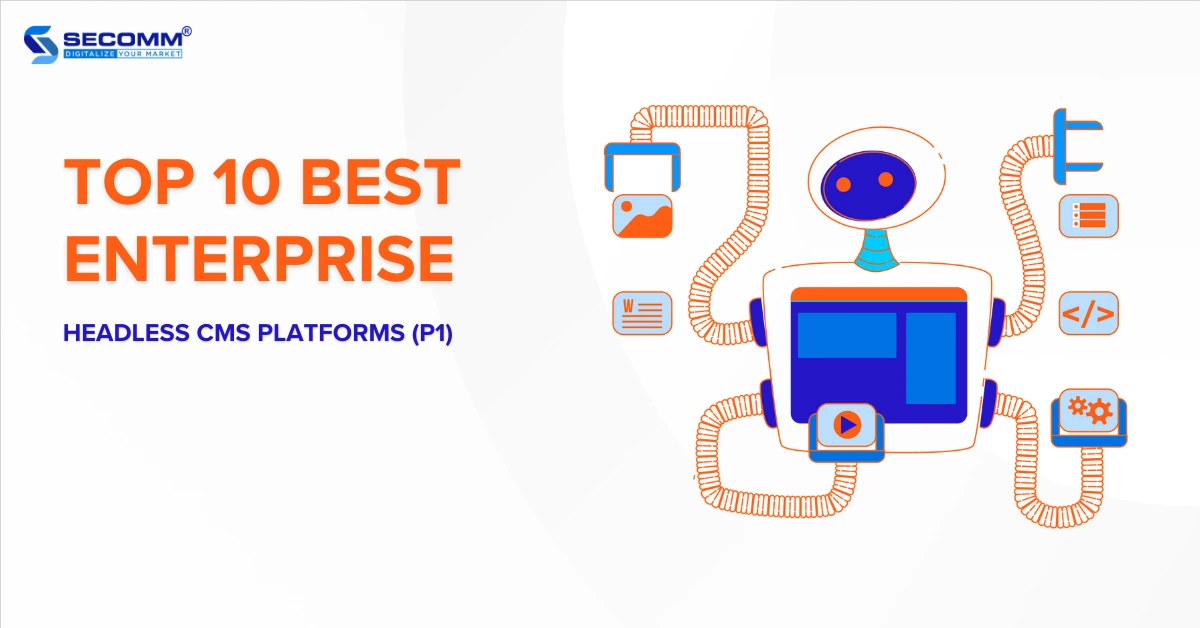
 2
2
 11,028
11,028
 0
0
 1
1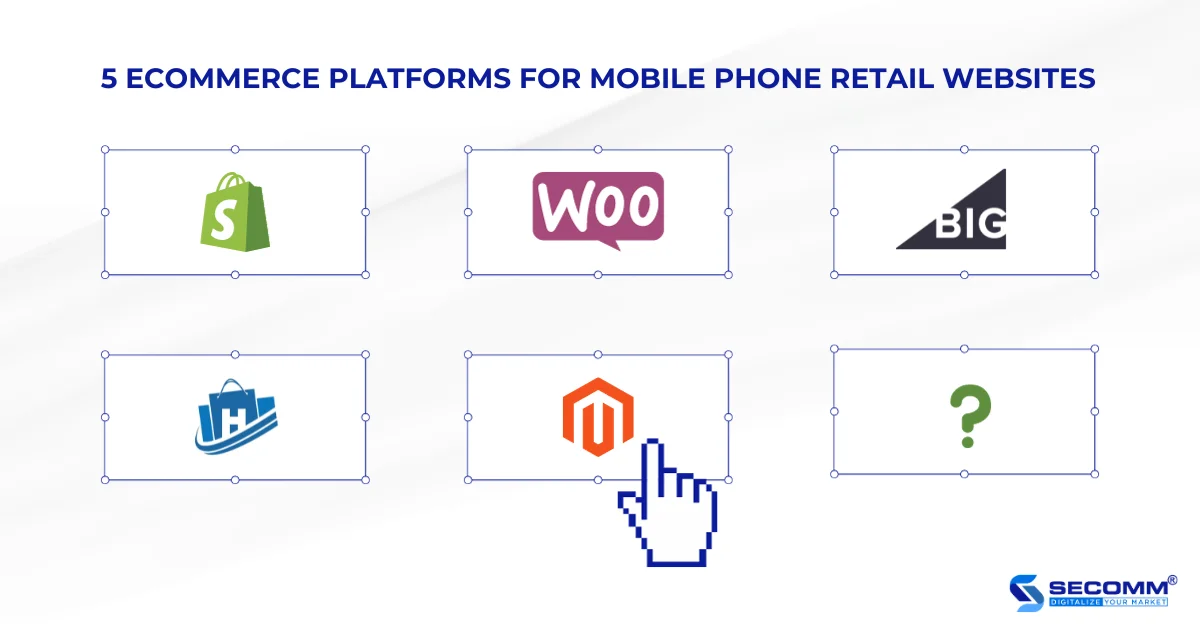
 2
2
 10,879
10,879
 0
0
 1
1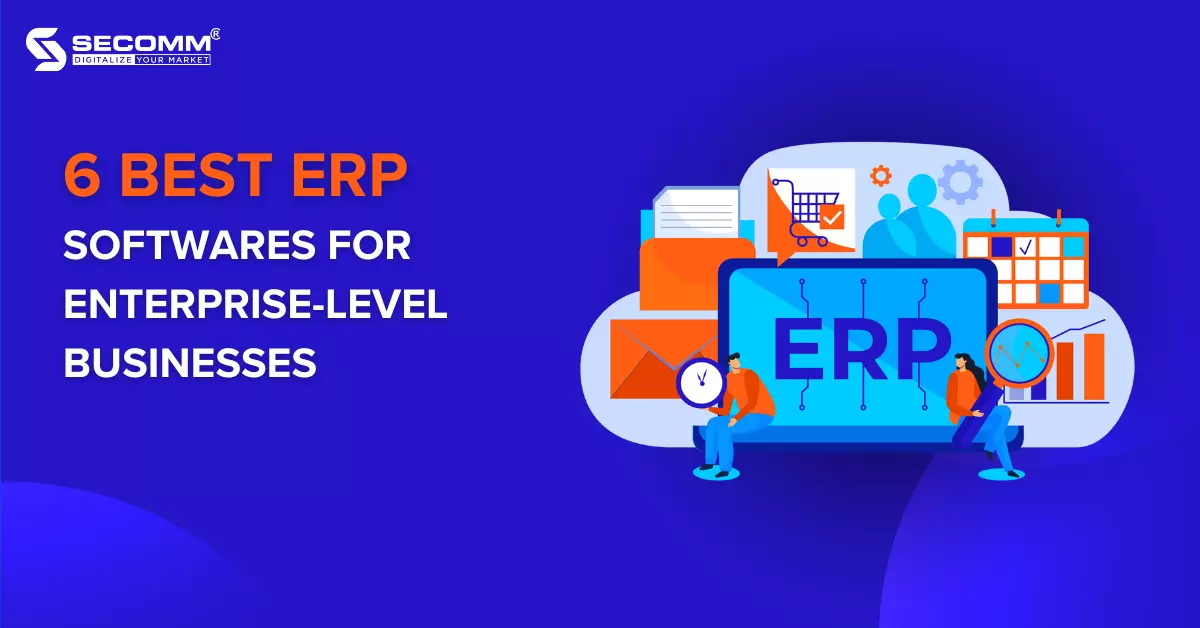
 2
2
 10,684
10,684
 0
0
 1
1



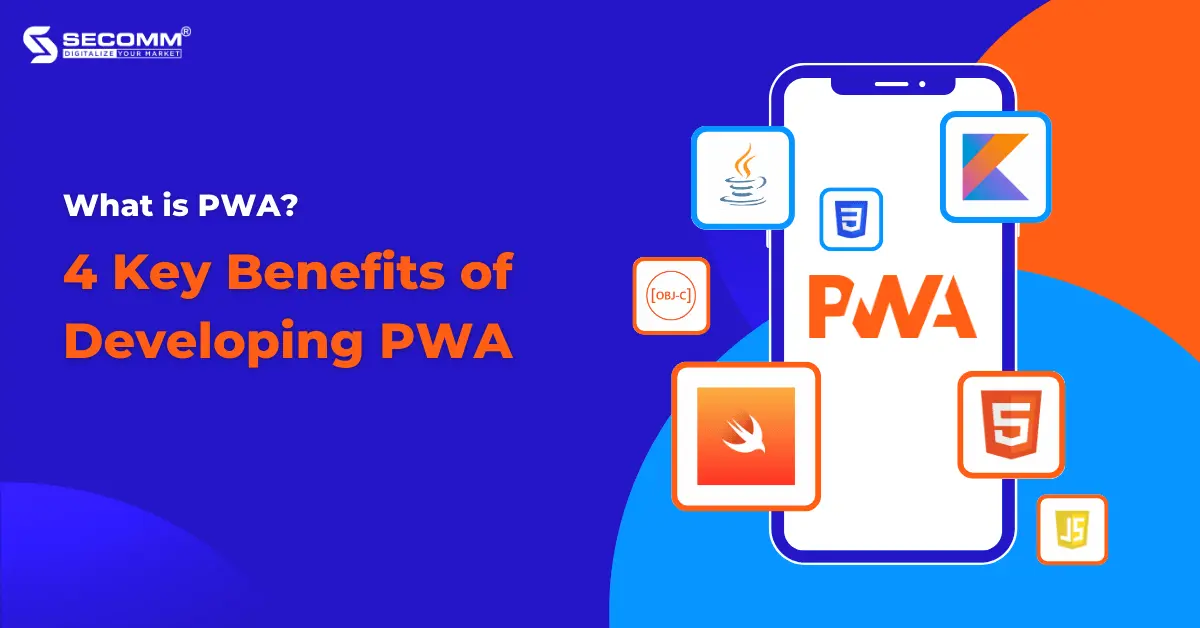
Amidst the fierce competition in eCommerce, businesses of all sizes are striving to find breakthrough solutions to enhance customer experience and boost engagement. Among the numerous options available, PWA (Progress Web App) is considered a promising solution that can change the way users interact with an eCommerce website. Although PWA has been in the market for a while, its popularity has only recently surged in recent years.
A Progressive Web App (PWA) is a type of web application built using standard web technologies such as HTML, CSS, and JavaScript, but can provide users with a similar experience and features to a native app, including push notifications, offline availability, etc.
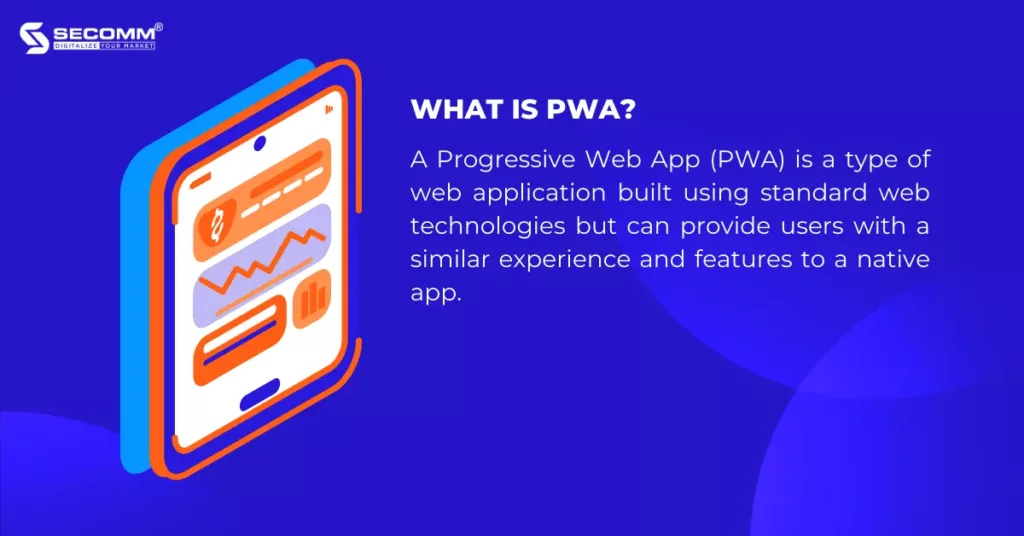
Native apps, what do they actually mean? They are software applications built on a specific programming language for a particular platform or operating system such as iOS or Android.
Because of the differences between the two types of applications, businesses usually rely on their needs and resources to make a suitable choice.
Related Readings: Native App vs Hybrid App: Key Differences
Native apps are typically built using a programming language specific to each particular operating system, such as Objective-C/Swift for iOS and Java/Kotlin for Android. Meaning that developers must have a certain level of experience and expertise to write and develop apps that are suitable for each operating system. Additionally, maintaining and updating app versions must be done regularly, which can be time-consuming and costly.
On the other hand, when developing a progressive web app, developers can use a shared codebase to develop apps for all platforms, making development and maintenance faster and easier than with a native app.
To use Native apps, users need to access app stores such as the Apple’s App Store or Google Play to download and install them, while with progressive web app, users can install them directly from their web browser onto their device without going through an app store.
Although PWA can provide good performance and user experience, it is still generally not as good as native apps. Native apps offer a more seamless and richer user experience than progressive web app because they are designed specifically for a particular platform and can maximize the use of hardware and software features of the device.
Summary:
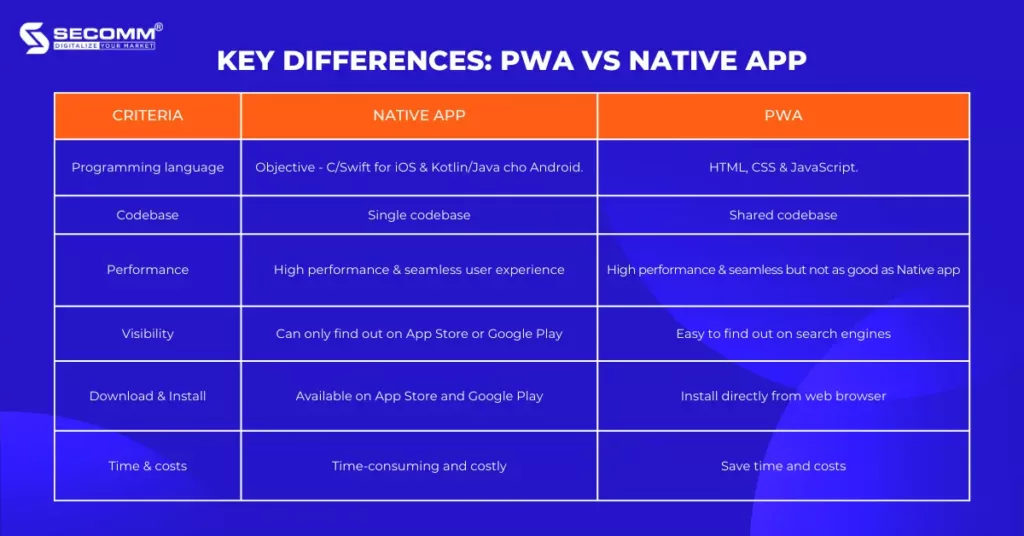
Currently, PWA is becoming very popular and is being chosen by many businesses everywhere in the world for the following benefits:
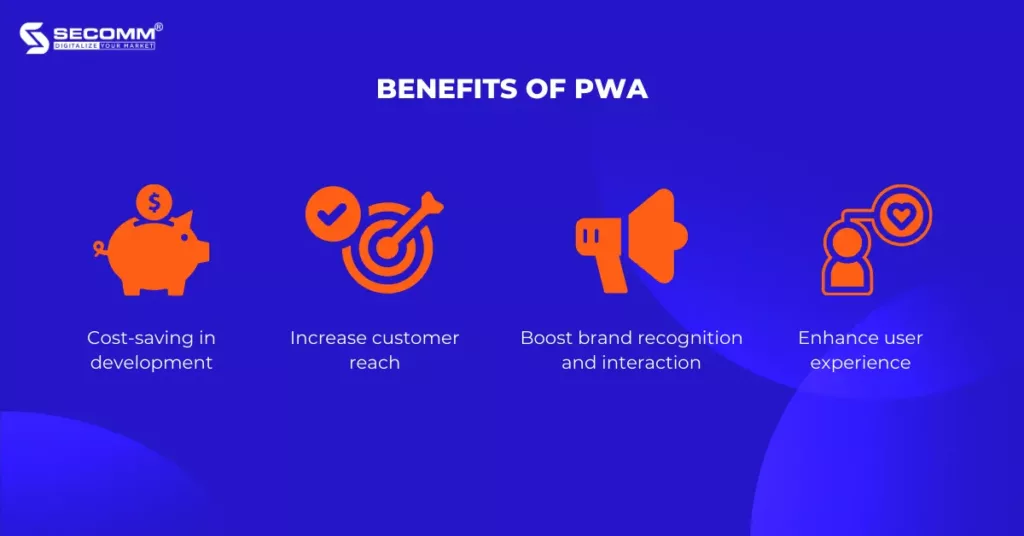
This is the biggest advantage and the main reason why many businesses are turning to PWA. The cost to build and maintain PWA is relatively low compared to native apps because it doesn’t require developing separately for each platform. Moreover, after installation, PWA functions like a native app with no compromise on performance and user experience. Therefore, for businesses with budget constraints, PWA is a worthwhile option to consider in order to save costs and time to launch the product.
Since PWA is designed to work efficiently on various devices and platforms such as smartphones, tablets, desktops, laptops, etc., users can access the app through a web browser and install it directly onto the home screen without downloading it from the app store. Therefore, PWA can reach a wider pool of potential customers, allowing businesses to expand their customer reach.
The “add-to-home-screen” feature of PWA enables customers to easily add the app to their device home screen directly from the web browser. In reality, customers only click on this feature when they browse and find the app interesting and useful for them. Once the app has been added to the home screen, users will easily see and remember the brand. This way, businesses can use targeted marketing methods to encourage customer interaction.
Similar to native apps, PWA can also provide a quality user experience with fast page loading time, smooth navigation, and stable performance. In addition, it is capable of quickly responding and operating well on many devices with various screen sizes, helping users view content and products on any preferred device. PWA is developed based on web technologies, which means businesses can track and analyze user behavior in real-time and make data-driven decisions to enhance user experience.
Lancôme, the leading high-end cosmetics brand in the world, launched a PWA in 2017 to enhance user experience and improve mobile web interaction. The Lancôme PWA provides features such as an icon on the home screen, push notifications, offline mode, and more. This allows customers to quickly access Lancôme’s website with just one touch, and the company can use push notifications to inform customers about the latest products, promotions, and special offers. In addition, the offline mode allows customers to continue browsing Lancôme’s website even without an internet connection.
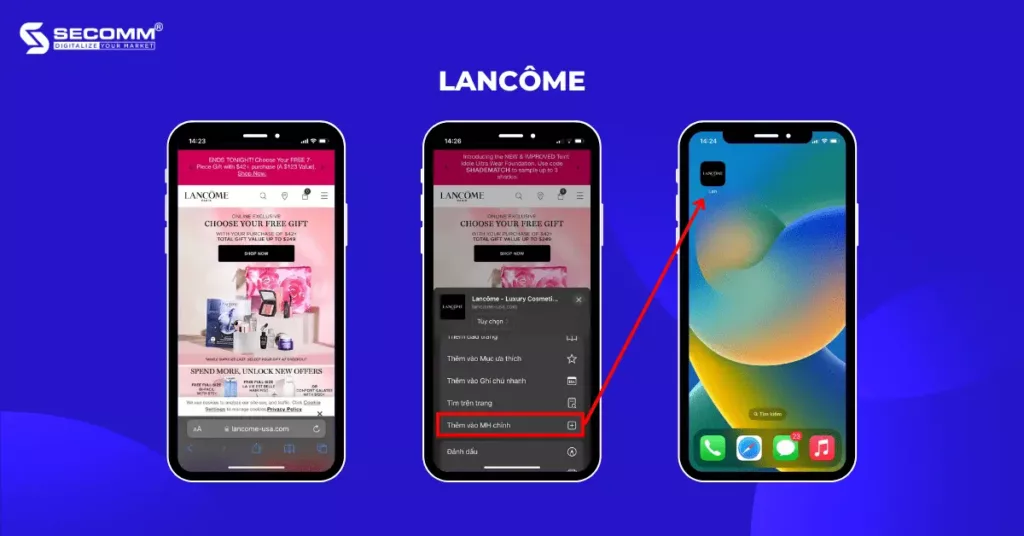
The famous online music platform – Spotify, developed and launched their own PWA in 2018 to provide a fast, seamless, and engaging user experience for their customers. Similar to Lancôme, Spotify also offers prominent features including offline music and podcast playback, which helps to ensure an uninterrupted user experience. The Spotify PWA has received positive reviews and feedback from users for many years.
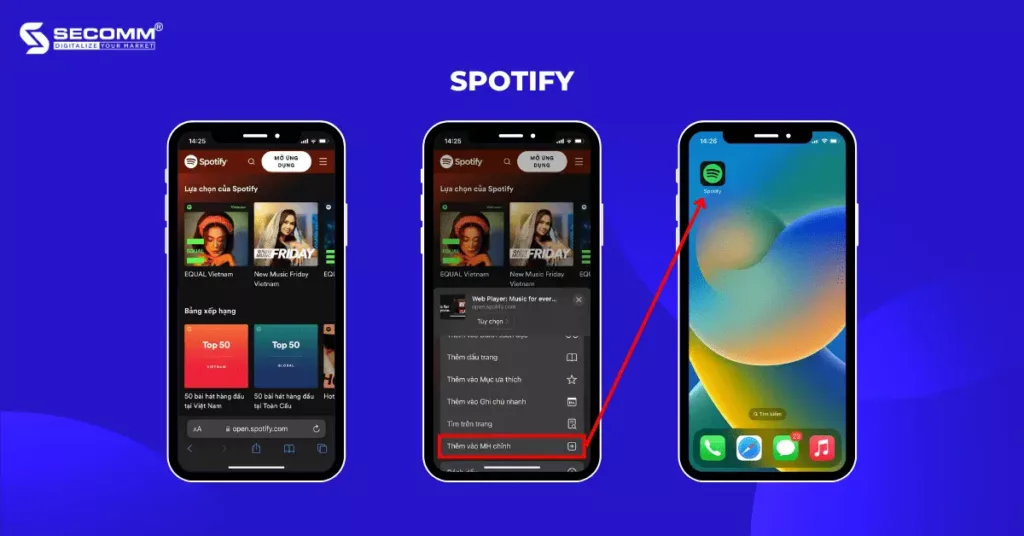
Native app of Tinder has been very effective on many different operating systems and is particularly loved by users. However, with the desire to expand and conquer new markets as well as protect its position as a leading online dating platform, Tinder has built a PWA.
The page loading time of Tinder PWA has been reduced to 4.69 seconds compared to 11.9 seconds before, which significantly increases interaction and surpasses Tinder native app in terms of the number of swipes, profile edits, and time spent per user.
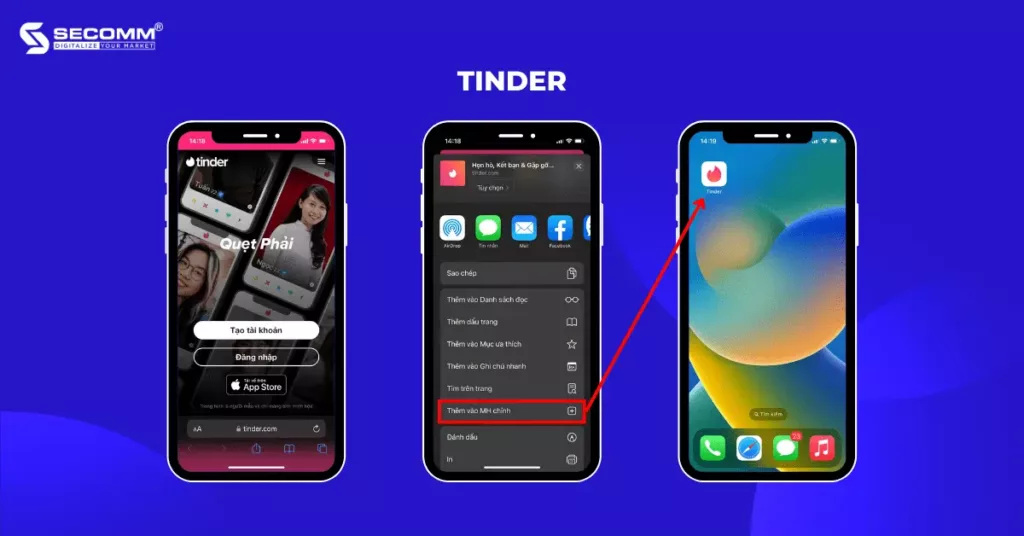
In addition, there are many famous companies in the world that have implemented PWA: Facebook, Instagram, Twitter, TikTok, Uber, Pinterest, Starbucks, Aliexpress, etc.
With years of experience implementing eCommerce solutions for numerous clients in various countries, SECOMM understands the importance of developing PWA to cope with the competition in the billion-dollar technology industry as well as the challenges that each business faces when building and developing PWA.
Contact SECOMM now for a free consultation!
 2
2
 10,104
10,104
 0
0
 1
1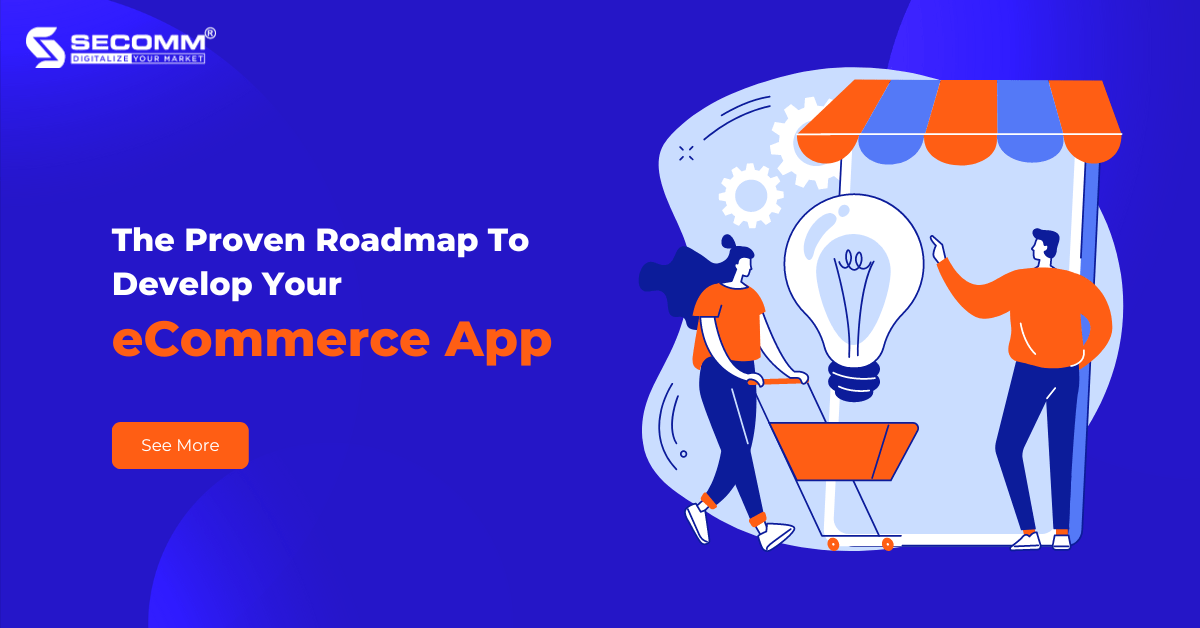
Facing the boom of Mobile Commerce, businesses now have two choices: to build an eCommerce app to adapt to this boom or to ignore it and gradually fall behind.
According to Insider Intelligence’s forecast, mobile commerce market sales will reach $534.18 billion in 2024, of which two devices contributing to this incredible number are smartphones and tablets. Smartphones alone account for 87.2% of mobile commerce sales. These figures are the most convincing answer to the above consideration: Yes, businesses need to build an eCommerce app.
Building an eCommerce app requires a lot of effort and serious work because it is a complex process with many stages and the involvement of many relevant. Below are 8 summarized implementation steps that will help businesses understand the building process of a mobile shopping app to make their business operation more effective.
The first step of the process is to determine the objective of the mobile app, including deciding which products will be sold through the app and identifying the target audience. This way, businesses can build an app that meets their needs and quickly achieves the objective.
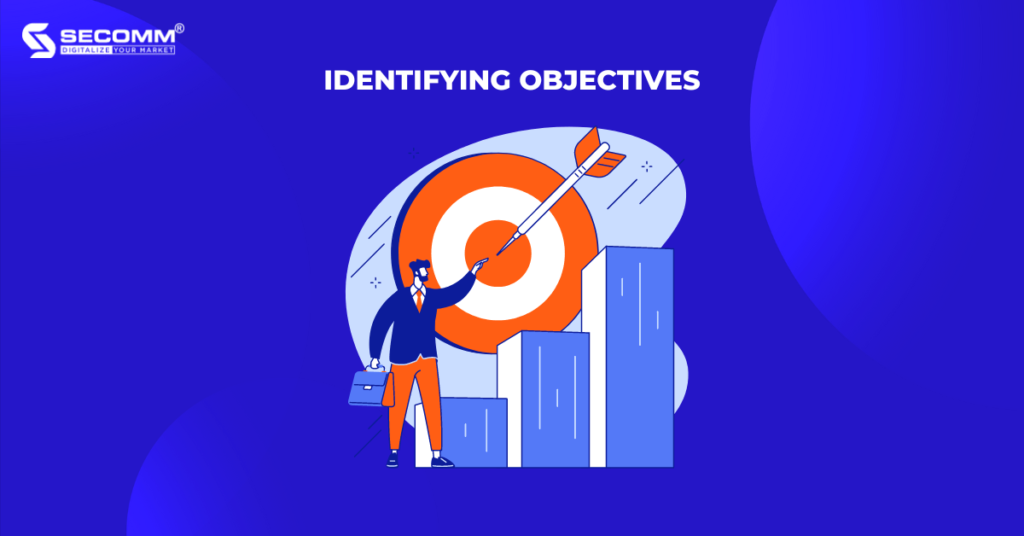
Businesses should do market research to understand their target audience’s needs, preferences, and behaviors in various ways, such as through surveys, interviews, etc. It helps them define the app’s features and the marketing strategies to promote it. Moreover, businesses should find the app’s unique selling points that differentiate it from its competitors, making it easy to attract potential customers and stand out.
After identifying the objectives, the business proceeds to the next step: identifying the vital features of the eCommerce app. Here are some recommendations:
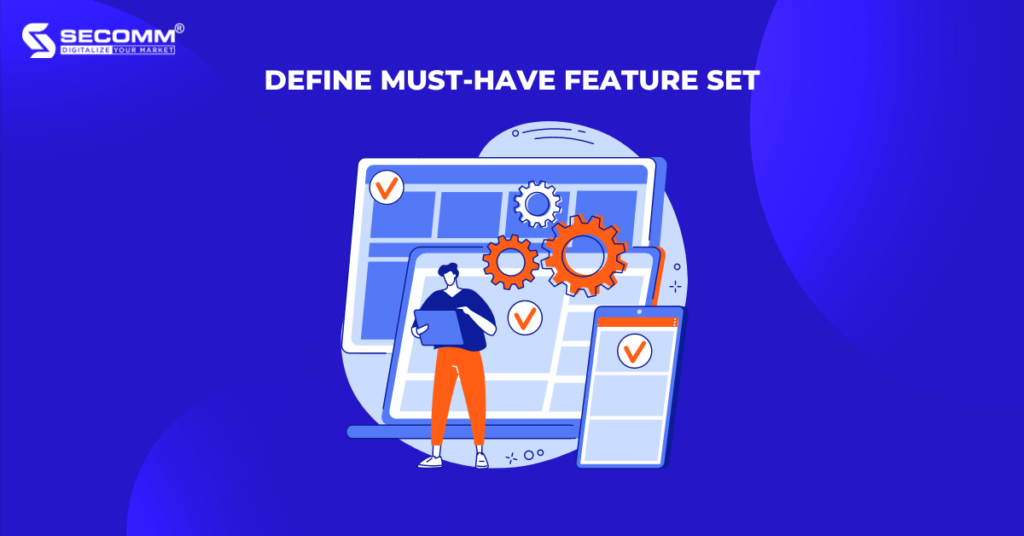
The selection of a platform for building an eCommerce app depends on many factors, including target customers, budget, development stage, necessary features, expansion needs, etc. iOS and Android are two popular platforms in today’s market. In most cases, businesses will build eCommerce apps on both platforms. However, those with limited resources, start with one platform first and then expand to the other later.
Additionally, if a business is targeting customers in the European and North American markets, iOS would be the right choice because iOS dominates these markets. However, because Android has a superior market share in Asia, businesses with plans to penetrate the Asian market should consider choosing Android.
Any business looking to build an eCommerce app will have to choose between a Native app and a Hybrid app. Developing a Native app refers to building a specific app for a specific platform (iOS & Android), using the respective programming languages of the platform – Swift/Objective-C for iOS and Java/Kotlin for Android. Native apps can provide great performance and user experience as they are optimized for the specific platform the app is built on. However, building Native apps can be costly and time-consuming.
Developing a Hybrid app involves building a single app that works on both iOS and Android platforms, using web technologies like HTML, CSS, and JavaScript. Hybrid apps can speed up the development cycle and be less expensive in terms of budget and time compared to native apps. However, Hybrid apps cannot provide the same performance and user experience as Native apps.
Therefore, the choice between developing a Native app or a Hybrid app depends on the budget, development process, and the desired user experience. If the business has a surplus budget to invest in user experience, then developing a Native app is a good choice. However, if the business needs to bring its eCommerce app to the market quickly but has budget constraints, then it should focus on developing a Hybrid app.
Related Reading: Native App & Hybrid App: Key Differences, Pros & Cons
In the next step, businesses decide whether to use an in-house team or collaborate with a specialized agency, which depends on the budget, experience, expertise, and resources. Below are some pros and cons of the two options: In-housing and Outsourcing.
Pros:
Cons:
Pros:
Cons:
The UI/UX design of an eCommerce app refers to creating a visually appealing and user-friendly interface to help users easily search for and purchase products. Here are some suggestions for businesses to consider when designing the UI/UX for eCommerce apps:

In eCommerce app development, MVP stands for Minimum Viable Product, which is typically a condensed version of the app that is launched to the market before the official launch of the full app. Building an MVP for an eCommerce app usually focuses on developing the core features and ensuring those features work effectively before adding additional features.
As listed, the most crucial core features may include a product catalog, search bar, shopping cart, payment methods, etc. When releasing an MVP, the business must ensure that it is error-free and meets the needs of the target customers. The goal of an MVP is to understand the customer’s thoughts on the product, minimize risk, and allocate resources effectively before launching the full product to the market.
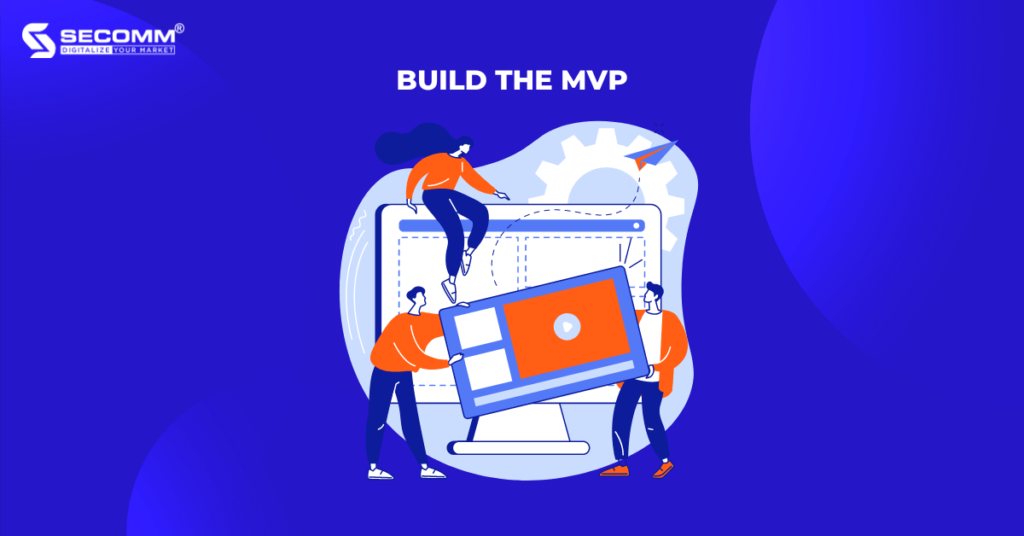
After building and releasing the MVP, businesses should collect feedback from users through various channels such as social media, surveys, or reviews on the App Store or Google Play to gather their opinions on the experience when using the eCommerce app. Moreover, businesses should carefully review the feedback and use it to make decisions about how to improve the app. In particular, they should prioritize the most important issues users are facing and resolve them quickly.
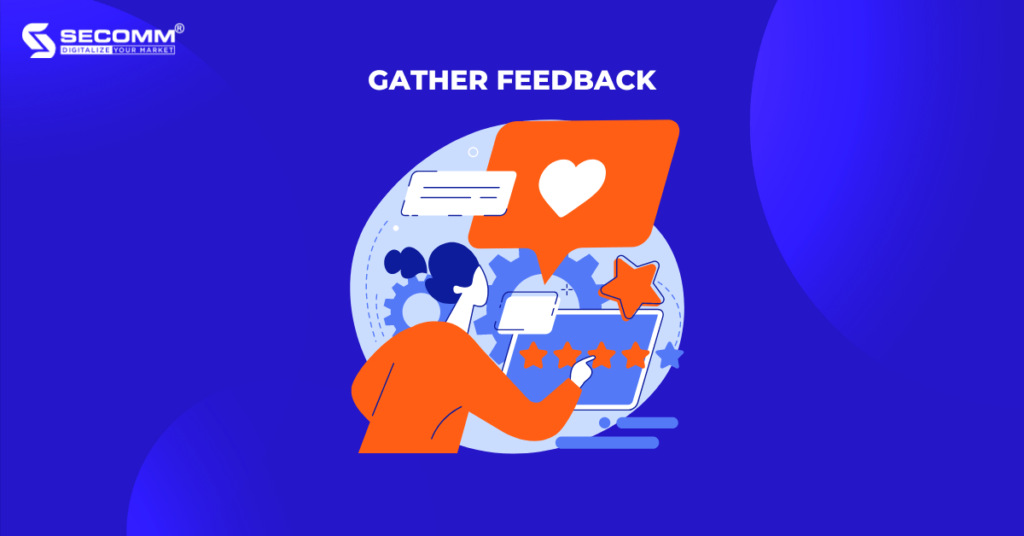
After gathering and reviewing user feedback, businesses can will refine the app and conduct a second round of testing to ensure the app performs well and the improvements have enhanced the user experience. Once the refining and second round of testing is done, businesses can release the product to the market and run marketing campaigns to reach target customers. However, the business needs to closely monitor the performance of the eCommerce app and regularly collect feedback from customers while continuously improving to meet the ever-changing demand of users and maintain a competitive advantage in the market.
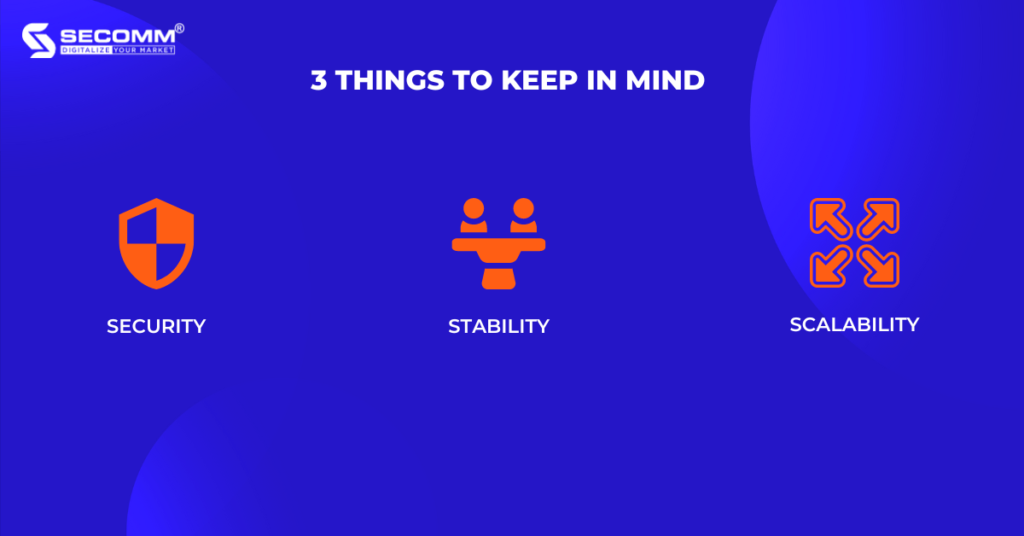
It is a top priority factor that businesses should put their minds to when building an eCommerce application. When users download, register an account, and start using the app, their private data such as login information, personal information, and payment information will be stored on the system. Therefore, businesses should comply with general regulations related to security issues and provide customer information as well as deploy secure payment gateways, and use SSL encryption or two-factor authentication to protect user data of the eCommerce app.
The stability and reliability of an eCommerce app are crucial for a business to provide an incredible user experience. Customers typically prefer apps that run smoothly without any bugs or errors. However, releasing a flawless eCommerce app without any bugs is unrealistic. Therefore, businesses need to conduct thorough testing to identify and fix any issues before launching, while also regularly maintaining and updating the app to improve its performance and prevent or correct any errors that may arise.
This is the ability of an eCommerce app to handle increasing traffic, user volume, and shopping transactions without affecting the performance or functionality of the app. When getting started, businesses should predict the app’s future growth and place to build an app that is easily scalable when necessary. Moreover, businesses need to plan for the addition of advanced features to meet expansion needs.
In summary, security, stability, and scalability are three factors to consider when building an eCommerce app. By focusing on these three factors, businesses can provide customers with a safe, reliable, and scalable app that corresponds to the development of the business.
Above is the general process of 8 steps for building an eCommerce app with some important notes during the implementation. With years of experience implementing eCommerce for businesses from many countries, SECOMM understands the difficulties businesses will face when implementing eCommerce apps.
Contact us today for a free consultation.
 2
2
 4,070
4,070
 1
1
 1
1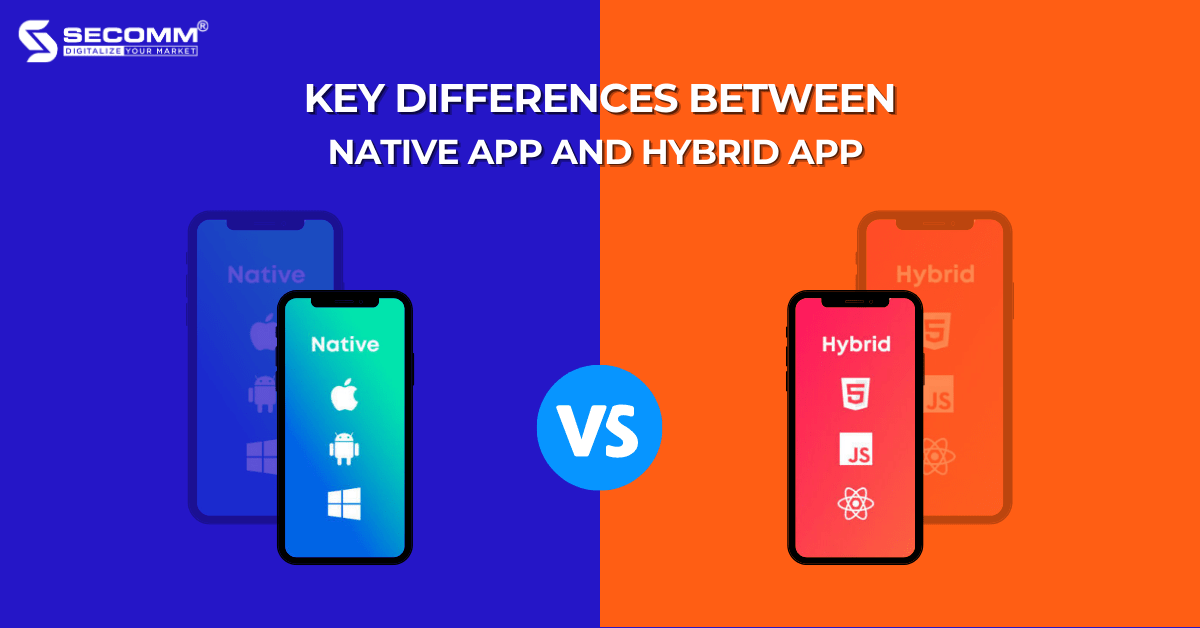
According to Statista, by 2023, there will be approximately 6.9 billion smartphone users worldwide, which will lead to the emergence of mobile apps to enrich user experience. That is why many businesses find ways to build and develop mobile apps to interact with their customers. However, with many platforms and devices around, mobile app development can be a complex and costly process. There are two most popular types of mobile apps including Native Apps and Hybrid Apps.
Both apps have their own advantages and disadvantages, so businesses should consider their demand and resources to choose the right type of app.
Native app is a type of mobile application that is developed specifically for a particular platform or operating system, such as iOS or Android. Native apps use different programming languages depending on the platform they are built on: Objective-C or Swift are the main programming languages for iOS, while Java or Kotlin are the main programming languages for Android.
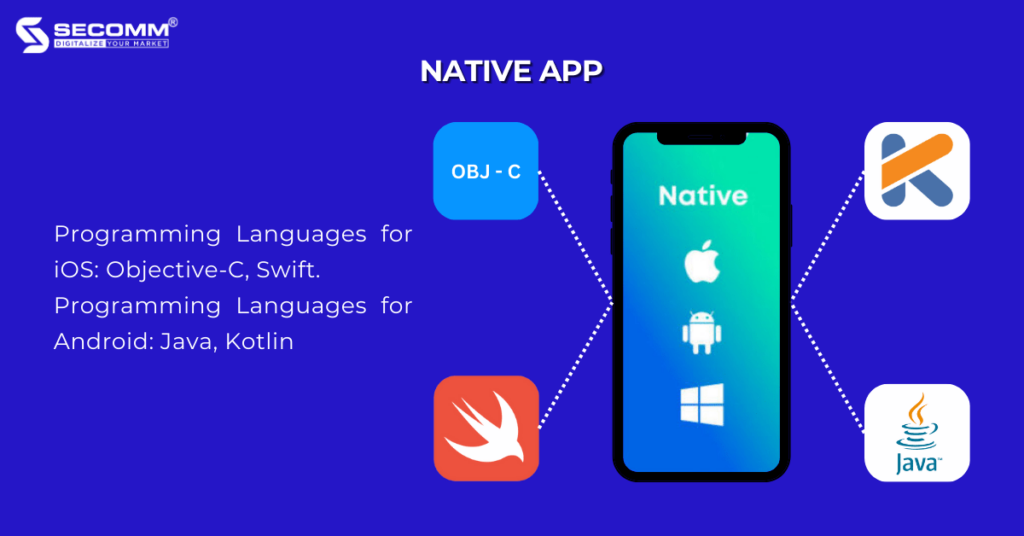
In addition to outstanding advantages, Native apps still have some limitations to be aware of:
Native apps will be suitable for businesses that want to build mobile apps with high performance, diverse features, and a focus on user experience. However, this choice requires a lot of development and maintenance costs, as well as significant time and effort to be put in.
Hybrid app is a type of mobile application built using web technologies such as HTML, CSS, and JavaScript, and then packaged in a Native app container. This allows hybrid apps to run on multiple platforms or different operating systems, including iOS and Android.
Frameworks for developing hybrid apps include React Native, Flutter, Xamarin, and Ionic.
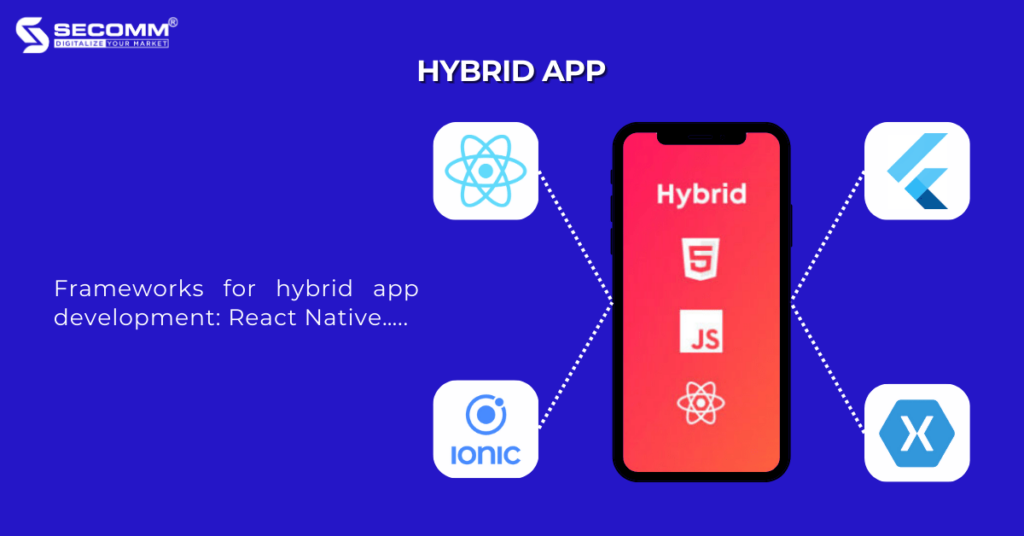
In addition to the advantages mentioned above, hybrid apps also have some drawbacks that businesses need to consider when building them.
Hybrid apps are a good choice for businesses that want to create a mobile app that works on multiple platforms and devices, with a faster development time and lower costs than native apps. However, hybrid apps still have many limitations in terms of performance, user experience, etc. Therefore, businesses should consider this before deciding to build a hybrid app.
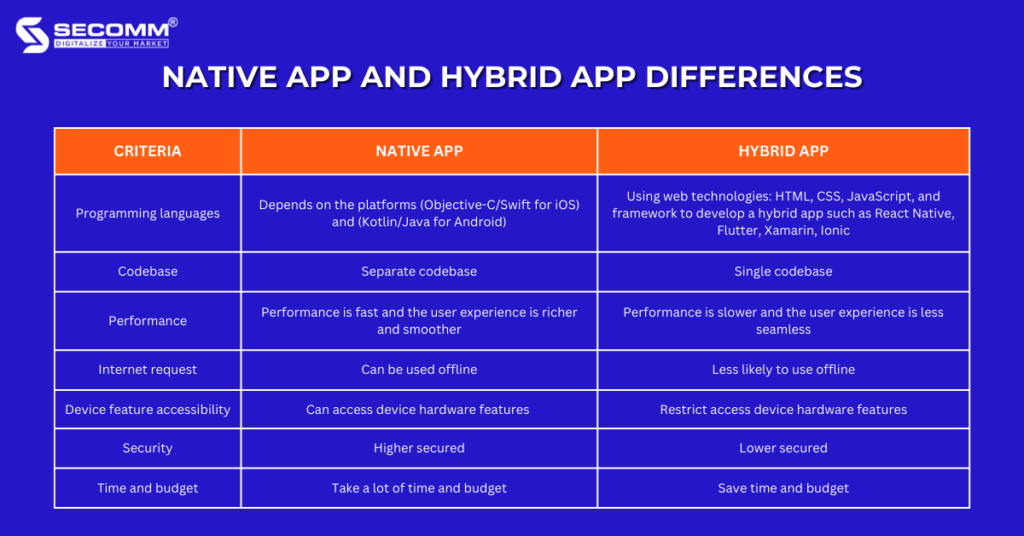
Facing the rapid development of mobile apps, quickly building a proprietary app is an urgent mission for every business. With the set of advantages and disadvantages summarized of the two most popular types of applications today: Native app and Hybrid app, the decision will depend on the purpose of each business.
SECOMM has gained many years of experience implementing eCommerce for many customers in many countries, understanding the difficulties and challenges each business faces when deploying mobile applications.
Contact us today to receive a free consultation.
 2
2
 6,471
6,471
 1
1
 1
1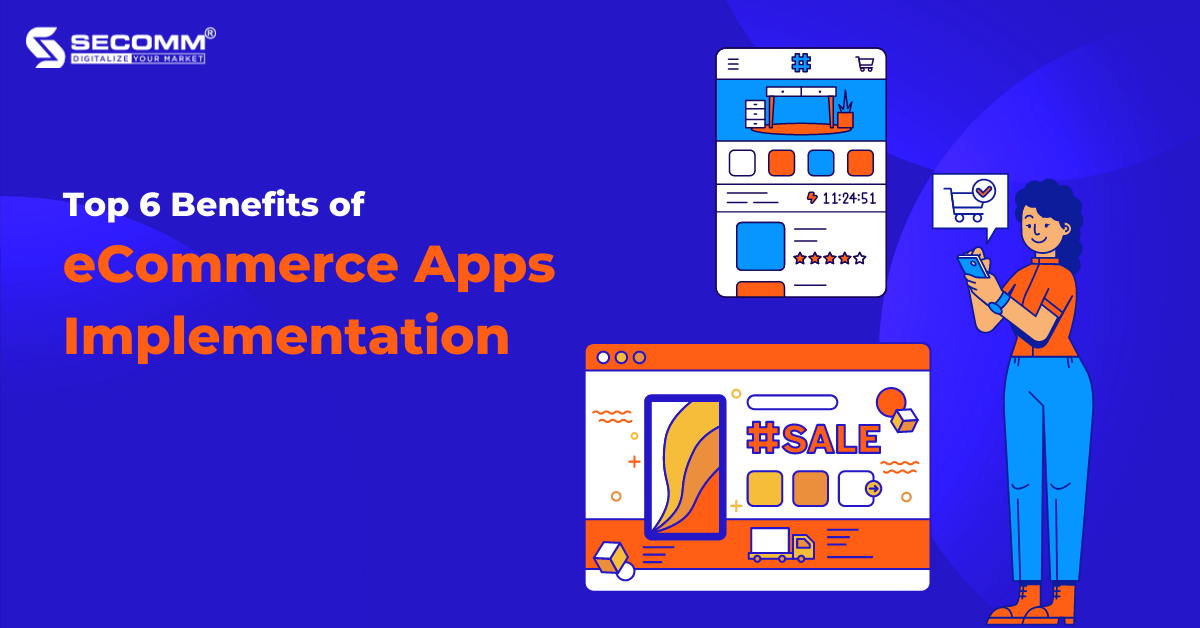
According to data compiled by Forbes Advisor, global Mobile Commerce sales reached $415 billion in 2022 and are expected to reach $710 billion in 2025.
In fact, Mobile Commerce dominates the eCommerce industry, accounting for about 73%, and the use of eCommerce app is growing faster than any other type of app on the market, with an annual growth rate of 54%. This shows that eCommerce app contribute significantly to sales on mobile devices and implementing mobile app is considered the right path for every business in the mobile commerce era.
Increasing brand awareness is one of the benefits that eCommerce app bring to businesses. Since most customers spend hours on mobile devices (e.g smartphones), it’s easier for brands to connect with them through eCommerce app. However, to fully leverage the other capabilities of mobile app, brands need to provide a rich and high-quality app experience. As Statista has noted, about 32%-34% of app users will uninstall if the app is difficult to use or has too many unwanted ads.
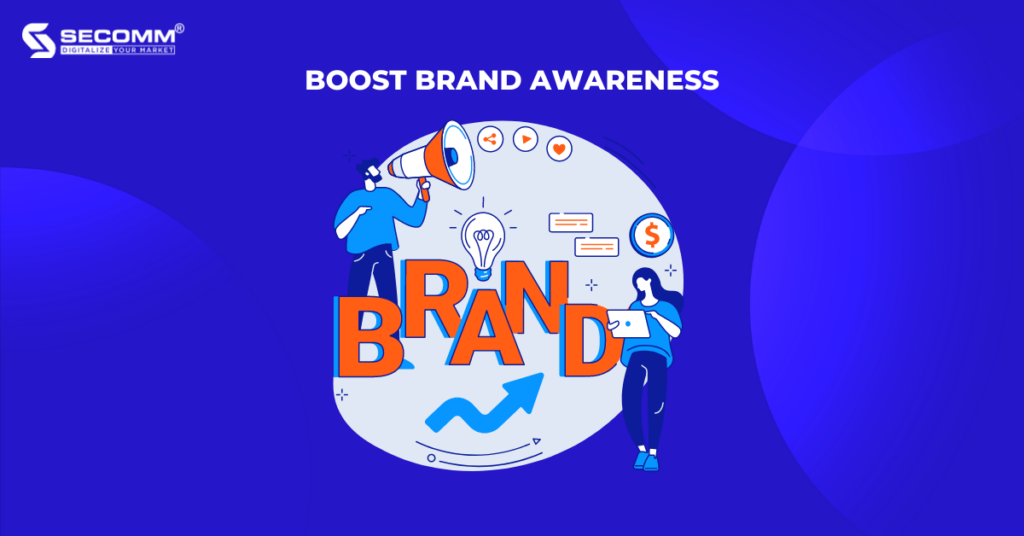
eCommerce websites help deliver personalized shopping experiences with algorithms and support tools but eCommerce apps enable businesses to offer personalized special incentives or promotional programs right in the app without having to access the websites via browsers on desktop or mobile. As a result, among various methods, business owners can combine push notifications, and instead of sending the same push notification to all app users, they can send personalized notifications based on user behavior.
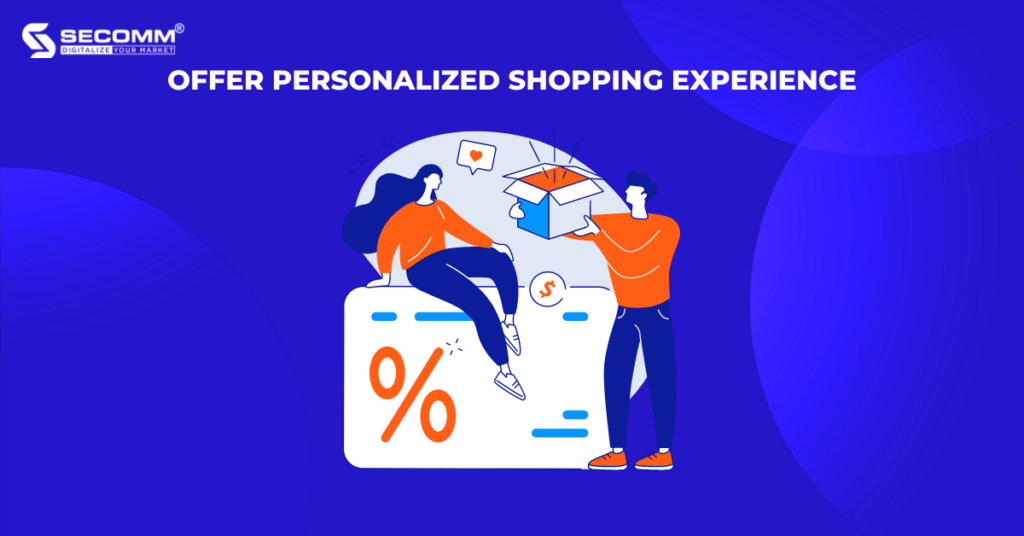
As mentioned, customers tend to love and prioritize shopping on eCommerce mobile app instead of eCommerce mobile web. Therefore, the conversion rate of the mobile app will be higher than that of the mobile web. The graph below indicates the different conversion rates between the mobile app and mobile web.
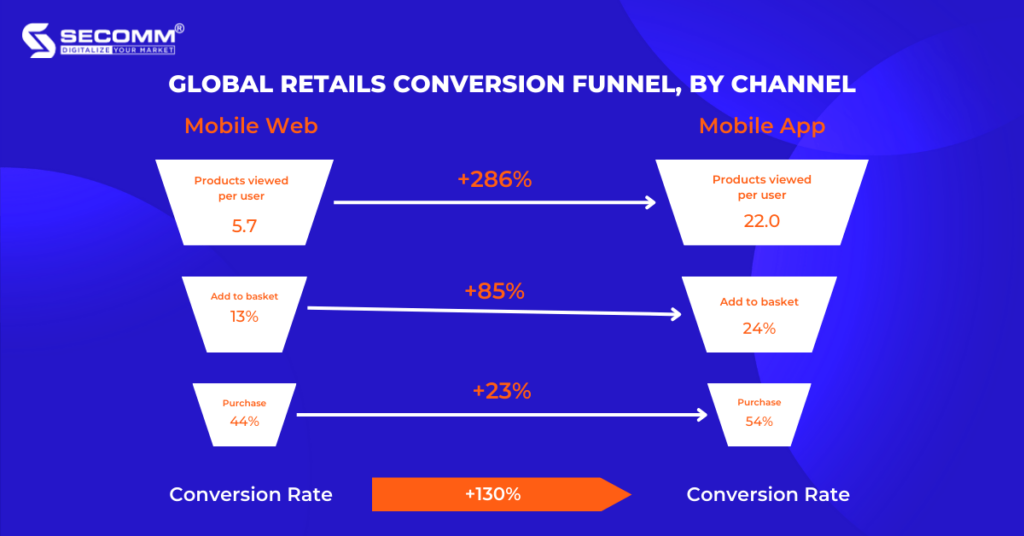
Mobile app users view products more than 286% and add items to the cart at a higher rate of 85% compared to mobile web users. Moreover, the graph shows that the conversion rate of mobile app is over 130% higher than that of the mobile web. Naturally, when the conversion rate increases, it will lead to an increase in sales revenue and profits.
Building an eCommerce app not only boosts brand awareness, enhances customer experience, and improves conversion rate but also increases the average order value (AOV). This is the average dollar amount customers spend each time an order is placed on the app.
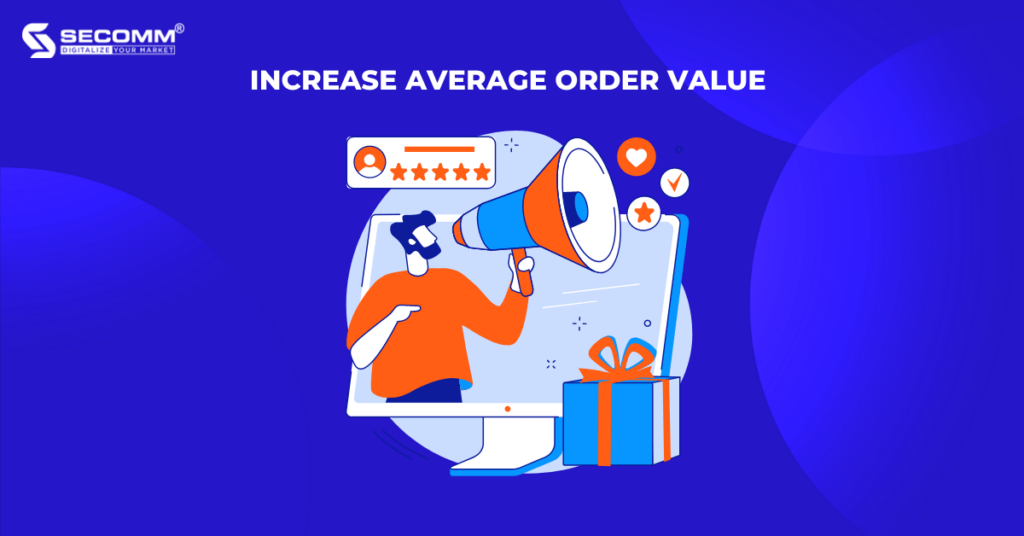
Customers prefer shopping on eCommerce app because it’s convenient for them to browse through products and make purchases. Therefore, they have more opportunities to browse through a wider range of products. This enables businesses to apply cross-selling and upselling techniques, suggesting complementary products to encourage customers to make additional purchases. As a result, the increased AOV drives up revenue and profits.
Some data on cart abandonment has been reported by Ruby Garage:
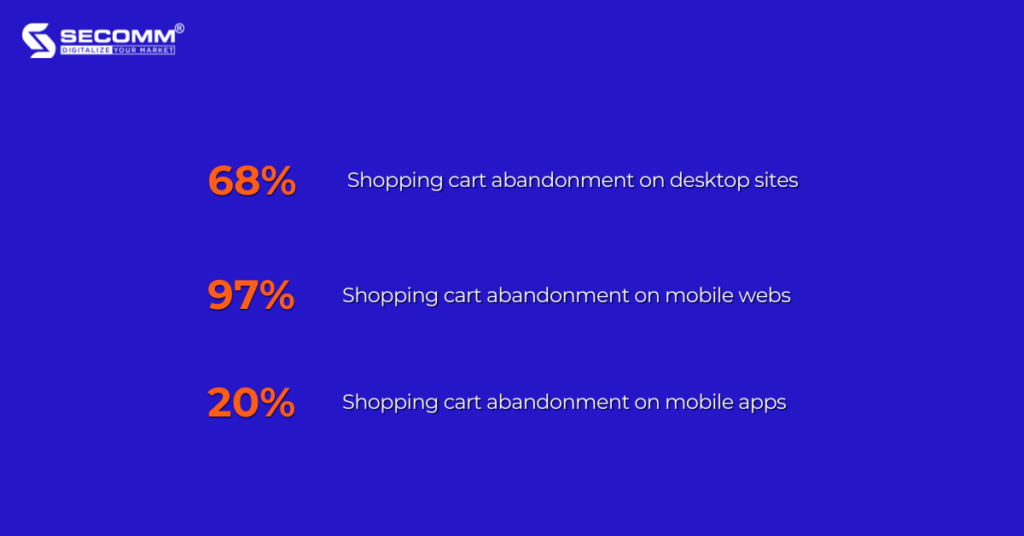
One of the top reasons for that is the long and confusing checkout process. Mobile shopping app will help businesses reduce cart abandonment with the optimized checkout process. When customers buy products, relevant information will be stored in the app’s system, so they don’t have to re-enter their information but complete the purchase with a few taps. In addition, businesses can also shorten the checkout process to improve cart abandonment rates by integrating various payment methods into the shopping app.
For every eCommerce business, increasing sales revenue is a valuable achievement. However, it’s crucial to point out how many regular customers contribute to this success. According to the Harvard Business Review, the cost of acquiring a new customer is more expensive than retaining and satisfying an existing one, ranging from 5-25 times higher. But, if the customer retention rate increases by just 5%, profits can increase from 5% to 95%. As a result, businesses need to put their minds to existing customers.
There is a 50% chance that customers will return to a shopping app within 30 days of their last purchase. In other words, businesses can increase customer retention and loyalty with their mobile app in several ways, including
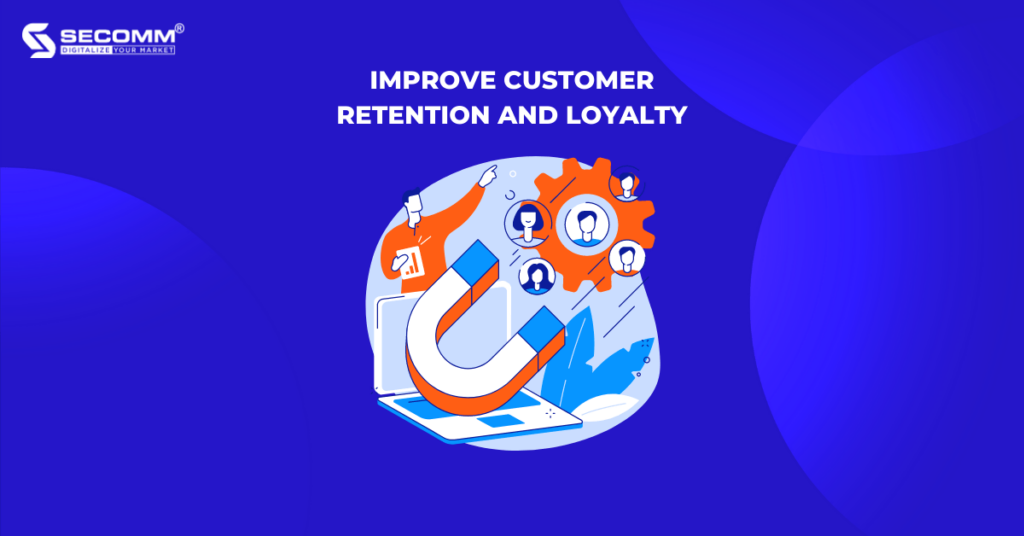
With the incredible benefits of mobile app, businesses are increasingly motivated to quickly build their app to enrich the customer shopping experience while capturing the Mobile Commerce trend.
With years of experience in implementing eCommerce for many businesses in many countries, SECOMM understands the difficulties and obstacles in developing your mobile shopping app.
Contact us today for free advice.
 2
2
 2,811
2,811
 0
0
 1
1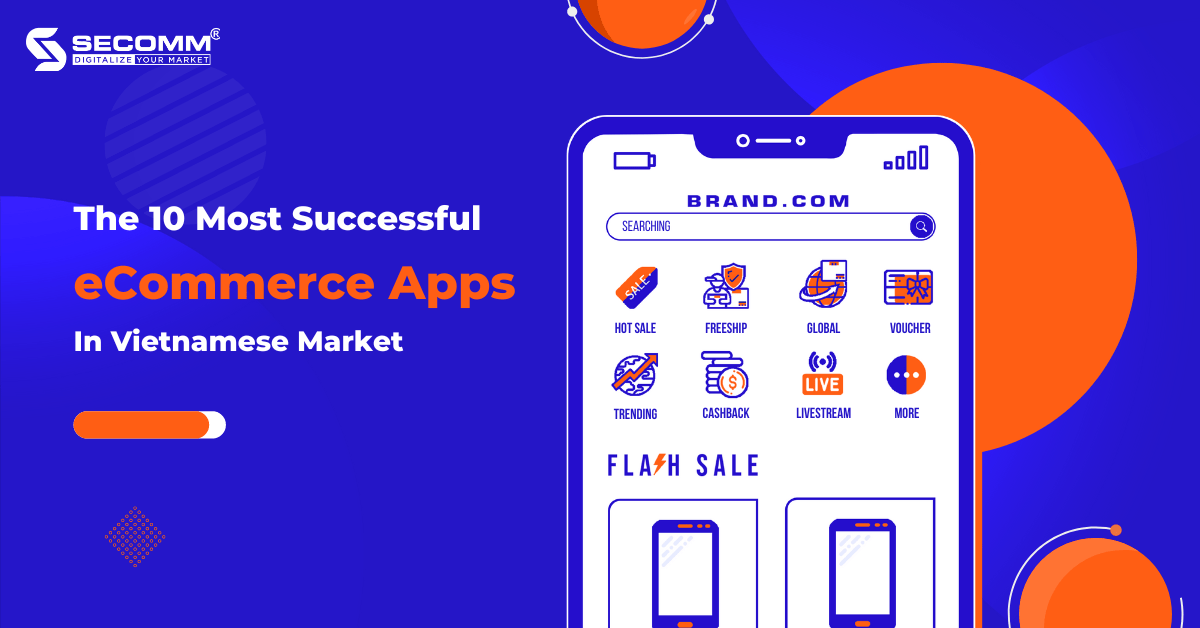
The significant increase in the number of smartphone users has contributed to the rise of Mobile Commerce trends worldwide, including in Vietnam. It’s time for retailers to focus on supporting their customers in searching and shopping through mobile devices, in addition to eCommerce websites.
Many businesses across various sectors, from shopping, healthcare to food, have performed very well in this strategy by becoming pioneers in embracing Mobile Commerce trends in Vietnam.
The SHEIN app is known as one of the most successful eCommerce apps in the world today, and now it has become the most downloaded mobile app in the shopping category in 2022 with 229 million downloads and installs from both Google Play and the App Store.
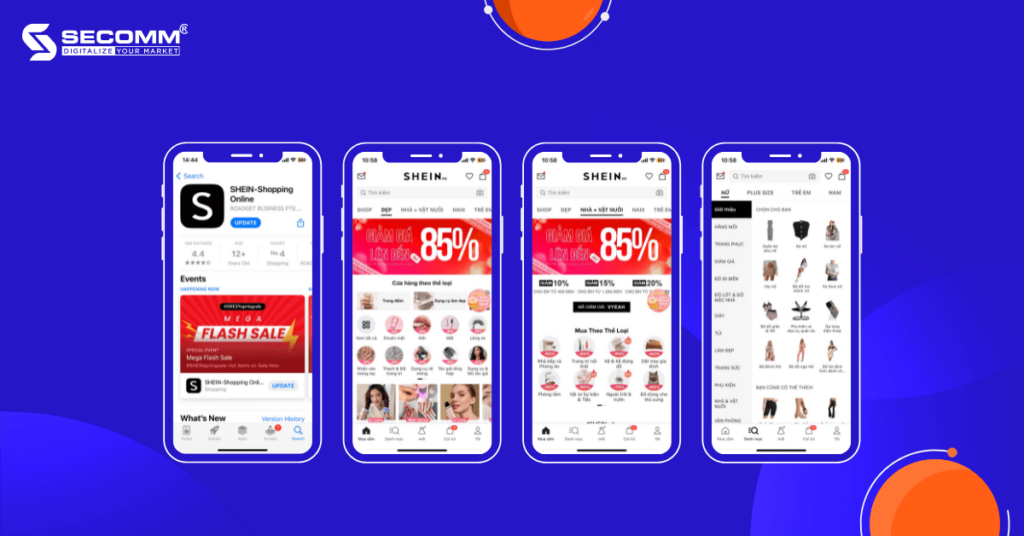
In the Vietnamese market, SHEIN is also highly rated by users for their shopping experience on the app. In the latest update, SHEIN added a discount program for some fashion items of up to 70%, as well as fixing some bugs and improving performance to provide users with a better experience.
Download the SHEIN app: Google Play | App Store
When entering the Vietnamese market in 2019, Uniqlo quickly captured and responded to the local consumers’ fashion shopping trends, which made the brand very popular. The Uniqlo VN app stands out with many necessary functions for a consistent shopping experience between mobile devices and other channels. In order to attract more users, Uniqlo will offer a 150,000 VND discount voucher for anyone who downloads the app and signs up as a new member.
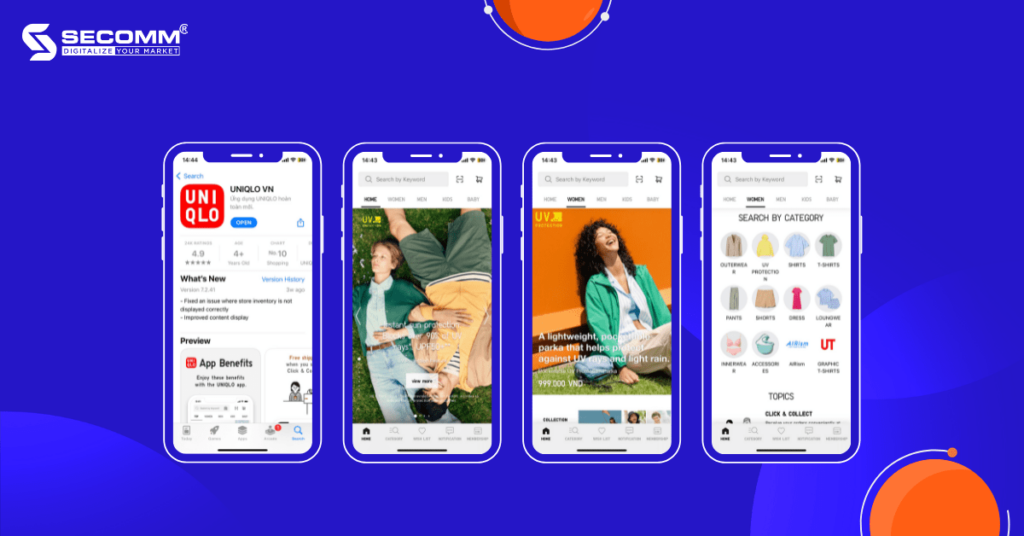
Although the Uniqlo VN app is highly rated for user experience, the brand still keeps updating and improving its features. In the latest update, Uniqlo has improved the quality of product image display and adjusted the accurate display of the number of products available in-store.
Download the Uniqlo VN app: Google Play | App Store
Hasaki not only has nationwide brick-and-mortar stores and an eCommerce website but also develops a mobile app to offer its customers enriched shopping experiences and attractive incentives.
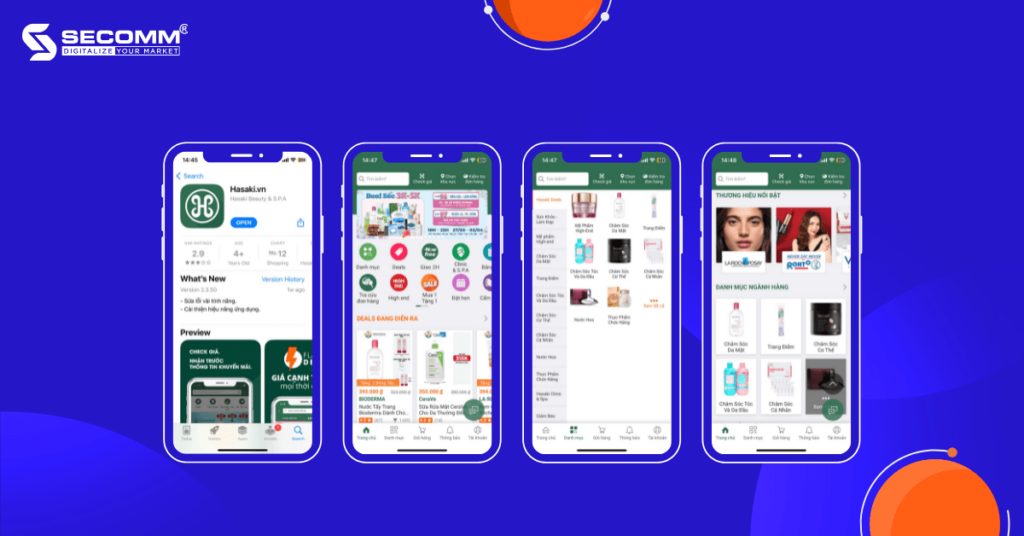
By using the Hasaki app, customers can conveniently search and purchase products anytime, anywhere, track their order status, and make appointments for spa and clinic services at the store. One thing that makes Hasaki special is the free delivery within 2 hours for all customers, whether shopping at the store, eCommerce website, or mobile app. Despite getting much critical feedback for usage quality, Hasaki is still very receptive, fixing bugs and optimizing performance in the recent updates.
Download the Hasaki app: Google Play | App Store
After rebranding, the Big C supermarket chain has been renamed Go!. As a result, the mobile app of this business is now called Go! & Big C. Customers who shop on the app will enjoy many benefits, including:
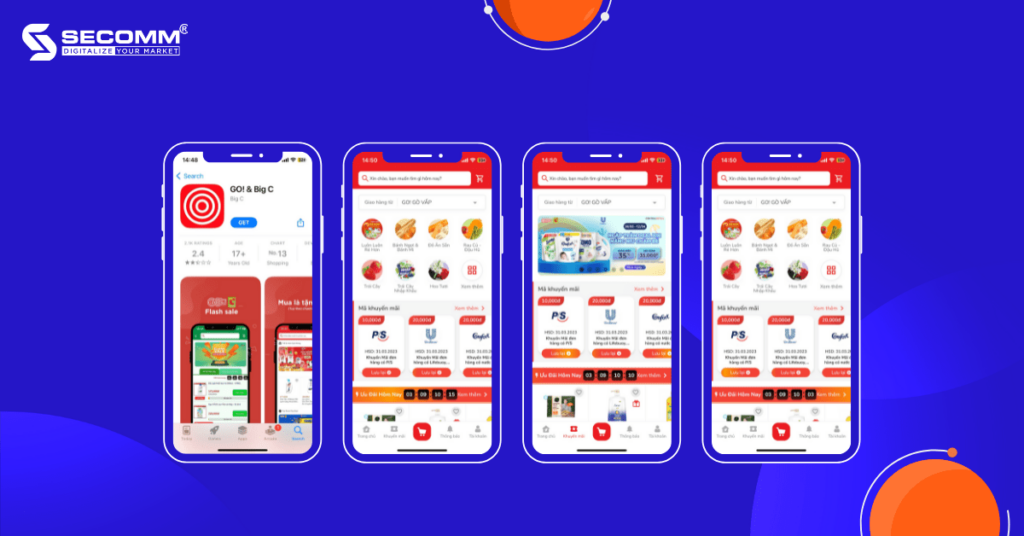
The Go! & Big C app is regularly updated to improve the online shopping experience for customers. In the most recent update, the developer has improved the payment function, fixed bugs, optimized performance, and image display capabilities.
Download the Go! & Big C: Google Play | App Store
Con Cung is one of the first childcare brands to develop its mobile app to provide customers with a consistent shopping experience across different channels, including physical stores, mobile apps, and eCommerce websites.
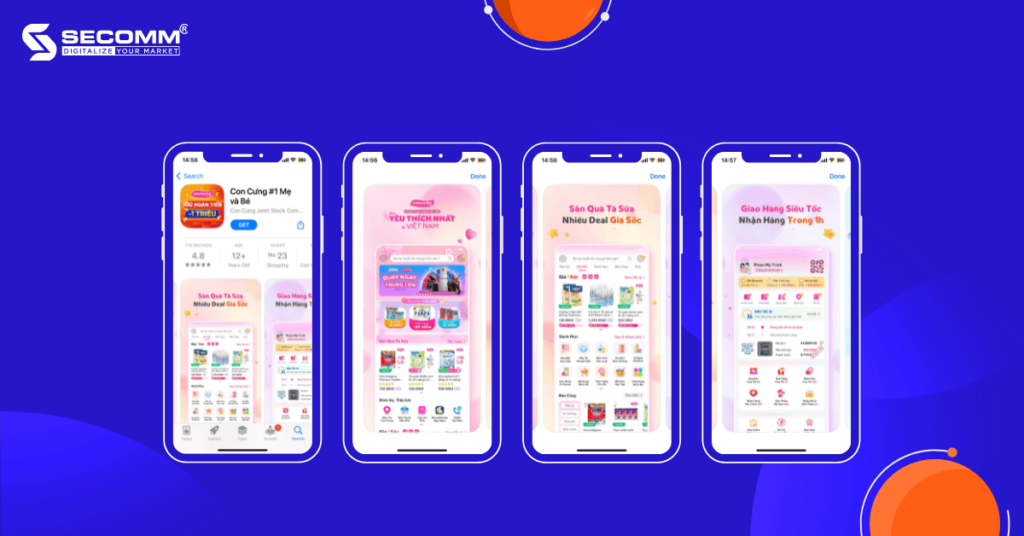
The Con Cung app has received very positive reviews from users on both Google Play and App Store for user experience, product quality, and promotional programs. However, the brand still maintains the practice of testing and improving certain features such as displaying detailed driver’s information when customers place orders for the 1-hour delivery service and fixing bugs related to payment via eWallet.
Download the Con Cung app: Google Play | App Store
Dien May Xanh is a big player in the Vietnamese home appliance industry that has successfully captured the market trend and quickly developed a mobile app to reach the huge smartphone user base in Vietnam – approximately 69 million users.
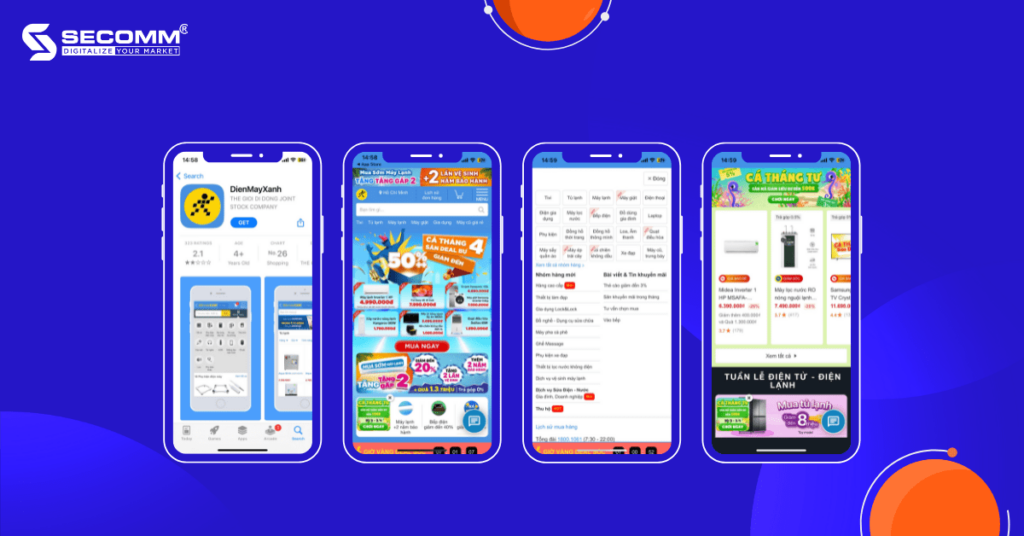
In addition to massive promotional programs on special occasions, Dien May Xanh also provides customers with discounted payment programs using various methods such as Buy Now Pay Later, QR Code, etc. All of these are carried out quickly and easily both on the website and the mobile app.
Download the app: Google Play | App Store
The Vietnamese mobile commerce market has witnessed the entrance of another famous cosmetics retail brand, LixiBox. Similar to Hasaki, LixiBox also continuously updates its app to enhance the shopping experience of customers.
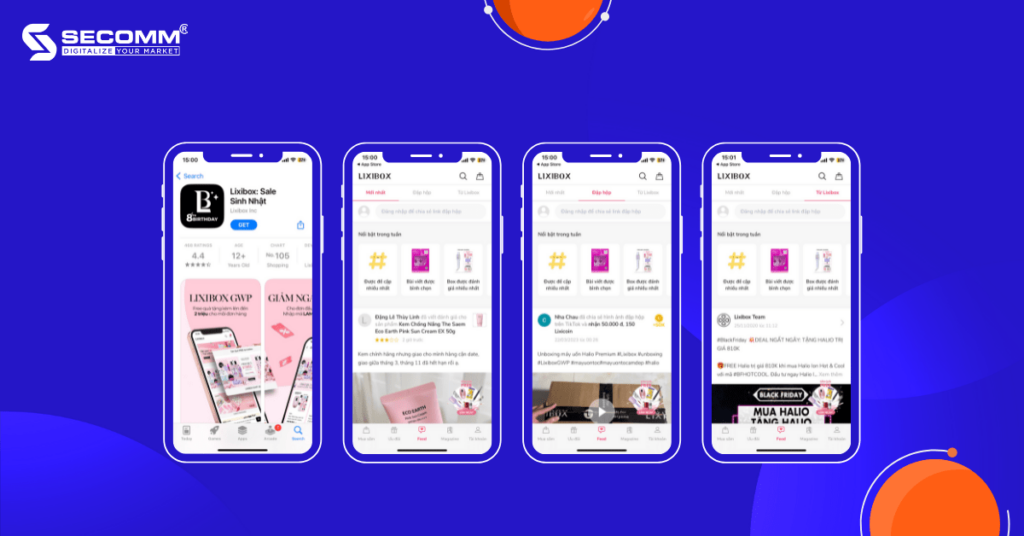
Moreover, the brand offers many special incentives to attract users such as a 20% discount for the first order placed on the app, a referral program where customers can receive 500,000 VND, a magazine section where users can update the latest beauty trends right on the app, and a LixiBox Feed section where customers can share their experiences on products and services.
Download the LixiBox app: Google Play | App Store
When the Long Chau mobile app was launched during the Covid epidemic, it quickly received support from customers everywhere because they could buy medicine and healthcare products online and have them delivered to their door, while also earning reward points for their next purchase. In addition, the app has a call and message feature that allows users to contact pharmacists online for free in-depth advice and support. Furthermore, Long Chau is the first pharmacy to pioneer the Buy Now Pay Later service with 0% interest, helping patients and customers find a new convenient way to make purchases.
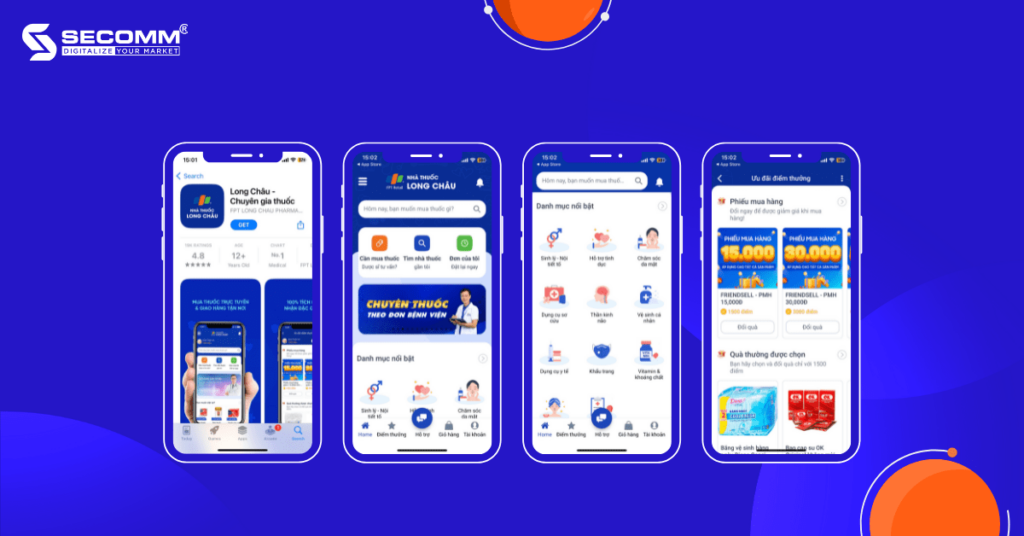
User experience is a particularly important factor that Long Chau focuses on, and the app regularly releases updates. These updates include optimizing the login function, improving the payment function, integrating payment via eWallet, synchronizing order status on the website and app, suggesting reordering, and more.
Download the Long Chau app: Google Play | App Store
Pharmacity is a mobile app developed by the convenient pharmacy chain – Pharmacity in 2018. Similar to Long Chau, the Pharmacity app was created to provide customers and patients with a convenient and fast shopping experience, along with online consultation services from a team of highly specialized pharmacists.
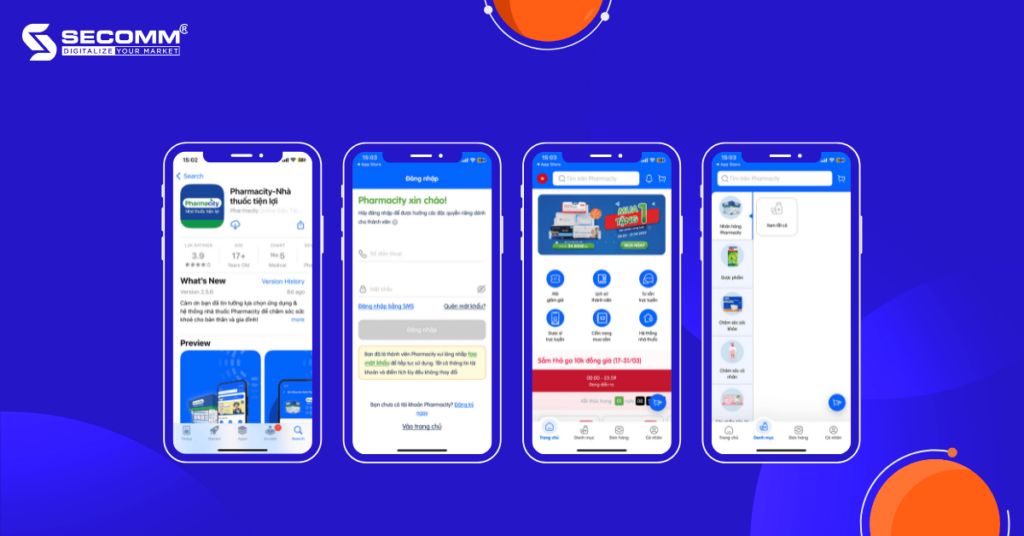
In its latest update, Pharmacity has improved and added some features, including a gift program for first-time users who download the app and sign up as members.
Download the Pharmacity app: Google Play | App Store
In 2021, the famous beverage brand The Coffee House officially launched its mobile app with the same name, aimed at providing customers with the experience of ordering drinks for delivery or picking up at the store, along with many reward point programs for attractive incentives.
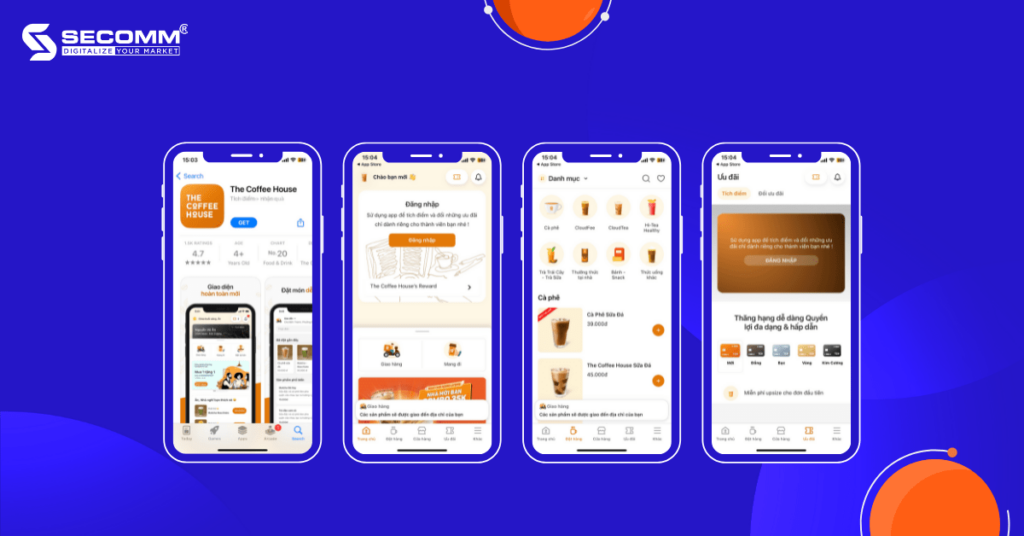
After two years of development, the new version of The Coffee House app features a completely new interface and many special features designed to enhance the customer experience both on the app and at physical stores.
Download the app: Google Play | App Store
Mobile eCommerce apps are one of the rising trends in mobile commerce. As a result, developing mobile shopping apps is the first smart move to achieve sustainable growth in the booming era of mobile commerce.
Contact SECOMM now for advice on how to implement and develop the best strategies to dominate the Mobile Commerce market.
 2
2
 6,878
6,878
 0
0
 1
1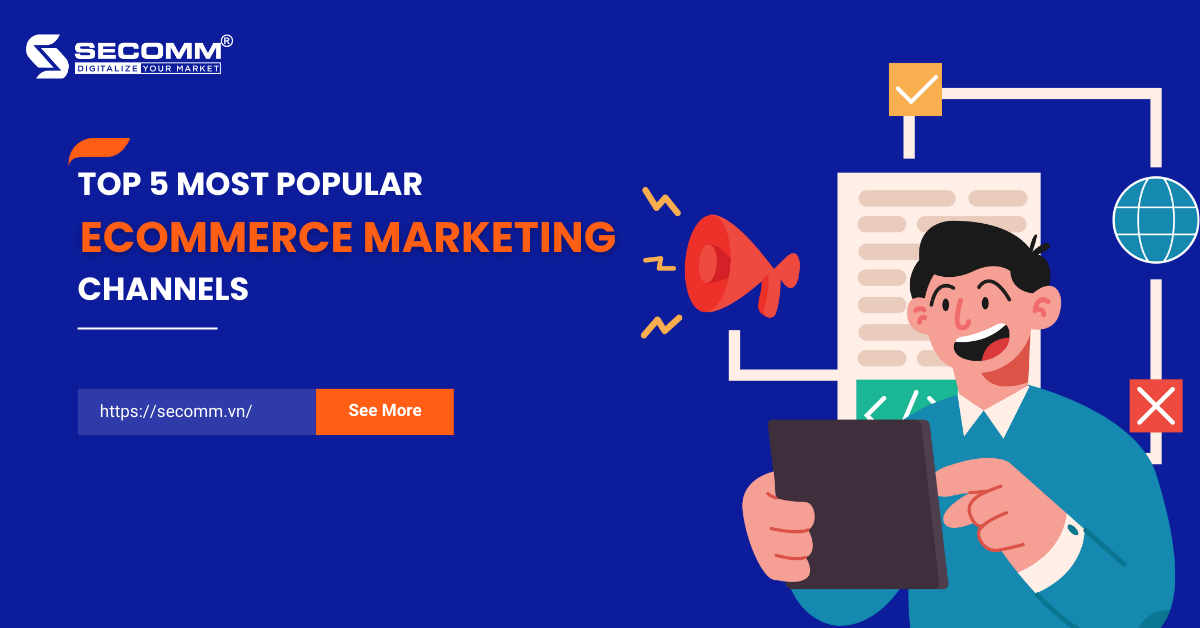
The global pandemic has created an unprecedented boost for the eCommerce industry, forcing business leaders to go for digital transformation whether they want to or not. However, there are still many businesses that are hesitant and encounter difficulties while embracing it.
In addition to selecting an eCommerce platform and building a website, they can leverage incredible marketing channels to develop an eCommerce marketing strategy.
eCommerce Marketing, also known as Electronic Commerce Marketing, is the practice of using various marketing channels such as social media marketing, content marketing, SEO, or email marketing to increase the efficiency of eCommerce operations. To be more specific, eCommerce Marketing does the following:
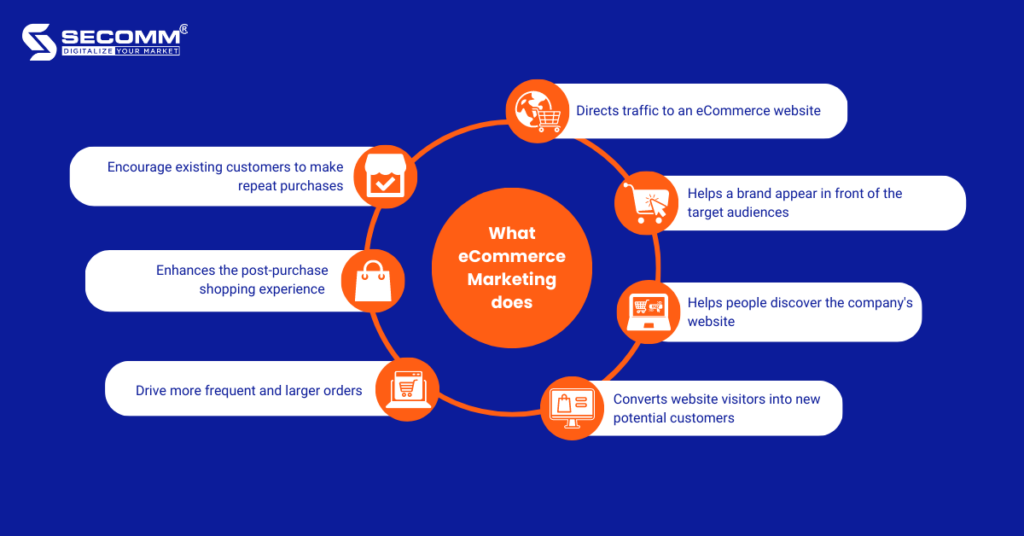
The purpose of eCommerce Marketing is to enhance brand awareness and boost sales. Therefore, if a business doesn’t have an eCommerce Marketing strategy, then it’s really hard for their eCommerce website to generate conversion despite the beautiful interface and well-built functional system.

Currently, most brands and content creators take advantage of the popularity of social media as the first step for connecting and serving their target audience with content that interests them. eCommerce businesses can do the same by using engaging content and images to grab the audience’s attention and direct traffic to their website.
In this case, the eCommerce website interface must have a high level of visual appeal, especially showcasing prominent products to create inspirational shopping. Moreover, businesses can implement social commerce to directly sell products on social media platforms like Facebook, Instagram, TikTok, and so forth.
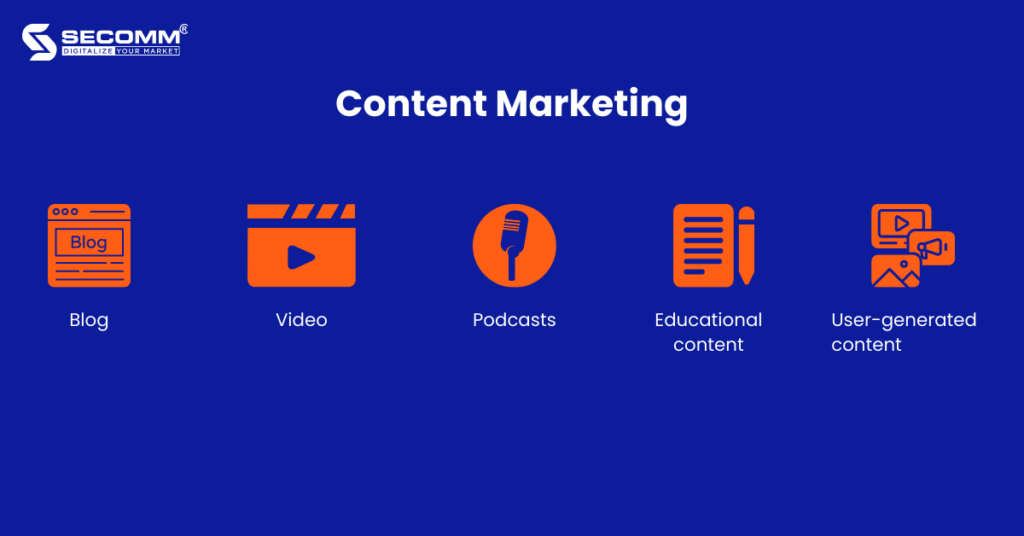
This is an effective marketing channel that brings long-term results for eCommerce businesses as well as a sustainable branding tool for their brands. Currently, various types of content are widely used, including
The goal of content marketing is to answer questions, provide information, promote the brand, suggest and guide customers in choosing products, and even entertain them. With optimized content, customers will quickly find out the website and the business can increase the conversion rate. Moreover, the business can leverage that content for the next eCommerce marketing campaigns.

SEM includes both Search Engine Optimization (SEO) and paid advertising. While SEO requires marketers to understand Google’s ranking algorithm to optimize their content to meet Google’s evaluation criteria, SEM relies on various campaigns such as pay-per-click (PPC) campaigns, display campaigns, or product advertising campaigns like Google Shopping Ads.
On Google, PPC campaigns ensure that potential customers will see the link leading to the brand’s website when they enter search terms that match the selected campaign keywords. That is the reason why eCommerce businesses frequently utilize Google Adwords and run PPC campaigns to advertise their product pages.
This way enhances the chances of searchers clicking on the link and making a purchase decision before leaving the eCommerce website, leading to a notable increase in conversion rates.

A reliable influencer can be a brand’s ‘best friend’. The introduction or endorsement of an influencer can help businesses quickly increase sales, optimize marketing ROI, and raise brand awareness. In addition, Influencer Marketing leverages the trust in an individual’s persuasive abilities and self-confidence to influence and encourage their followers to make purchasing decisions.
Influencer marketing is a highly effective eCommerce marketing channel in that eCommerce brands are more likely to continually find ways to collaborate with influential individuals to drive recognition and emotional shopping for specific products or services

This is one of the oldest categories of Digital Marketing. Today, in the eCommerce world, email marketing still plays a very special role that enables businesses to automate campaigns toward targeting subscribers from different segments or stages in the customer journey
However, businesses should be careful in selecting and categorizing the target groups in their email list, to send the right content to the right target audience. This way, businesses can maintain the trust of potential customers at a time when privacy and personal data security have become increasingly important to Internet users.
Therefore, they should be cautious in building their email list if email marketing is a part of their eCommerce marketing strategy.
With all things considered, if there is no eCommerce Marketing, eCommerce websites are virtually unknown. The only way for a website to gain brand recognition, attract more online customers, and generate consistent and regular revenue is to effectively implement target marketing activities.
With a wealth of experience successfully implementing eCommerce for many customers in various countries in recent years, SECOMM understands the difficulties and obstacles businesses face when undertaking tasks related to eCommerce marketing strategy.
Contact SECOMM today to receive free support and consultation.
 2
2
 4,735
4,735
 0
0
 1
1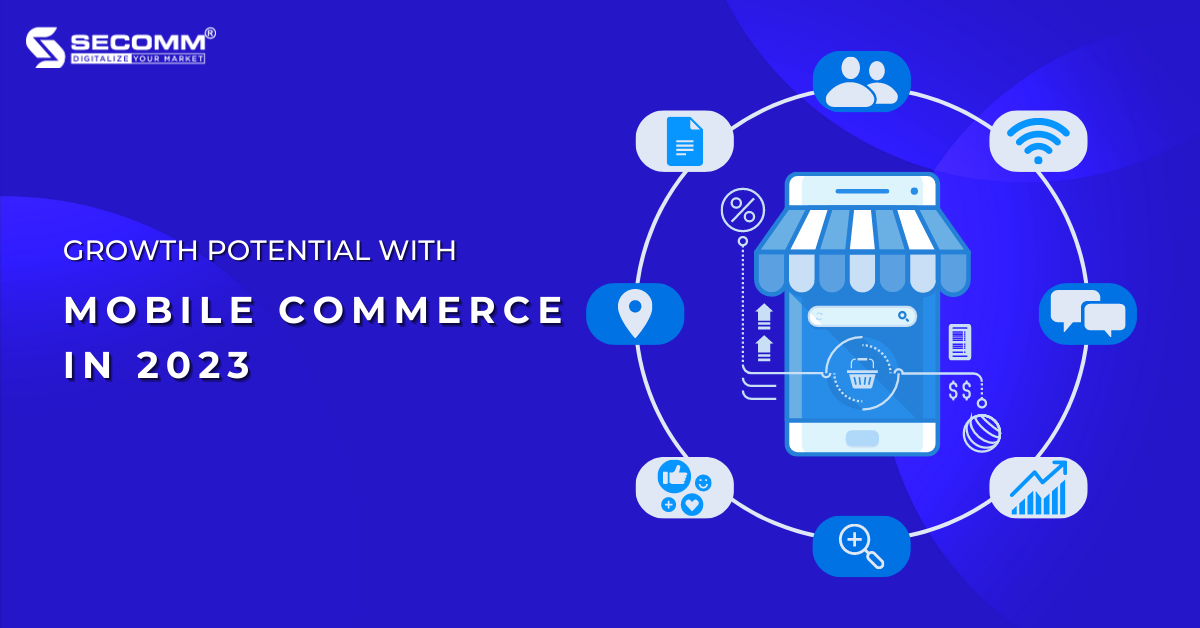
According to the latest data compiled by Statista, as of January 2023, the number of global smartphone users is 6.92B people, increasing by 4.2% annually. In Vietnam alone, this number is around 69 million users, whereas, in the US, Pew Research Center estimates that about three-fourths of Americans own a smartphone. These data demonstrate that smartphones have become common devices, and the demand for owning and using smartphones is significantly increasing.
In addition, the Internet has long ceased to be a high-end infrastructure for countries. Therefore, people today tend to prioritize using mobile devices like smartphones to browse the web.
Typically, Brands tend to establish a strong presence in areas with a wide pool of potential customers, so the emergence of Mobile Commerce quickly gained acceptance and became one of the key business strategies of many enterprises.
Moreover, the appearance of the Covid-19 pandemic in 2020 became a great boost for eCommerce in general and Mobile Commerce, in particular, to explode strongly.
During that period, the smartphone became the shopping companion of users as 79% of users used their smartphones or other mobile devices to shop online, as reported by OuterBox. Despite the eventual end of the pandemic, the Mobile Commerce growth trend is projected to continue as mCommerce retail sales hit $415 billion in 2022, and are predicted to reach $710 billion by 2025.
Mobile Commerce or Mobile eCommerce, abbreviated as m-commerce or mCommerce, is also known as Thương Mại Di Động in Vietnamese. This term was first coined and used by Kevin Duffey at the Global Mobile Commerce Forum in 1997, which means “providing direct eCommerce capabilities to consumers, anywhere, through wireless technology”.
Simply put, it is a business model in which all online monetary transactions are conducted on mobile devices such as shopping, banking, eWallet transactions, ride-hailing, food delivery, hotel reservations, etc.
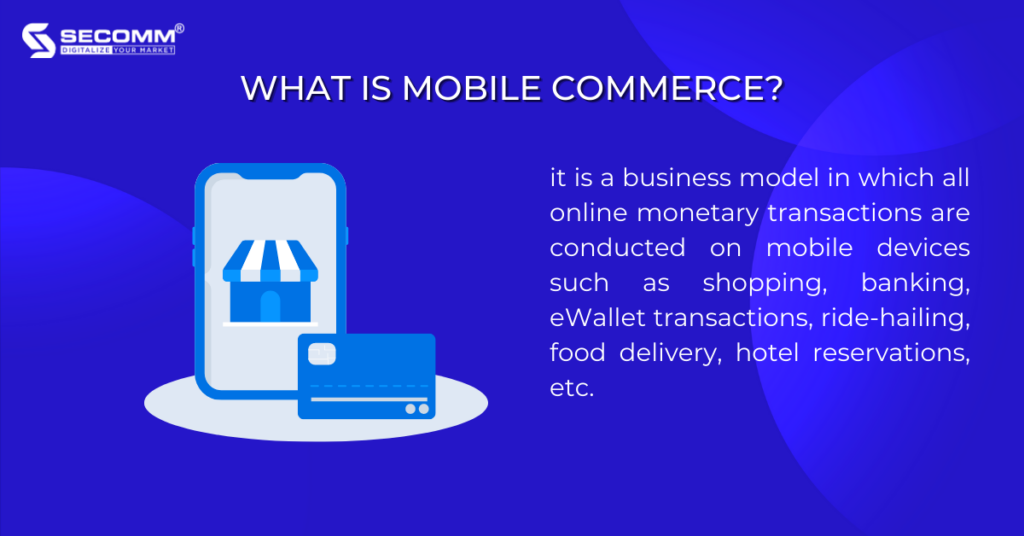
eCommerce or electronic commerce is a relatively broad concept that refers to the buying and selling of goods and services over the Internet. Meanwhile, Mobile Commerce is a branch of eCommerce or the mobile version of eCommerce, specifically referring to electronic commerce transactions carried out on mobile devices.
Furthermore, the eCommerce shopping experience depends heavily on desktops and websites, making it less mobile-friendly and inconvenient for customers. On the other hand, with Mobile Commerce, customers can easily bring their devices with them anywhere, allowing businesses to provide personalized shopping experiences that help customers make quick purchasing decisions.
Thanks to the popularity of smartphones in every consumer’s life, related trends are on the rise such as mobile shopping, mobile payment, and social commerce.
Mobile shopping apps are becoming more and more popular and are the most prominent trend in mobile commerce. Many retail brands across various industries are investing in building and developing their own eCommerce apps such as the fashion industry, the cosmetic industry, and so forth. This not only helps businesses increase their conversion rates and sales but also makes the shopping experience easier and more convenient for customers, as they will be able to search for products and complete purchases right on the app.
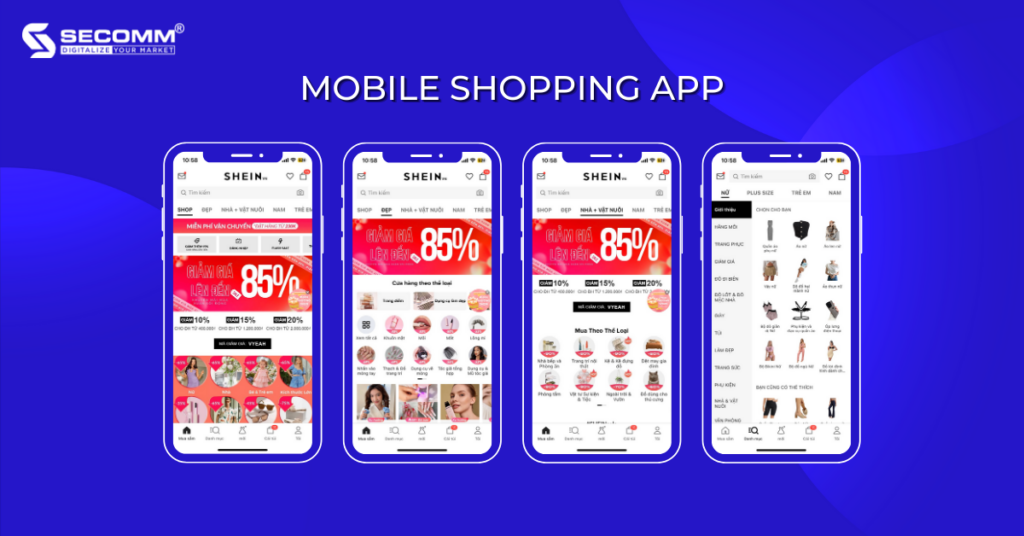
In addition, the outbreak of the Covid pandemic and the establishment of social distancing measures in 2020 marked the beginning of the boom of shopping apps. As stated by the Mobile Shopping Report 2021, global usage of shopping apps increased by 40% in Q1 2021.
In the effort to develop sustainably amidst the pandemic crisis, the SHEIN app with nearly 15.5 million global users played a significant role in contributing to the company revenue of $9.81 billion in 2020.
As of 2021, SHEIN’s mobile app reached 43.7 million users and became the second most downloaded app in the world after Shopee. In 2022, SHEIN’s user base grew to 74.7 million and officially became the most downloaded mobile app globally in the shopping category with over 229 million downloads and installations from the App Store and Google Play
The usefulness of smartphones not only lies in online shopping but also makes transactions and payments more convenient and easy during the peak period of the pandemic. In addition to Mobile Banking applications, users have a special preference for mobile wallet or eWallet applications.
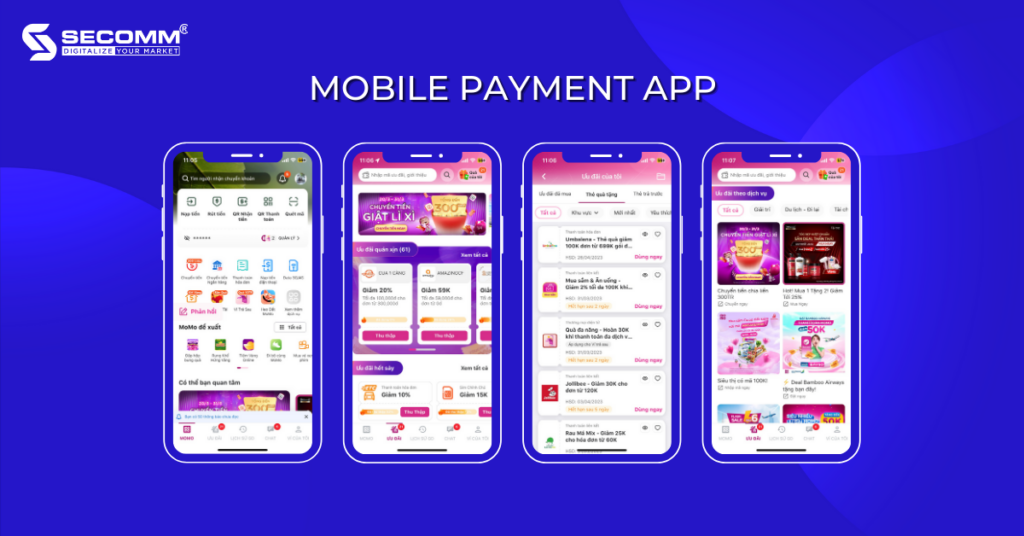
In the Vietnamese market, when it comes to eWallets, people immediately think of MoMo. However, MoMo is not only known as a typical eWallet but also an incredible super application.
To date, MoMo has built a platform that provides about 400 different types of services in many fields such as consumer finance, insurance, money transfer, payment, entertainment, shopping, dining services, and charity donations, etc. The number of MoMo users has increased significantly in recent years, from 10 million users in 2019 to about 31 million users in 2022, and the company’s next target is at least 50 million users.
In addition to making their mobile shopping apps, selling on social media platforms is also one of the widely applied strategies. The popularity and large user base of social media are a solid foundation for the development of Social Commerce and a playground for merchants of all sizes. Social Commerce is a form of online selling through social media platforms like Instagram, Facebook, and TikTok.
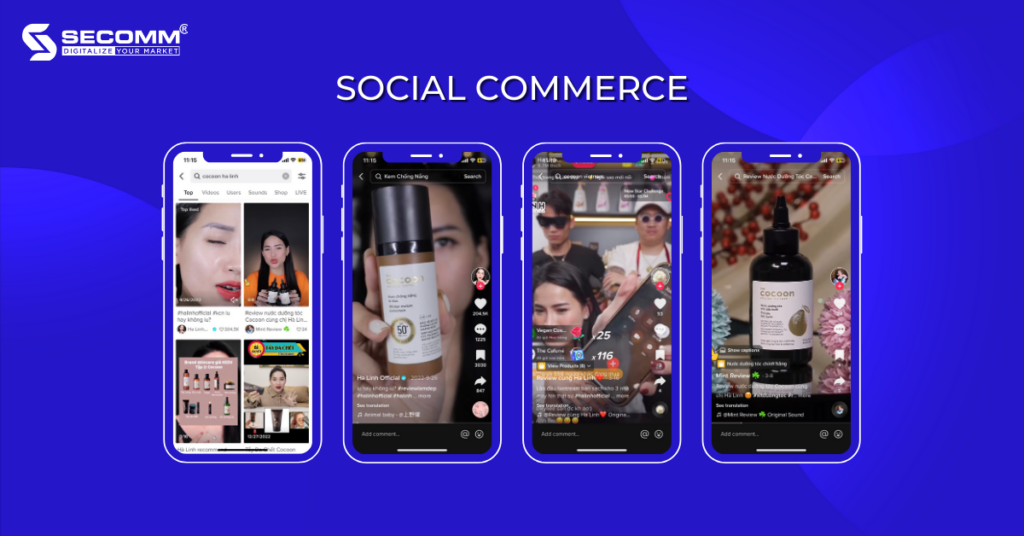
Selling on social media will help brands reach the existing large user base and utilize influencers for their marketing campaigns.
For example, the vegan cosmetics brand Cocoon does this through TikTok Shop. Cocoon is known for its environmentally friendly and animal-testing-free products, and they opened a store on TikTok and collaborated with famous beauty vlogger Ha Linh, which brought them a lot of success. It not only boosted their sales but also reached nature-loving, animal-loving, and young customers on TikTok.
As mentioned, the global number of smartphone users is estimated to reach around 6.9 billion by 2023, which is a driving force for the development of Mobile Commerce. Anyone who owns a smartphone has the potential to become a customer. As a result, implementing Mobile Commerce will help businesses reach this enormous user base, nurture and generate conversions.
In addition, with the mobility of Mobile Commerce, smartphone users with internet access can shop anytime, anywhere, even on the go without being dependent on a fixed location. Especially when visiting a store to shop, instead of paying in cash or by card, customers can now pay through eWallets such as MoMo or VNPay, etc.
Currently, businesses are very focused on personalized customer experience, which is particularly important in the Mobile Commerce world. A smartphone is a personal item that each person carries out personal activities throughout the day. Moreover, in the online shopping trend, customers highly value brands that provide them with a personalized experience because it demonstrates the brand’s concern for its customers. As a result, the more businesses focus on details and personalization in their messages and promotional programs, the better.
For Mobile Commerce, push notifications are an effective solution. Mobile Commerce apps help businesses track and collect user data including personal information, social media accounts, interests, current location, purchase history, viewed products, etc. After that, they can combine and analyze the data to send appropriate messages to the right target audience through push notifications.
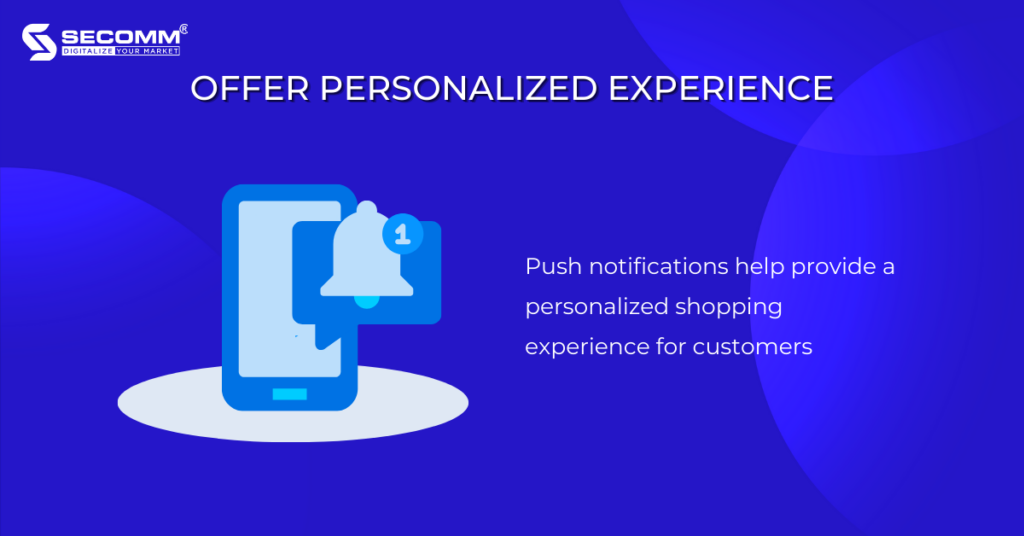
Recent studies have shown the effectiveness of push notifications in connecting with customers and notifying them about new products and special incentives.
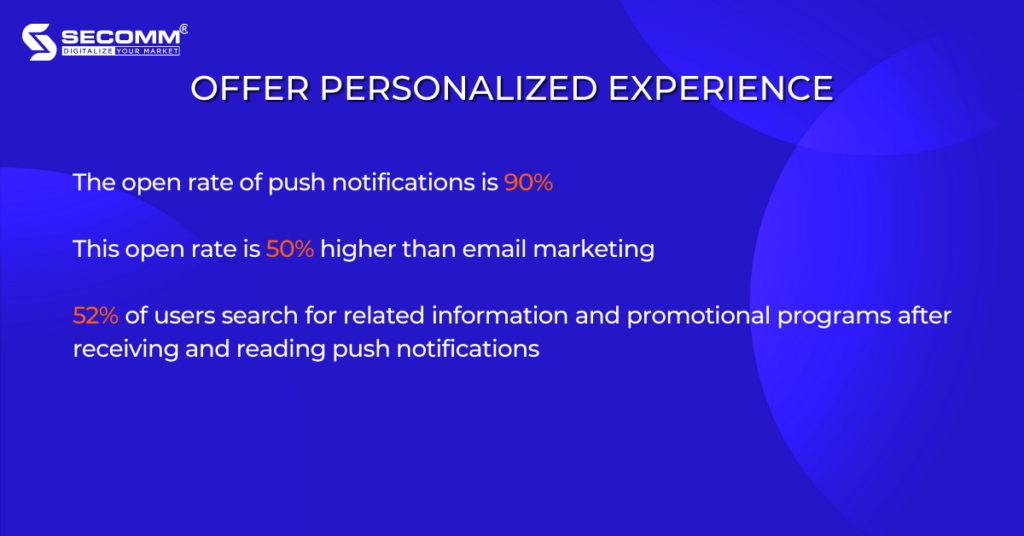
Push notifications are one of the strategies implemented to provide personalized shopping experiences and bring satisfaction to customers. The more satisfied customers are with their shopping experiences, the higher the likelihood that businesses will increase customer retention rates and maintain their loyalty.
The demand for a personalized shopping experience is increasing among customers, as well as the need for a consistent shopping experience across multiple channels, from online to offline stores. According to a study by MasterCard, customers who have a multi-channel shopping experience with a specific retailer tend to spend 250% more than the average. The fashion brand Macy’s has stated that the value of multi-channel shoppers is 8 times higher than that of those who only shop on a single channel.
Moreover, smartphone users tend to use their devices while shopping in offline stores for various purposes, as Retail Dive‘s survey has listed in detail:
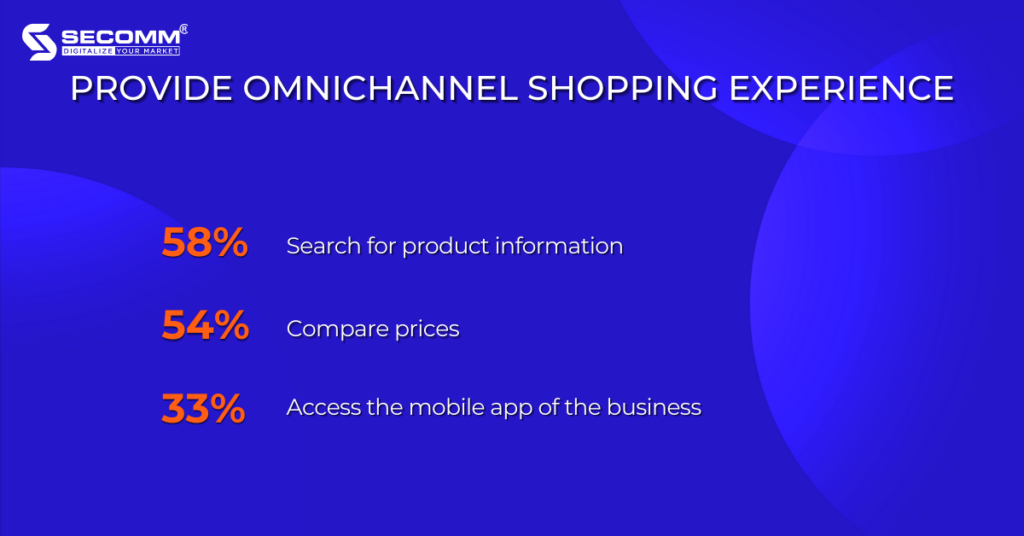
Therefore, by implementing Mobile Commerce, businesses can provide customers with a multi-channel shopping experience.
Mobile Commerce is exploding thanks to the boost from the Covid pandemic. Even though the pandemic has passed, the impact of Mobile Commerce on the development of eCommerce businesses is still significant. If businesses plan to approach Mobile Commerce in 2023, it is a wise decision.
Contact SECOMM today to learn more about Mobile Commerce and the best solutions to get started.
 2
2
 4,780
4,780
 3
3
 1
1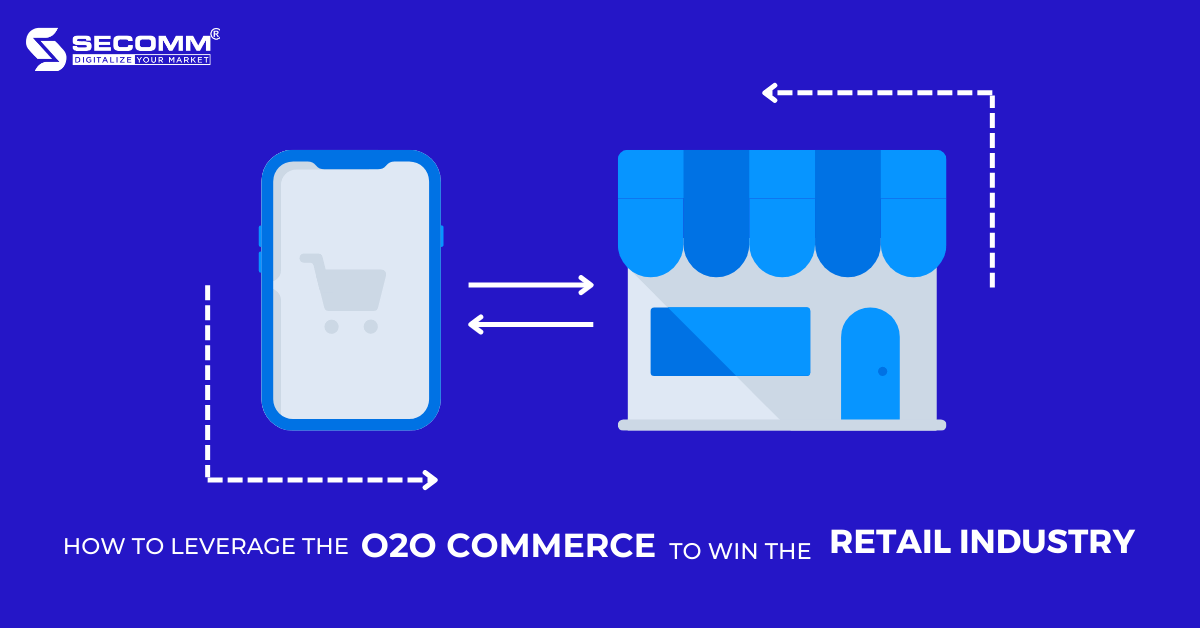
Retails has miraculously recovered from the global pandemic and is expected to make a breakthrough in the years ahead. One of the ways to embrace eCommerce is the O2O model, which combines online and offline operations.
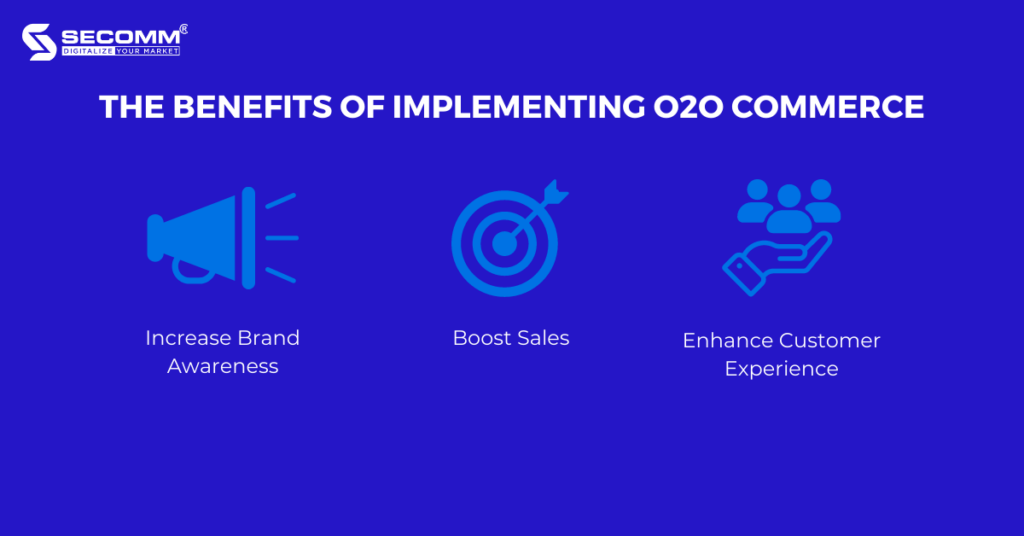
One of the big challenges of physical stores is how to raise brand awareness among potential customers who are far from the store location. Using online-to-offline marketing strategies can increase the public’s awareness of a business’s brand. That way, businesses will be able to reach an influx of customers and boost their awareness of the brand and its products which then lead to higher sales volume and massive revenue.
Despite the rapid development of eCommerce, brick-and-mortar stores still maintain stable sales because many customers still prioritize visiting stores to shop. A recent study indicates 46% of responders said they preferred shopping at a brick-and-mortar store because they want to touch, feel and try the products physically before making purchases. Another interesting fact is customers are likely to spend more money while in the store.
For example, a man comes to a bookstore to buy a notebook, then he looks around and decides to buy some more pens. In case he buys the notebook online, he may only buy it. Thus, the O2O Commerce model is a good choice as businesses can not only use online channels to raise brand awareness but also overcome the limitations of offline channels to earn massive revenue.
The incredible combination of online and offline channels makes the customer shopping experience more seamless and interesting. Online platforms enable consumers to contact brands easily and immediately. When they want to ask for a product’s details, they can send a message through Facebook Messenger or a chatbot on an eCommerce website and the supporting team will answer their questions instantly.
Based on the customer’s data, businesses can offer product recommendations via online channels or the next time customers visit physical stores. In another case, if businesses run ad campaigns, they can notify their customers via online channels, which will help them to reach a larger audience with their online ad campaigns instead of just informing customers when they walk into the store.
BOPIS is not a brand-new way to shop but has been around for a while. Merchants that provide this service can attract online shoppers to visit their brick-and-mortar stores. This way, customers will browse the eCommerce website to search for products, buy them and get notifications when the products are ready to pick up in the physical store. It’s convenient for customers to select a specific time to come to check and get their orders at the store. Merchants gain benefits too with amazing cross-sell and up-sell opportunities.
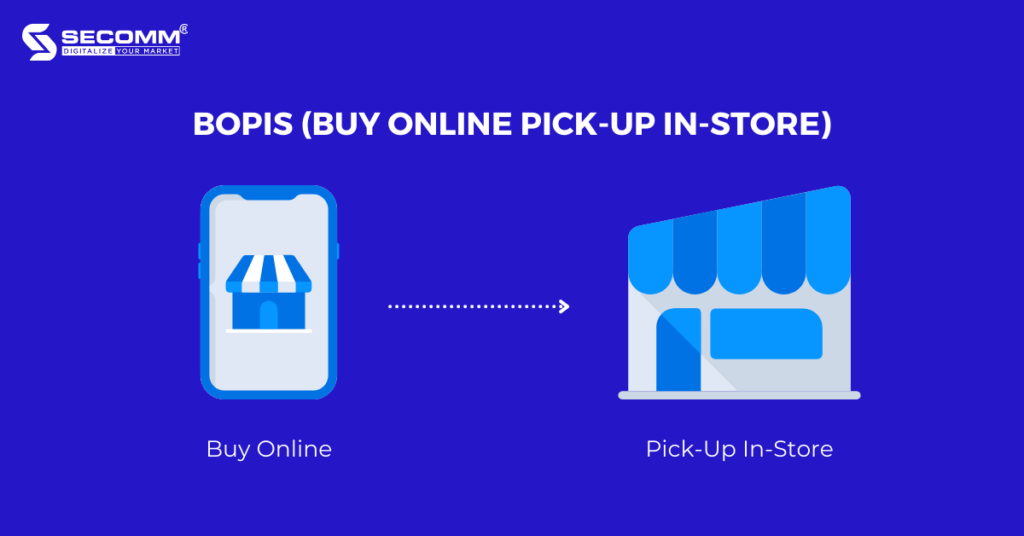
Although BOPIS is great, it may not be every customer’s choice as not everyone likes to go to the store to pick up the products, instead people prefer home delivery rather than the in-store pick-up option. Sometimes, shopping at the store also causes many inconveniences, for example, finding a parking lot to go to the store in a densely populated area, picking up the goods, and returning to the car, seems time-consuming and annoying for busy people.
To solve this problem, merchants can self-deliver if the store location is close enough and convenient for the delivery process to be fast and efficient. Otherwise, collaborating with delivery companies like Giao Hang Nhanh, Giao Hang Tiet Kiem, and so forth, is a good choice when the business resources need to be increased.
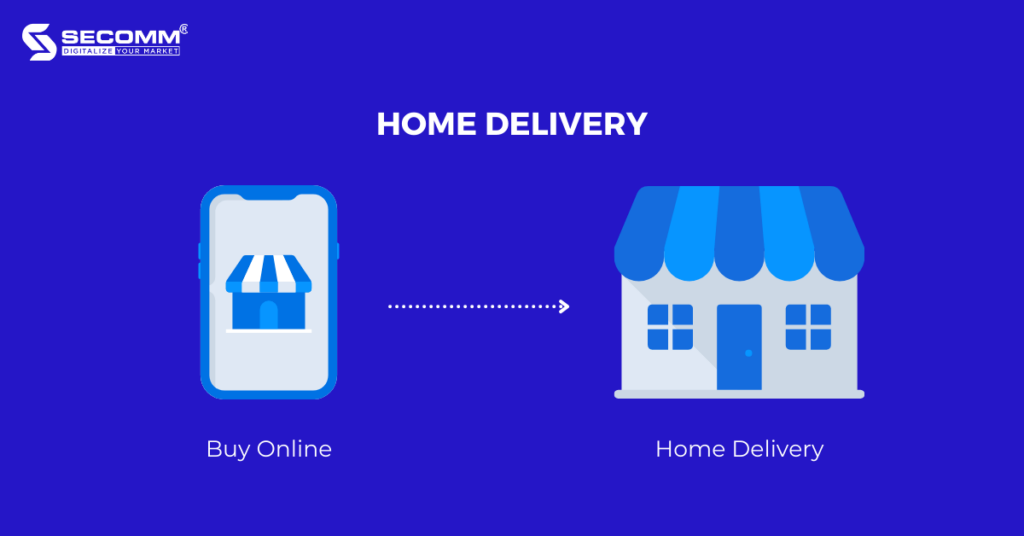
Suppose a customer bought a product online but when receiving it, he realized it didn’t fit his demand. There was a store nearby, so he decided to return the product he bought there. But when he arrived, the staff there didn’t accept his return request because they had no clues of that purchase in the store’s system.
Therefore, he had to return his order to the carrier and wait a long time before receiving his refund. That will make consumers wonder whether they should keep shopping with that merchant next time. Thus, in-store return has become a fantastic offerable solution for customers to avoid the hassle of returning goods. This method simplifies the return process for shoppers and merchants because returns and refunds are processed simultaneously, which means better customer service and a much faster return to stock.
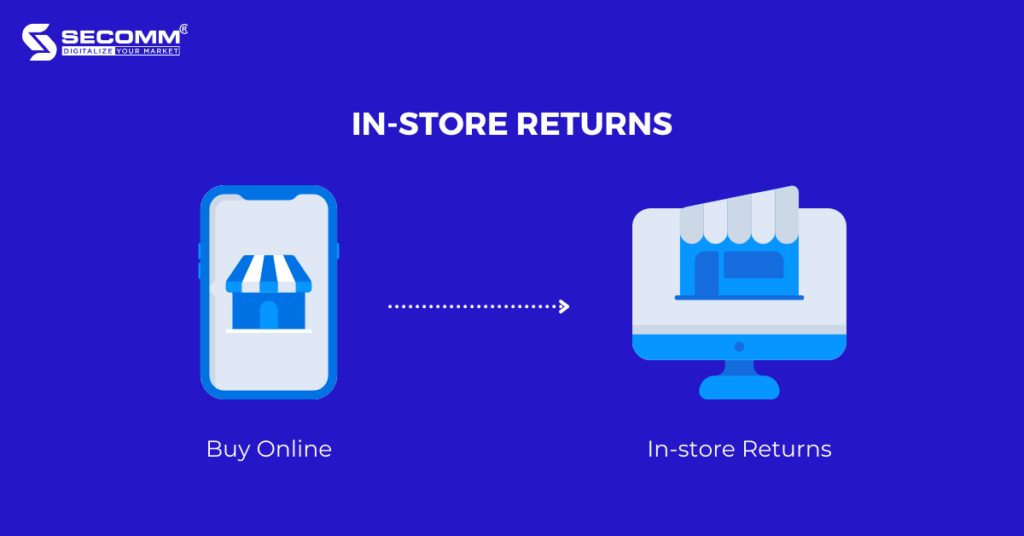
Loyalty Program is another great way to encourage customers to engage with the O2O shopping experience.
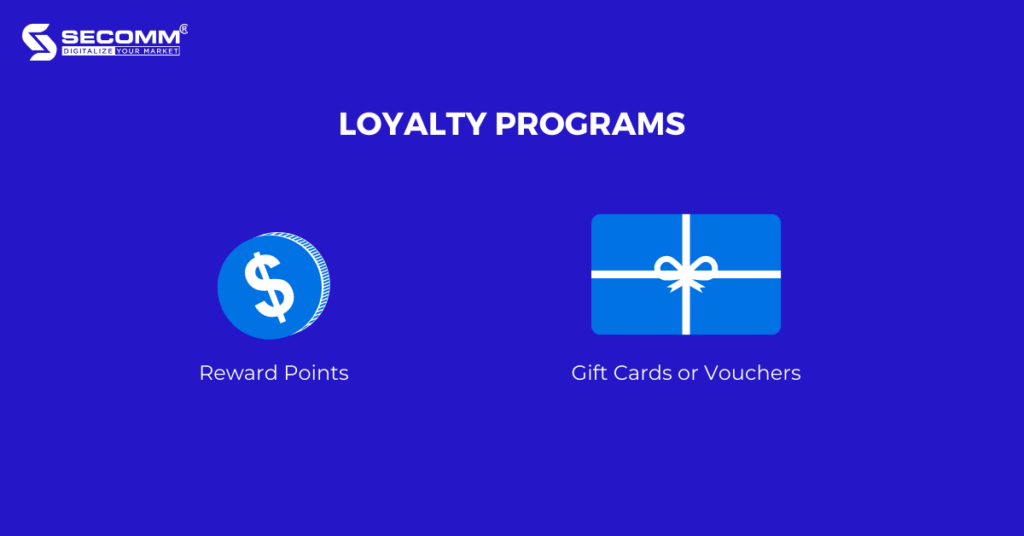
This is one of the popular types of loyalty programs. Every business can assign points to any items or user activities. While purchasing or joining any engaging program, customers will easily earn points afterward for later exchanging gift cards, vouchers, and even actual money which then encourages them to go back to spend more in order to get benefits from the gifts. As a result, reward points will boost sales and increase brand loyalty.
Gift cards can be used not just as gifting options but also as a powerful tool to get customers to spend in their outlet. Customers can use gift cards immediately or save for later purchases, or even give it to relatives and friends. As a result, relatives and friends are likely to become potential customers of the brand soon.

The first thing to do is identify the main objectives. If businesses haven’t built their online presence, they should do it immediately due to the rise of online shopping. If businesses already have their online presence (eCommerce website, mobile app, marketplace), it’s important to adjust their O2O Commerce strategy to increase sales online, offline, or both. They should also consider using some measurable metrics to ensure these objectives are appropriate and achievable.
Next is working with a team to raise ideas for the O2O Commerce strategy. Here are a few suggestions:
Then use these data to decide which strategies to try.
Once deciding on strategies to deploy O2O Commerce, businesses will use collected data to measure the success of those strategies and make the next business decisions. Looking back on the initial objectives when evaluating and adjusting the O2O marketing and business strategy, then considering the additional objectives if the original ones have been achieved.
Founded in 2014, SECOMM is specialized in providing O2O Commerce solutions. Over the years, SECOMM owns a massive fortune of O2O commercial projects with major domestic and international customers such as, Annam Gourmet, Trentham Estate, etc.
In particular, SECOMM provides a variety of services to support businesses to improve their competitiveness and dominate the retail market in the digital age including Solution Consulting, Core-team Building, and O2O System Development, including:
Business System
Administration System
Customer Experience Management System
Data system
Want to learn more about O2O Commerce as well as the best solutions to win the retail industry? Contact SECOMM now for a free consultation.
 2
2
 3,625
3,625
 0
0
 1
1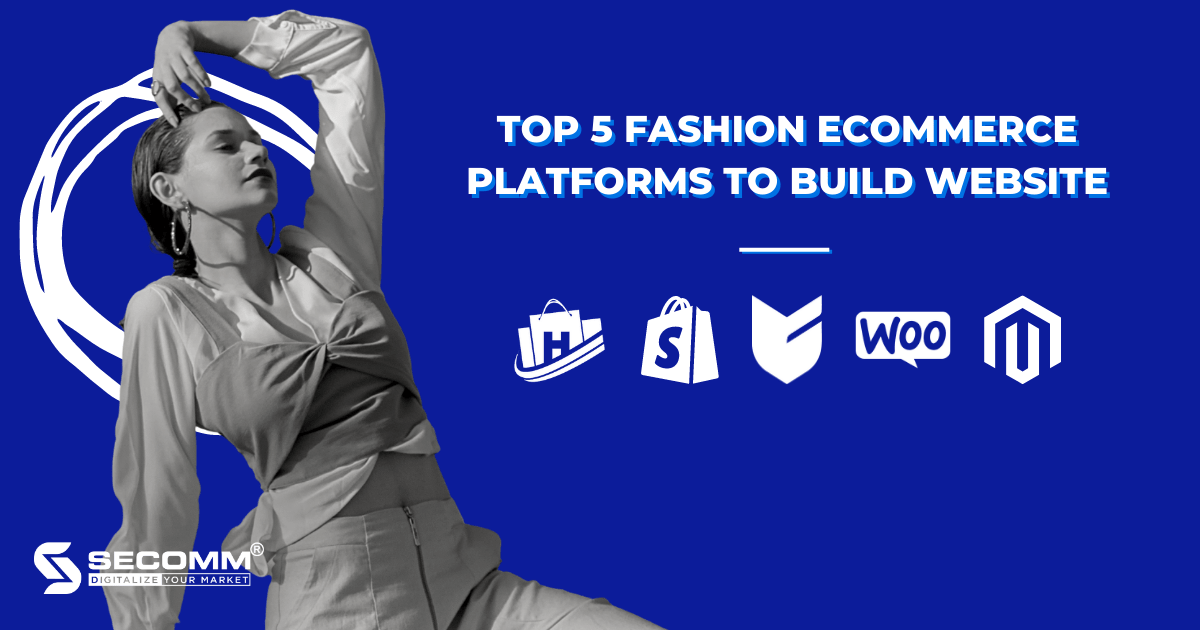
Despite the significant impact of Covid-19, the fashion industry is still on a roll, with the potential to reach $1 trillion globally by 2025 (according to Statista) thanks to eCommerce.
According to the IDEA 2022 research, the fashion eCommerce business in Vietnam is a highly competitive area, with up to 69 consumers using the eCommerce channel for every 100 fashion shoppers.
With the high potential of this commerce business, developing an eCommerce website is a must for success, necessitating the search for a platform on which to build a specialised eCommerce website for the fashion industry.
Businesses can use the following platforms to deploy fashion websites: Big Cartel, Haravan, Shopify, Woocommerce, and Magento.
UI/UX is a criterion that businesses frequently establish when creating an eCommerce website in order to develop a comfortable interface for a group of users who are passionate about fashion and maximise the capacity to engage with customers.

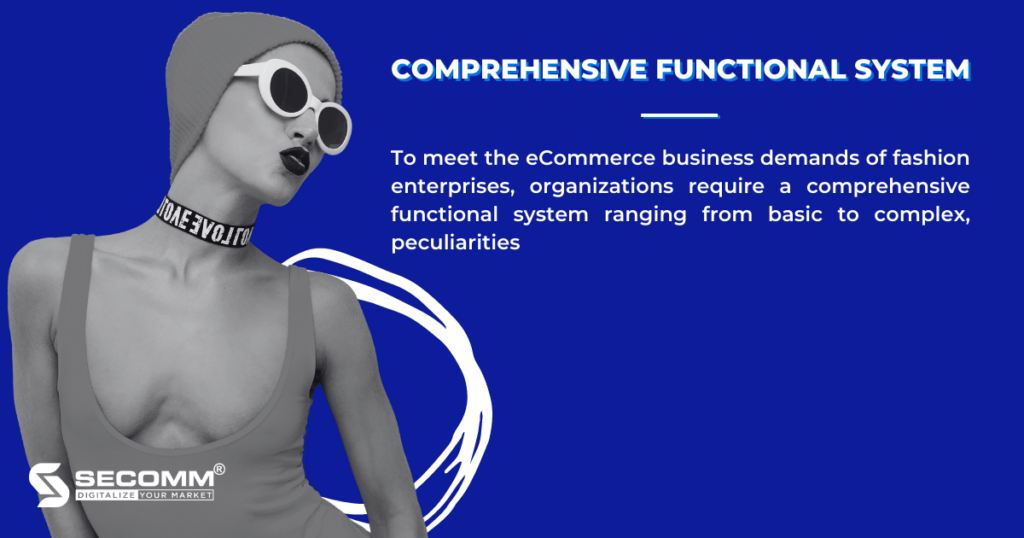
To meet the eCommerce business demands of fashion enterprises, organizations require a comprehensive functional system ranging from basic to complex, which includes:
To provide clients with a comprehensive shopping experience, fashion enterprises may frequently combine a number of payment options, shipping services, management software, and business analysis tools to enhance the e-commerce business system.
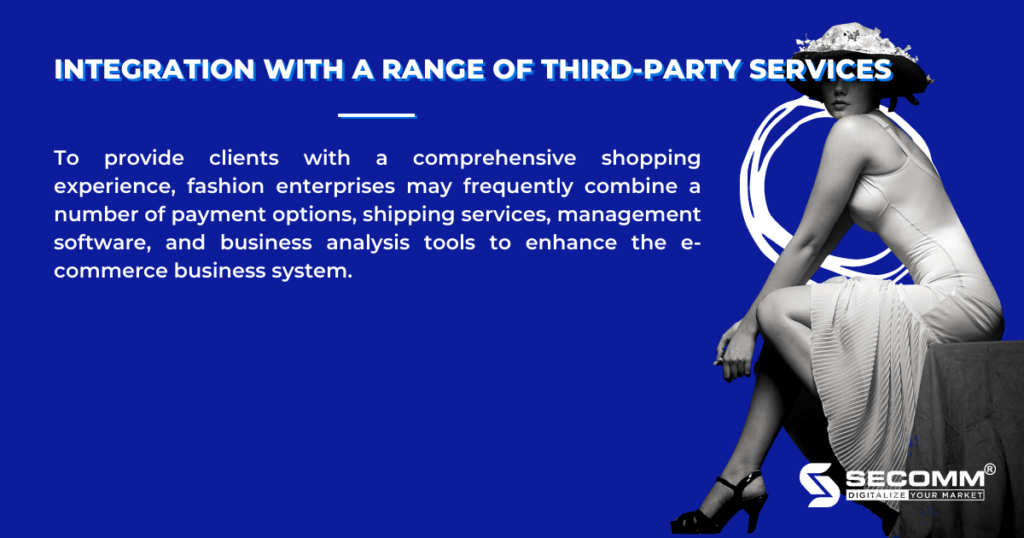
Numerous common payment options available today must be integrated into the website, including:
Often, firms at the start of a fashion business will not focus on the capacity to develop eCommerce websites in the future since platforms that enable this function are typically scarce. But, in terms of strategy, investing in a platform that supports this function can help organisations gain a competitive advantage over competitors in the market.
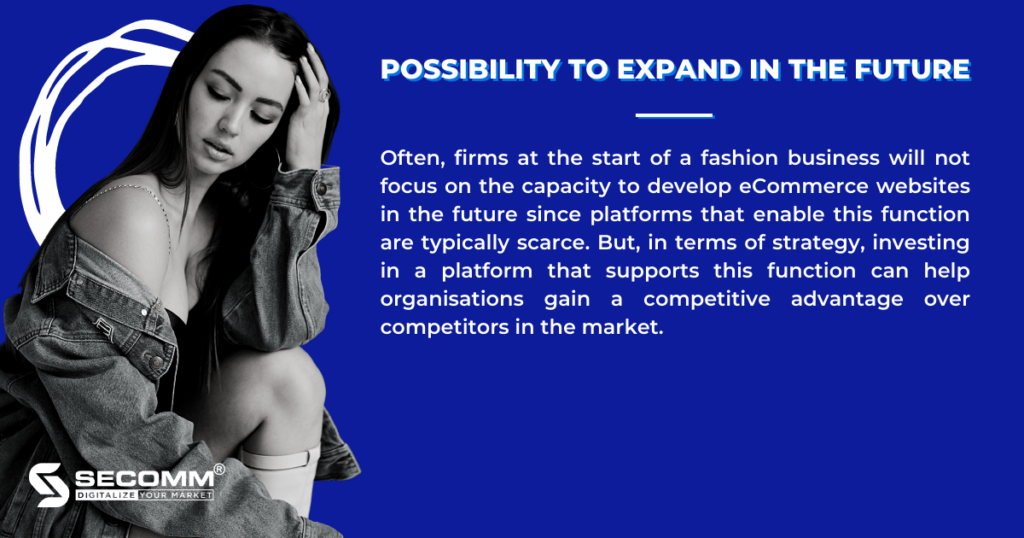
Haravan is a well-known SaaS eCommerce platform in the Vietnamese industry, offering a variety of options for both enterprises and individuals. Haravan is used by a variety of websites, including Juno, Biti’s, Maison, and others.
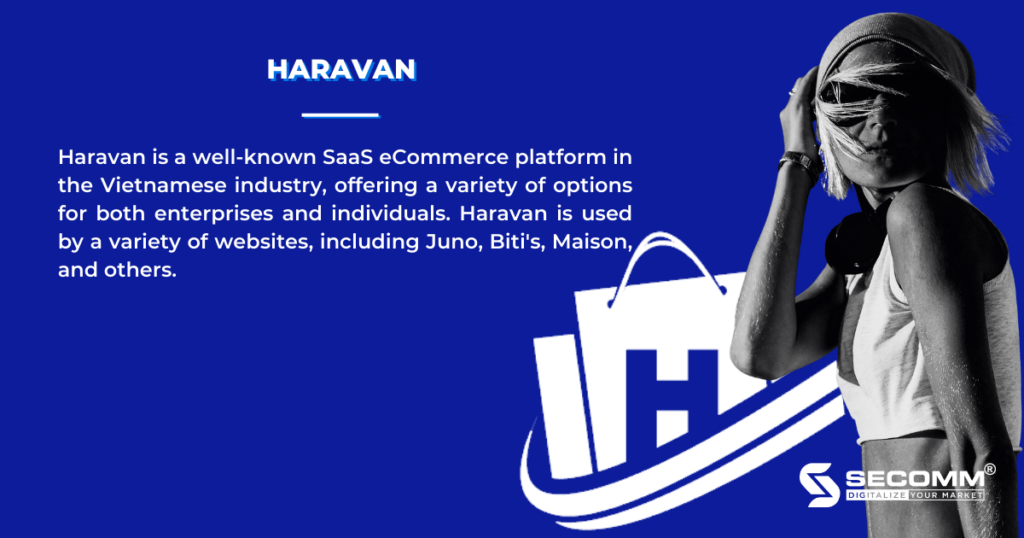
Pro:
Cons:
→ Rating: 2/4
Haravan is suitable for start-up furniture businesses or SMEs (small and medium-sized enterprises) with operations mainly in Vietnam.
Haravan is considered to have a reasonably low and diverse eCommerce website implementation cost for various businesses:
Tuy nhiên, doanh nghiệp nên suy xét khi sử dụng Haravan trong dài hạn vì chi phí giấy phép sử dụng và các tiện ích mở rộng sẽ ngày càng tăng theo thời gian sử dụng.
However, businesses should consider when using Haravan in the long term because the cost of licenses and extensions will increase over time.
Shopify is a SaaS ecommerce platform favored by the international ecommerce business community because of its fast implementation time and reasonable starting cost.
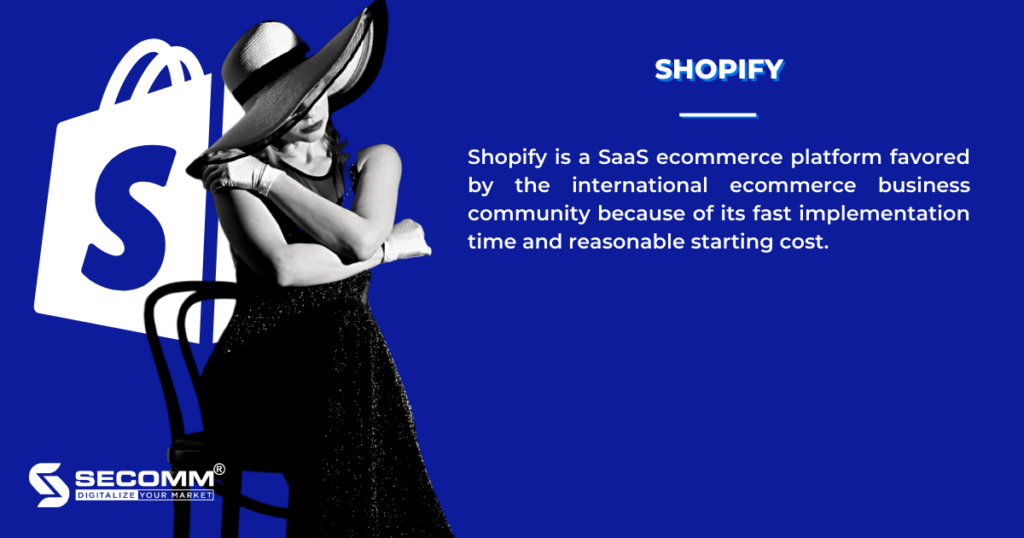
Pro:
Cons:
→ Rating: 2/4
Shopify is considered suitable for start-ups or SMEs with global operations.
Starting an eCommerce business using Shopify is quite inexpensive at beginning, with several options:
Nevertheless, the long-term cost of utilising Shopify will rise owing to rising costs for extensions, yearly usage fees, and % per transaction on the system.
The typical time to develop an e-commerce website is 1-7 days or more, depending on the system’s complexity.
Big Cartel is a platform that assists in the creation of specialised eCommerce websites for the fashion industry or for art goods such as ceramics, paintings, and photographs. Big Cartel is used by several websites such as Atakontu, Indikidual, and others.
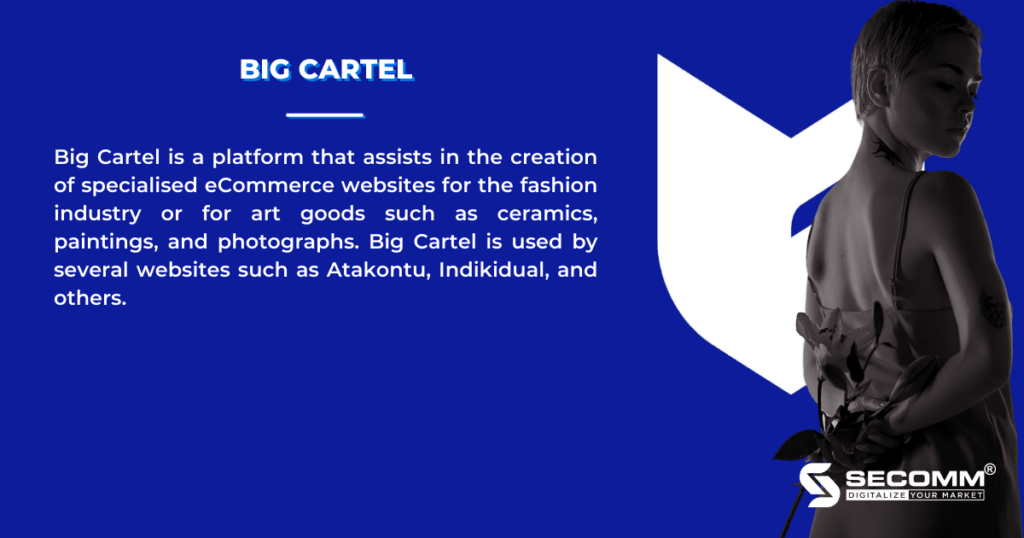
Pro:
Cons:
→ Rating: 2.5/4
Big Cartel will be appropriate for startups, SMEs, or new e-commerce participants that need to handle the complicated “issue” of fashion eCommerce.
Website setup expenses are modest, with few possibilities for solution packages such as Haravan or Shopify:
Big Cartel allows you to develop a fashion e-commerce website in as little as 1-2 weeks, depending on the system’s complexity.
WooCommerce is an open source platform, as a WordPress plug-in introduced in 2011 and allows businesses to use completely free. Popular websites using WooCommerce in Vietnam include Hai Trieu, Orchard, etc.
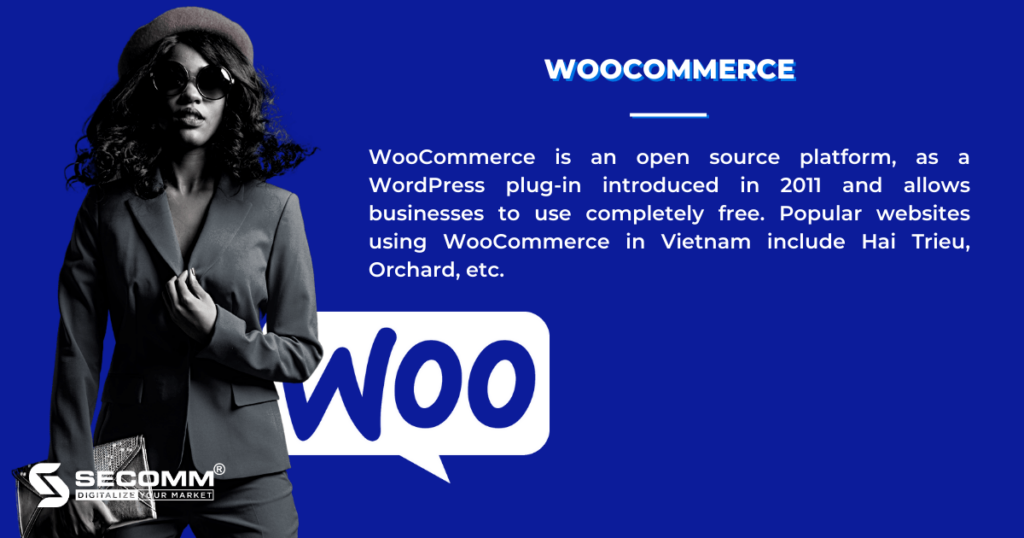
Pro:
Cons:
→ Rating: 3/4
WooCommerce is suitable for fashion businesses who are used to WordPress before and are in need of developing an eCommerce system.
Because it is an open source platform, fashion firms can use it for free; nevertheless, businesses must pay development costs while utilising the platform, such as:
An eCommerce website will take longer to create than the previous three platforms since it must be constructed from the ground up, which will take at least 1-3 months.
Magento is an open source platform with 2 versions: Magento Open Source (free) and Magento Commerce (paid). Some websites are using Magento such as Canifa, Hoang Phuc International, OnOff, etc.
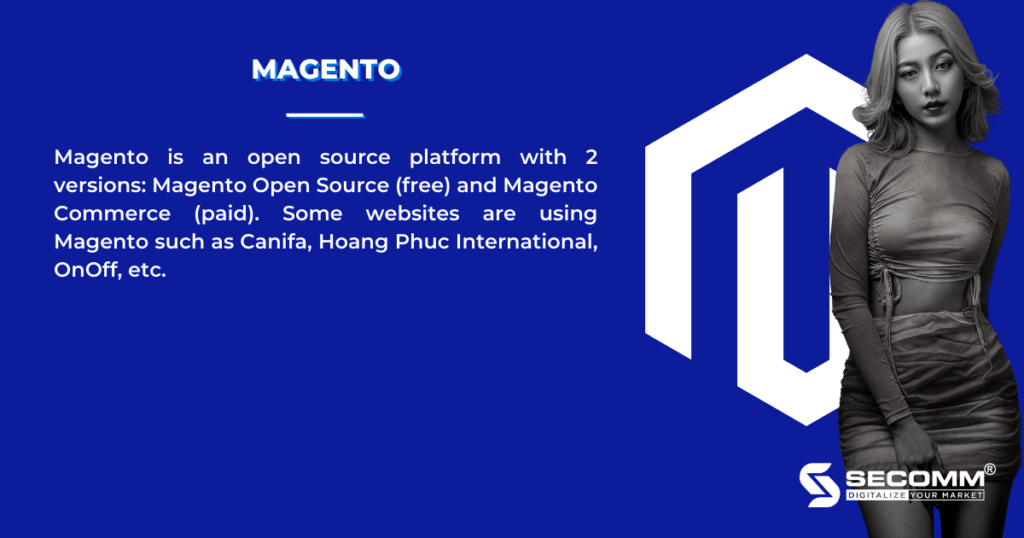
Pro:
Cons:
→ Rating: 4/4
Magento is appropriate for a wide range of fashion business types, including B2B, B2C, and B2B2C, as well as a wide range of business sizes, including startups, SMEs, and huge corporations. Nevertheless, because the cost of deploying Magento is sometimes very high, Magento is favoured by major organisations.
Magento Open Source, like WooCommerce, is an open source platform, therefore it is free to use; nonetheless, businesses must consider the following costs:
Businesses will be working directly with Magento’s development team for Magento Commerce, thus they will have to pay licence fees as well as certain additional charges such as:
A complete Magento project typically requires 3 to 6 months of deployment time, with some projects requiring up to a year. The reason for this is the complicated functioning structure and the lack of Magento experts.
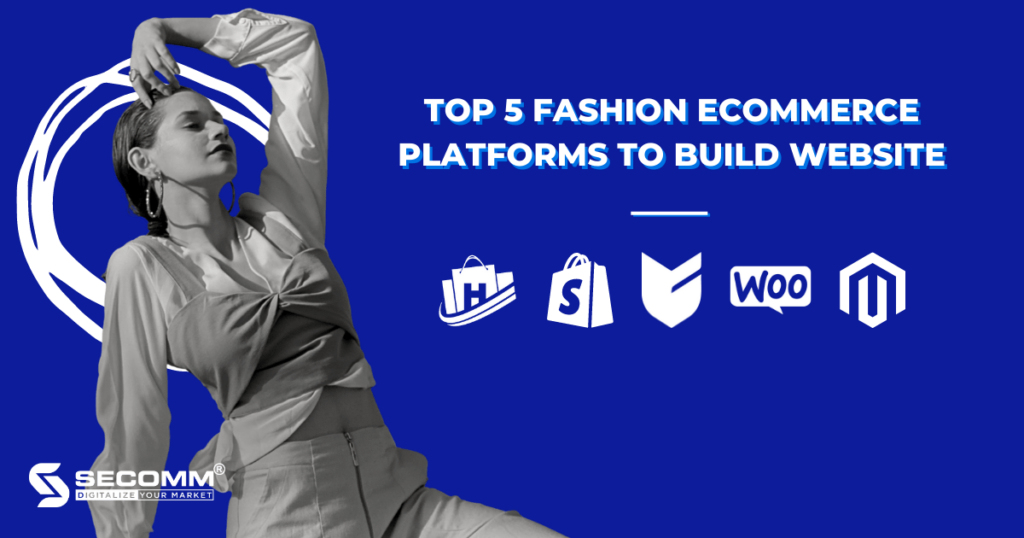
 2
2
 4,445
4,445
 0
0
 1
1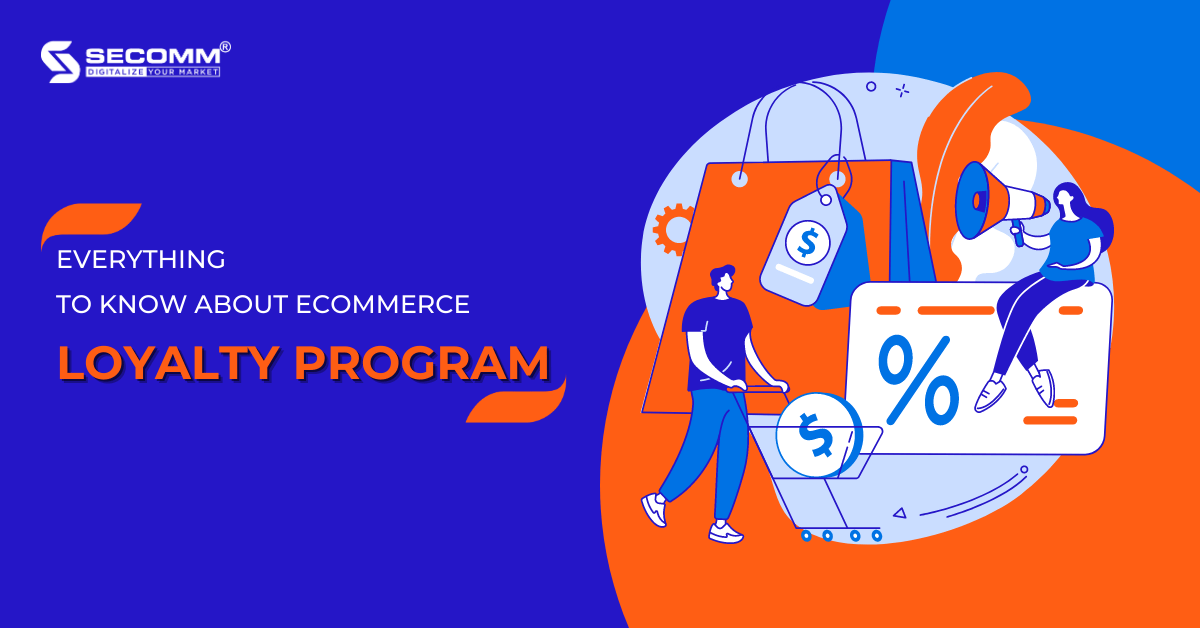
In the world of eCommerce, customer loyalty plays an important role in the success of businesses amidst fierce competition. There are many ways to build and maintain customer loyalty, but one of the most prominent is to enhance the customer experience through loyalty programs.
Sometimes businesses focus too much on finding new customers and forget the value of their existing customers. The following statistics show how valuable it is to maintain customer loyalty:
Existing customers are the best customers and the most valuable asset of an eCommerce business. These customers contribute greatly to the business profit and help businesses save time and money to acquire new customers.
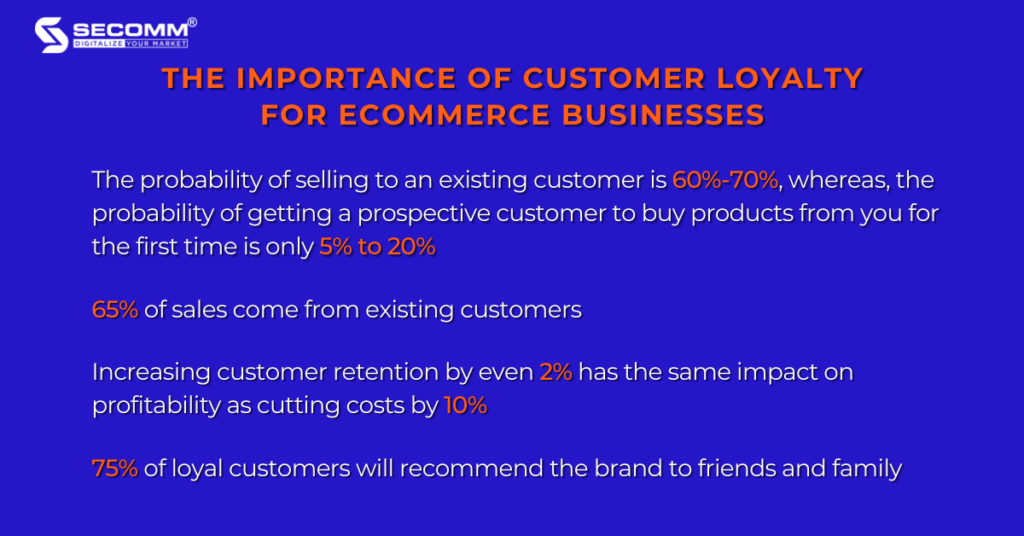
89% of eCommerce businesses around the world agree that the customer shopping experience affects customer retention. A high customer retention rate indicates that customers are happy and satisfied which leads to increased loyalty and repeated purchases.
Retaining customers plays an important role in eCommerce businesses because the cost of attracting new customers is five times higher than maintaining existing ones. Moreover, increasing customer retention by even 5% can increase business profits by up to 95%. This is because satisfied customers are likely to refer the brand to others.
Therefore, businesses need to focus their time, money, and energy on enriching the customer experience, persuading them to come back to shop more often, and recommending the brand to friends and family.
Among the various strategies for maintaining customer loyalty, Loyalty Program is one of the most effective factors for eCommerce success.
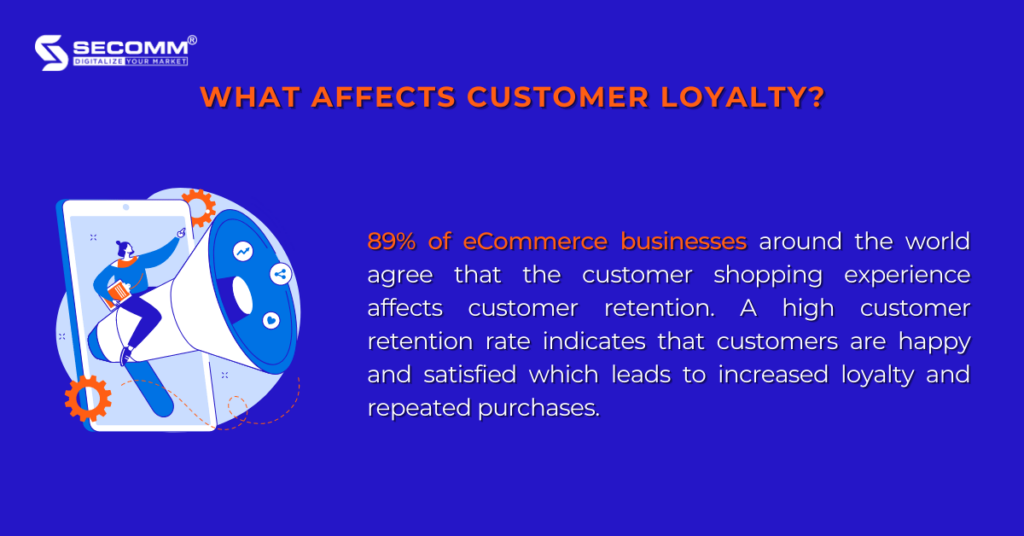
A loyalty program is a marketing strategy designed to encourage customers to continue to shop at or use the service of a business associated with the program. Simply put, eCommerce businesses build loyalty programs to reward customers for their purchases and engagement for a long time.
The reward can be any free product, discount code, or special offer to represent the appreciation of the business for its customers, who tend to spend more because of the benefits they receive when participating in loyalty programs.
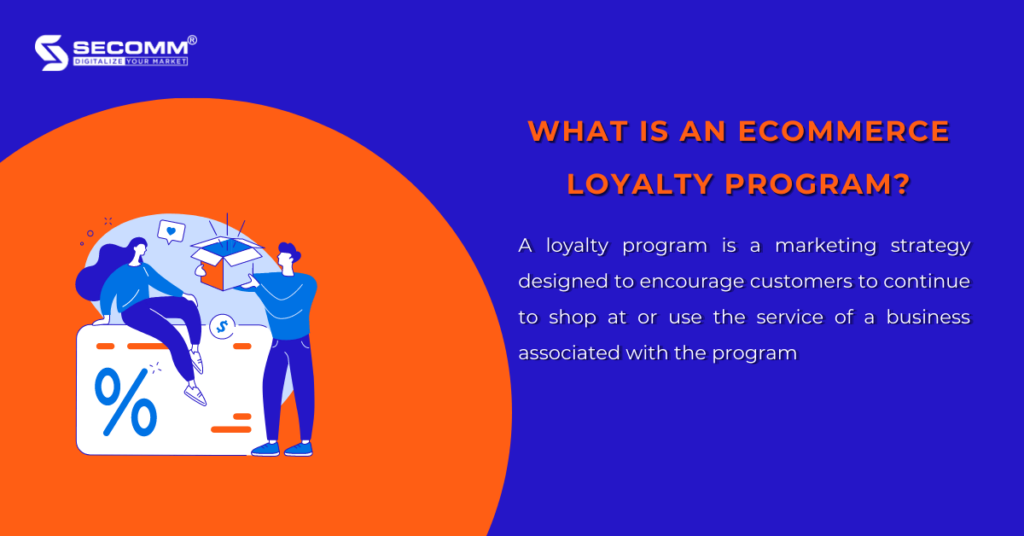
According to Yotpo, nearly 68% of customers said they would be willing to join the loyalty program and special incentives motivates them to buy more products.
Loyalty programs not only enrich the shopping experience and keep customers engaged with the brand but also from a business perspective, the benefits they bring to eCommerce businesses exceed the initial expectation.
The development of eCommerce helps customers shop more conveniently. That means their expectations for the shopping experience are higher. Today’s customers make their purchasing decisions not only based on price but also other factors such as service experience or emotional connection with the brand, etc.
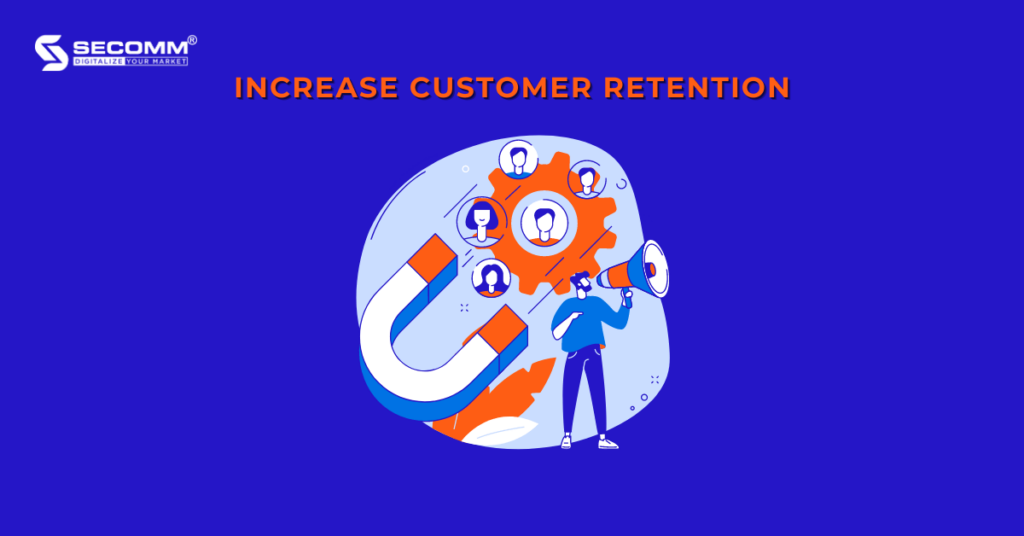
According to HuffPost, 66% of customers tend to switch brands for shopping if the service is not good enough. Loyalty programs help enhance the shopping experience. The more shopping satisfaction, the more customer retention and loyalty.
Customer Lifetime Value or CLV is a key metric that indicates the total revenue an eCommerce business can reasonably expect from a single customer account throughout the business relationship. Most business owners will always find ways to increase the CLV index in order to maximize their profit.
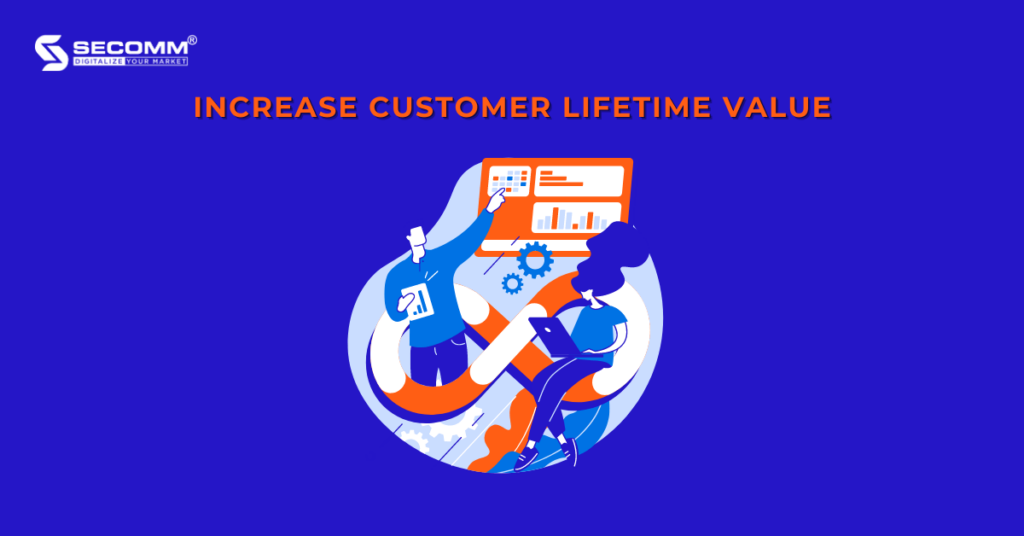
According to Harvard Business Review, the cost of acquiring a new customer is more expensive, ranging from 5 to 25 times, compared to retaining an existing customer. As a result, high lifetime value customers become priceless assets for a business, as their purchases will not require acquisition costs. In other words, a business doesn’t have to incur acquisition costs for loyal customers.
On the other hand, the business has to spend acquisition costs to convince potential customers to buy its products. Thus, even if a new customer spends the same amount on a product as an existing customer, it may not bring in equivalent profits because of acquisition costs.
In most cases, existing customers are also the most incredible advocates. When customers are satisfied with the shopping experience, they are more likely to share it with their family, friends, or colleagues, and the business will gain more potential customers naturally.
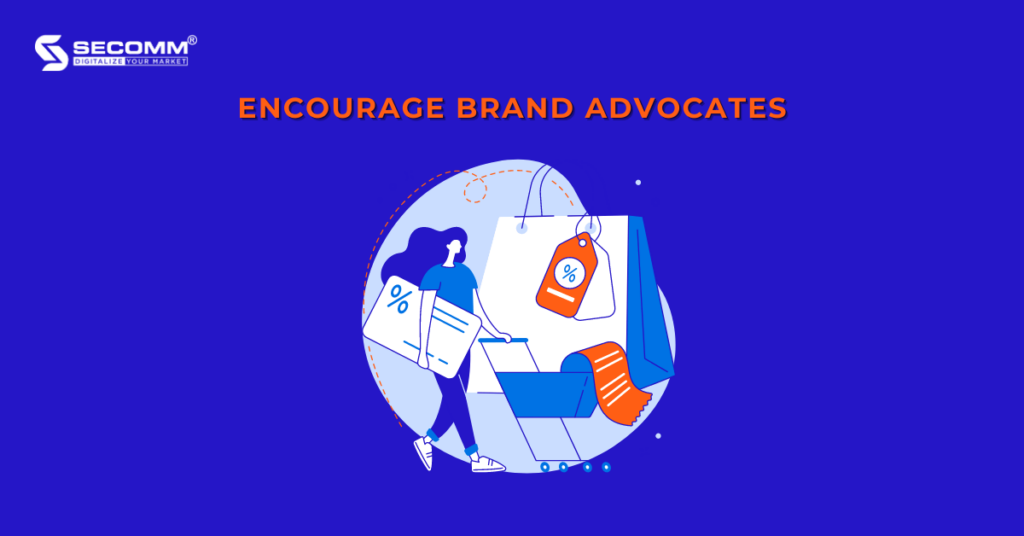
Compared to brand messages, recommendations from existing customers are even more effective. According to Nielsen, 77% of consumers trust recommendations from people they know more than any other source. As a result, before making a purchase, they will seek advice from people they trust. Plus, 64% of marketing experts believe that word-of-mouth marketing is one of the most effective forms of marketing.
With the development of the Internet and social media platforms, recommendations from existing customers come in various ways, including posts, comments on social media or review videos, etc. This helps reduce acquisition costs so that every eCommerce business needs to focus on enhancing their existing customer shopping experience and new customers will end up rolling in for free.
This is one of the most popular eCommerce loyalty programs since it is easy to set up and manage. By joining this type of program, customers can earn reward points after each purchase. They can then redeem their accumulated points for rewards such as gifts, discount codes, and other special offers. They also can earn reward points in many other ways besides making purchases, such as sharing product pages on social media, writing product reviews, completing surveys, filling out personal profiles, and so forth.
Although this type of program is relatively simple to implement, businesses still need to ensure that the points customers earn have enough value to encourage them to continue shopping. Plus, the time it takes to redeem points for rewards should be short enough because if customers have to wait for several months or even years to redeem points for a valuable reward, the attractiveness of the points-based program will decrease.
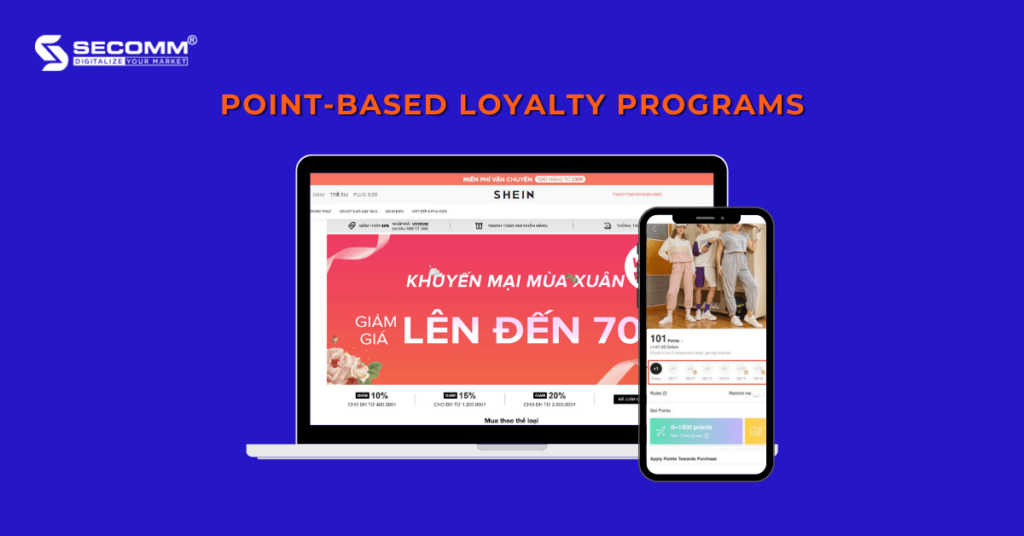
SHEIN, a popular fashion brand founded in 2008, has created a great SHEIN Bonus Point Program reward system on its mobile app. This program allows customers to earn points by registering an account, making purchases, reviewing products, and participating in special online events held by the brand.
Each activity equals a specific reward point. Then, customers can use their reward points to receive discounts ranging from 15% to 25%, and even up to 70% for their next purchase. Additionally, reward points can also be used to exchange vouchers or other special offers when customers participate in SHEIN events or play games on the mobile app.
Another popular loyalty program is the tiered-based one. It encourages customers to strive to move up higher tiers to receive more valuable benefits and rewards. The more customers spend on shopping, the more benefits they receive.
This program helps to foster customer loyalty to the brand. To maintain or move up in rank, customers have invested a lot of time and money, and they will not easily give up the huge benefits they are receiving to participate in another brand’s loyalty program.
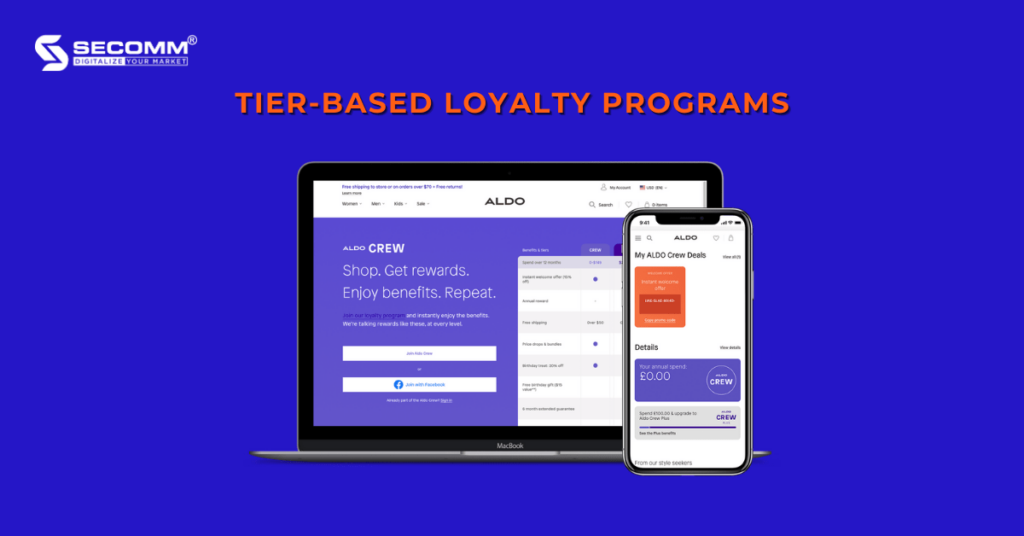
The famous shoe brand Aldo, with over 1,000 stores in 65 countries, focused on 3 main markets – the US, the UK, and Canada – when building their loyalty program. Known as Aldo Crew, the program offers customers three levels of membership: Crew, Plus, and VIP. All customers are initially enrolled as Crew level members. To advance to the Plus or VIP levels, customers must spend between $150-299/month for the Plus level and over $300/month for the VIP level. Depending on the level, each customer receives corresponding rewards, and VIP-level customers receive all the special perks offered by the Aldo Crew program.
eCommerce loyalty programs are very attractive because, from the customer’s perspective, they get benefits for free. However, in reality, customers have to make a purchase or perform a specific action to earn those “free” benefits.
Many world-renowned brands have created incentive programs based on subscriptions to provide incredible services and charge customers for participation. Amazon Prime, eBay Plus, and Walmart+ are some examples.
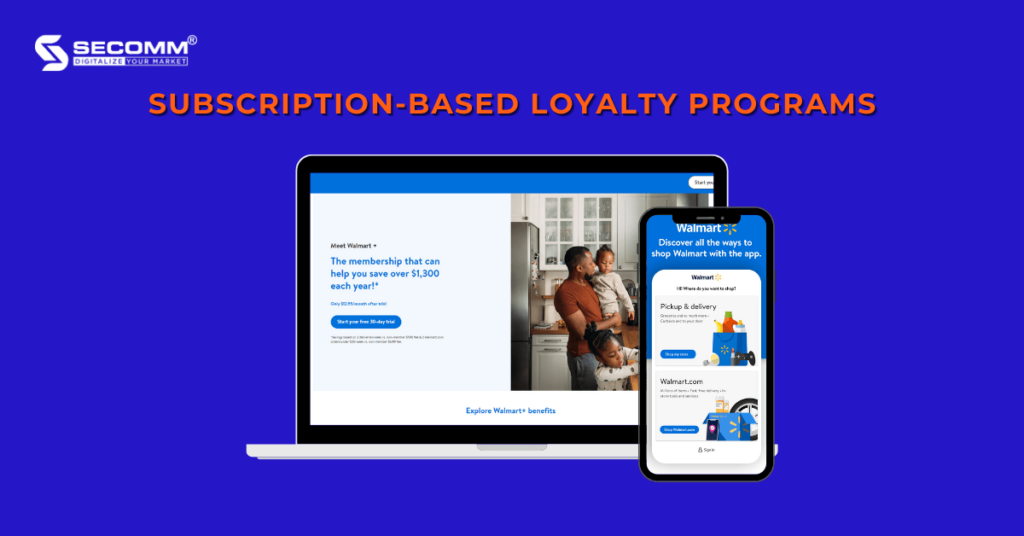
To participate and receive truly valuable benefits, customers are required to pay a fee. Since customers have to pay a fee, their commitment to engaging with the brand is also higher than in other loyalty programs. Also, because businesses charge customers when they register as members, this loyalty program type usually has a trial period for businesses to convince customers that the benefits they receive are worth the money they spend.
In 2020, the famous American retail chain Walmart launched a subscription-based loyalty program called Walmart+. The program is integrated into the Walmart app and offers many special benefits to customers both in-store and online, including:
To join the program and enjoy these benefits, customers have to sign up and pay a specific membership fee of $12.95/month or $98/year. Customers can try the program for 30 days before committing to a membership.
The loyalty program strategy plays an important role in customer experience which leads to their loyalty to the brand. The success of SHEIN, Aldo, and Walmart has become an inspiration for other eCommerce businesses to jump into the game.
To learn more and develop the best loyalty program strategy, contact SECOMM now for a free consultation.
 2
2
 4,826
4,826
 0
0
 1
1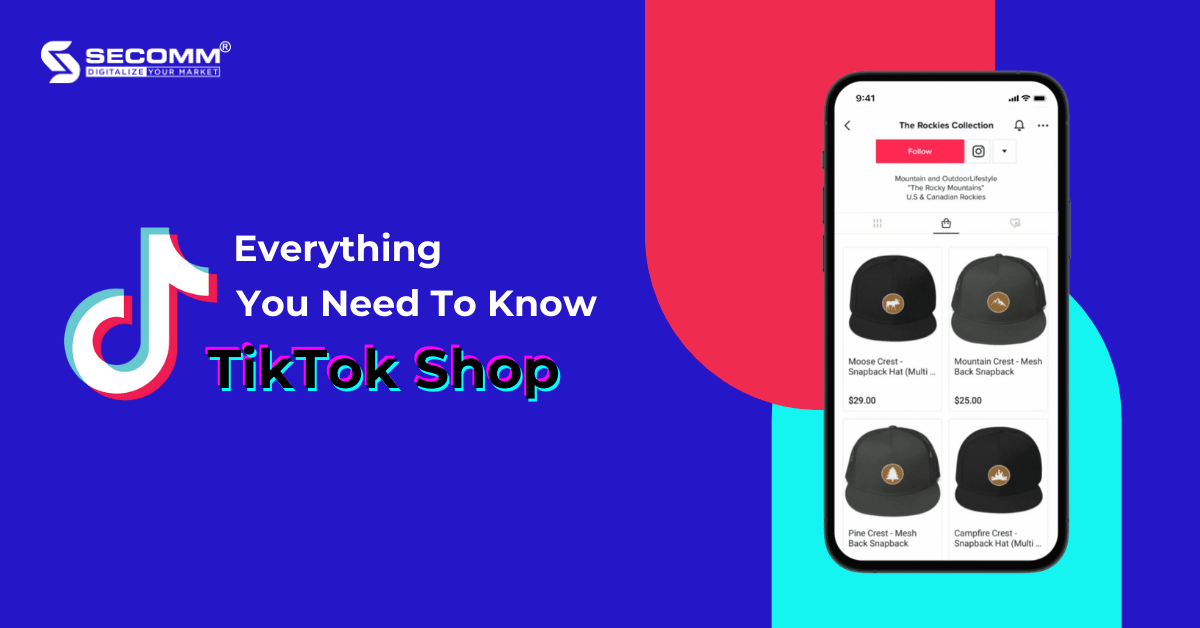
Along with the development of technologies, social platforms like Facebook, Instagram, and Twitter have been around to satisfy the demand for online interaction for over two decades. However, the change in consumer behavior makes TikTok the new favorite.
By the end of 2022, TikTok was reported to reach 1B users globally, becoming the fastest-growing social platform ever. Having a large user base amid the rise of online shopping is an advantage, which contributes to TikTok’s ongoing transition into a Social Commerce platform.
Recently, the social media platform has added a new buying and selling feature called TikTok Shop. It is a new solution for businesses of all sizes to boost customer engagement, brand awareness, and sales.
The content of TikTok consists of vertically arranged videos that are compatible with smartphones and users only need to swipe up to watch a series of videos that are only a few seconds to one minute long. Creating content on TikTok is also easy and simple, users only need to upload the original video and add a few effects, then they will have an interesting and fun short video. With over 1 billion videos viewed on TikTok every day, it has opened up marketing opportunities for many brands.
The majority of TikTok users are Millennials and GenZ, and it now expands to even younger users. They are a driving force behind the increasing expectation of digital experiences. Over 55% of GenZ in Vietnam are using TikTok, in the US, 62% of people between the ages of 10 – 29 are using this social network. The attention span of Millennials is about 12 seconds and for GenZ it’s around 8 seconds. Therefore, TikTok’s short-length videos are particularly popular with these generations because of their easily consumable content.
When compared to Reels (a feature of Instagram) and Short (a feature of Youtube), TikTok even has the upper hand. As The Graygency has noted, the monthly user base of IG Reels is in the lead with 2 billion users, followed by Youtube Shorts with 1.5 billion, and finally TikTok with 1.2 billion. The Reels feature was launched in 2020 and immediately became popular due to Facebook and Instagram’s enormous existing user base. The same is true for Youtube Shorts.
Meanwhile, TikTok was launched in 2016 but has reached 1 billion users in just 5 years. For Instagram and Youtube, this number took 8 years. A new player like TikTok when compared to the 2 major social platforms with a not-so-significant difference in user base, makes TikTok incredibly special. Plus, when considering other criteria like Engagement Rate, Female Users, Male Users, etc, TikTok even has higher rates than IG Reels and Youtube Shorts.
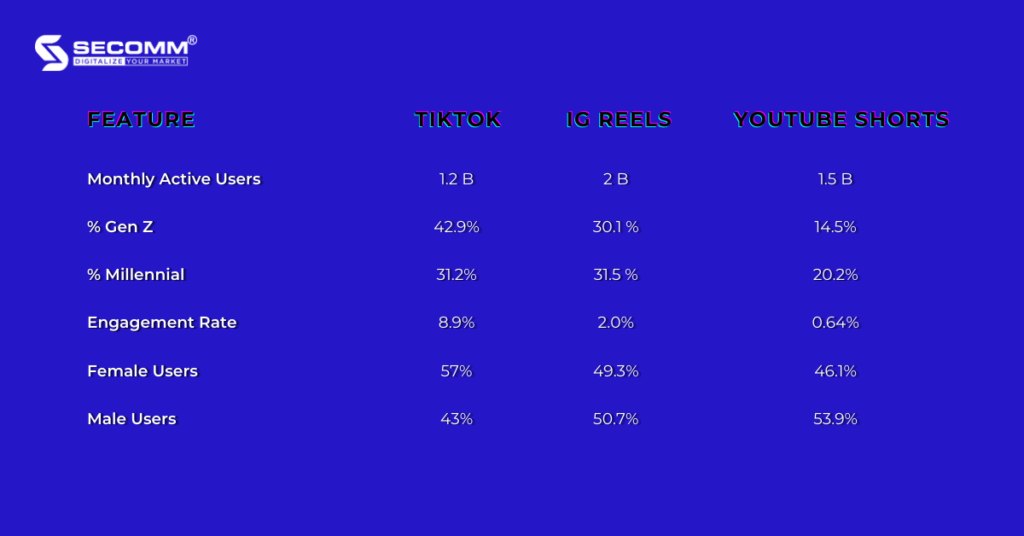
Another thing that makes TikTok special lies in its algorithm. When opening the app, users will see the “For You” page where TikTok displays videos that users may be interested in and immediately capture their attention. However, these videos don’t come from creators or brands that the user is already following but from the users’ interactivities on the videos, which is completely different from other social media platforms.
The “For You” page is the most successful feature of the app as it creates content every second specifically tailored to each user’s personal preferences. These successes have led to a new step for the social platform – TikTok Shop
TikTok explained in its launch statement:
“TikTok Shopping is a suite of solutions, features, and advertising tools that give businesses the opportunity to capture the full power of TikTok’s influence on purchase decisions”
Simply put, TikTok Shop is a new feature that allows TikTok users to buy products right on the app. Also, it provides businesses a way to display, promote and sell their products to a huge user base on TikTok.
After setting up the TikTok Shop feature, a dedicated shopping tab will appear on the brand’s profile. That way, customers can browse through and purchase within the TikTok app or be transferred to the brand’s eCommerce website for checkout.
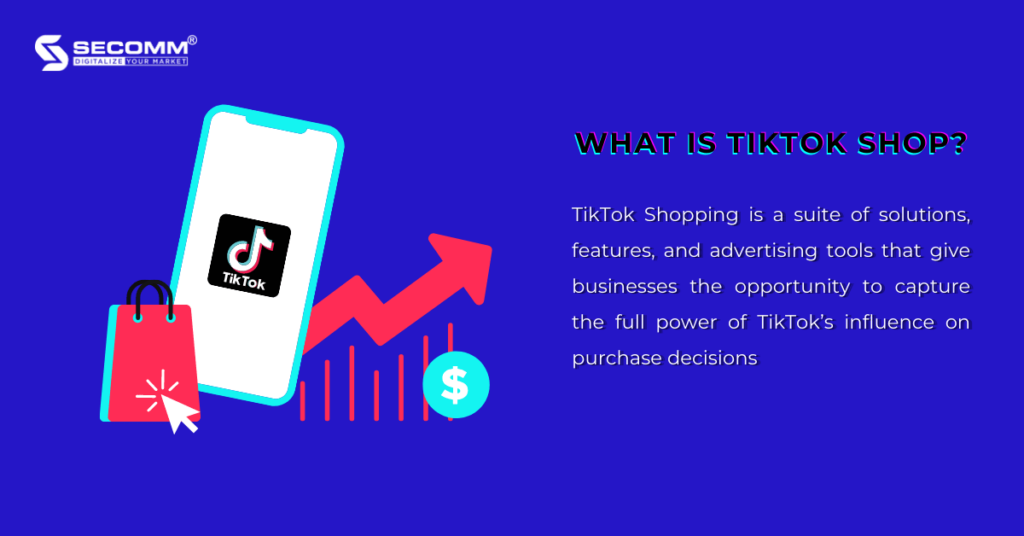
Besides the TikTok Shop feature, TikTok Shop Live is also a great resource to take advantage of. Brands can integrate their products from TikTok Shop into their live stream to encourage customers to interact with the brand and whenever they see a product they like, they can buy it during the live shopping stream.
Let’s see the key TikTok Live Shopping stats:
Ha Linh, a female beauty vlogger in Vietnam, is widely recognized by everyone in the Vietnamese beauty community for her genuine product review videos. She fearlessly provides critical feedback on any brand, and her reputation precedes her. Recently, Ha Linh held her first live stream on TikTok, which incredibly got 11 million hearts and 80K views. To everyone’s surprise, within an hour, all the products from the three factories of the brands she collaborated with were sold out. This case highlights the effectiveness of influencer marketing campaigns in conjunction with TikTok Live Shopping for brands targeting young customer demographics.
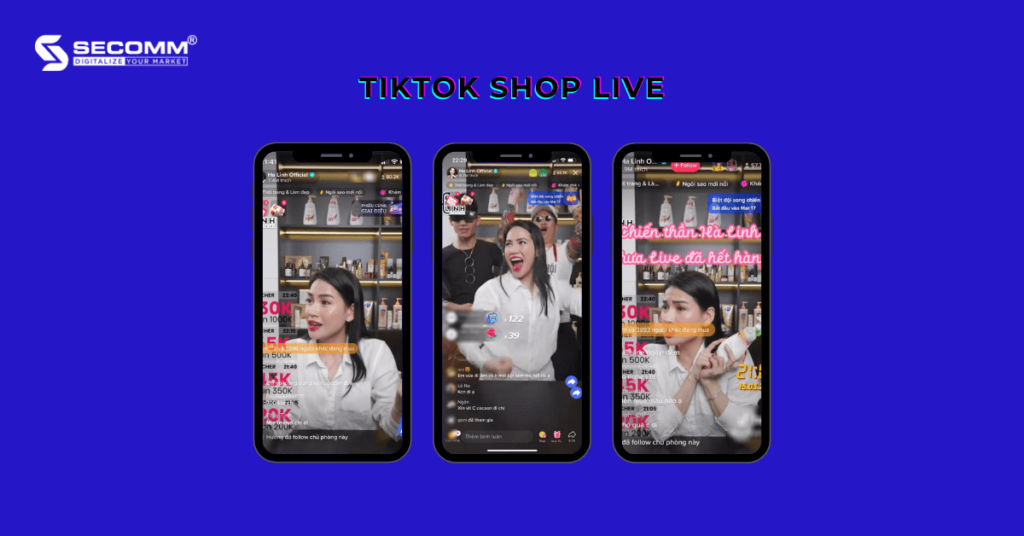
According to research, 87% of customers make their purchasing decisions through information provided on social media, 90% discover brands through social media, and the average spent per day on social media is over 2 hours. This is a new great boost for Social Commerce globally. In 2022, global Social Commerce sales reached $992B and are estimated to exceed $3 trillion in 2026.
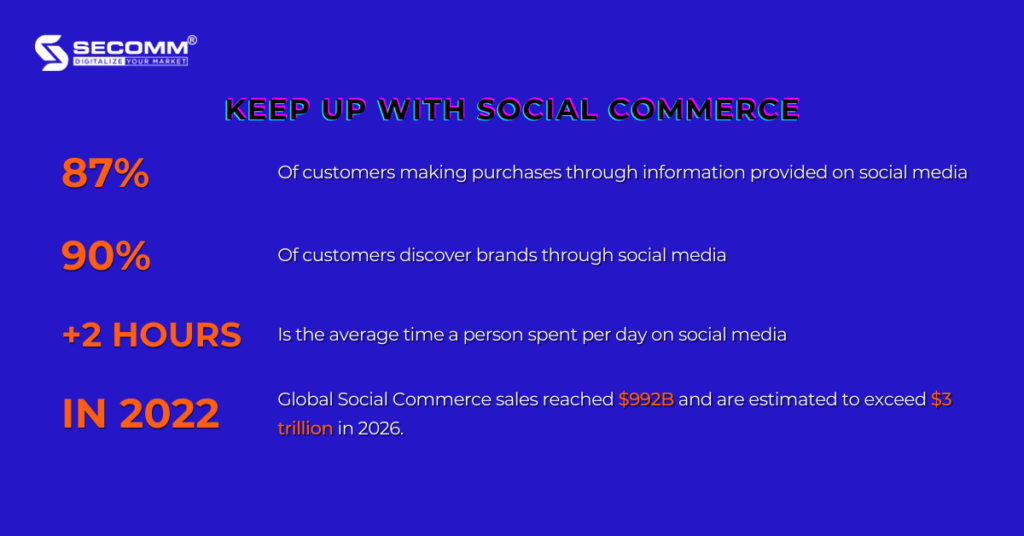
With a massive user base of over 1 billion, TikTok has the potential to become the leading platform in global Social Commerce, and the TikTok Shop feature has been launched to achieve that goal. TikTok Shop is currently available in Europe, North America, and 7 Asian markets, including Vietnam.
The short videos on TikTok are already very appealing, and when combined with cleverly integrated advertising content, they can attract users’ attention. This not only entertains and engages users, but also motivates them to make purchases from the advertised shoppable content. According to data compiled by TikTok, 67% of users have purchased after watching a video even if they didn’t intend to do so beforehand.
Thus, TikTok has created an infinite loop of shoppertainment that combines shopping and entertainment within the app. As TikTok prioritizes user-generated content and 83% of its users have created videos on the platform, after purchasing, they are more likely to share their experience with other people on the app. This ultimately creates an endless loop of shopping, discovery, consideration, purchasing, reviewing, and engaging that repeats itself.
The majority of TikTok users are in the age range of 18-34. According to Statista, as of January 2023:
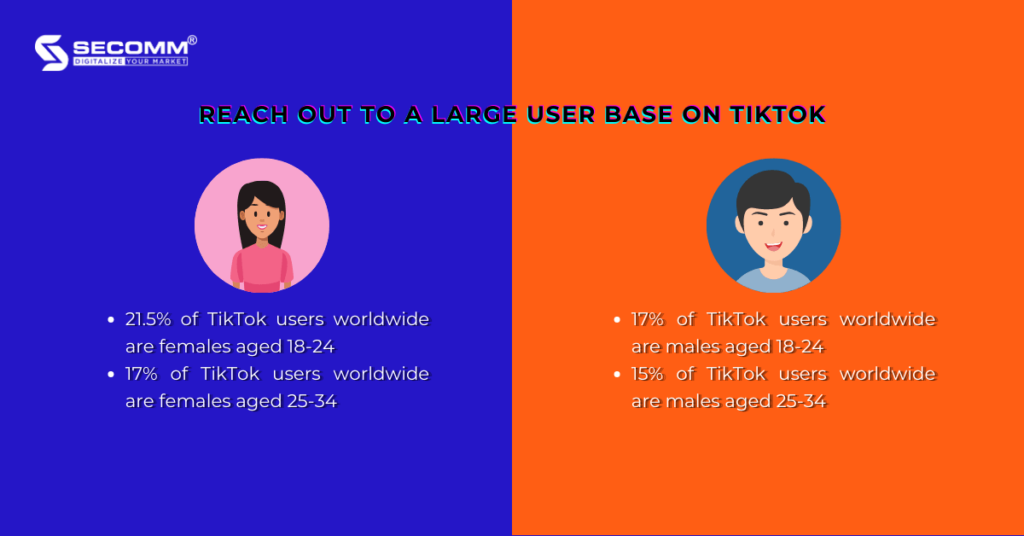
Bên cạnh đó, những danh mục nội dung phổ biến nhất trên TikTok bao gồm giải trí, thể thao/fitness, nấu ăn, mỹ phẩm, thời trang,…
Do đó, nếu các doanh nghiệp đang kinh doanh trong những lĩnh vực này và hướng đến phân khúc khách hàng trẻ tuổi thì xây dựng hiện diện nhanh chóng trên nền tảng TikTok và tận dụng tính năng TikTok Shop là điều cấp thiết phải triển khai, như cách mà Kylie Cosmetics đã làm.
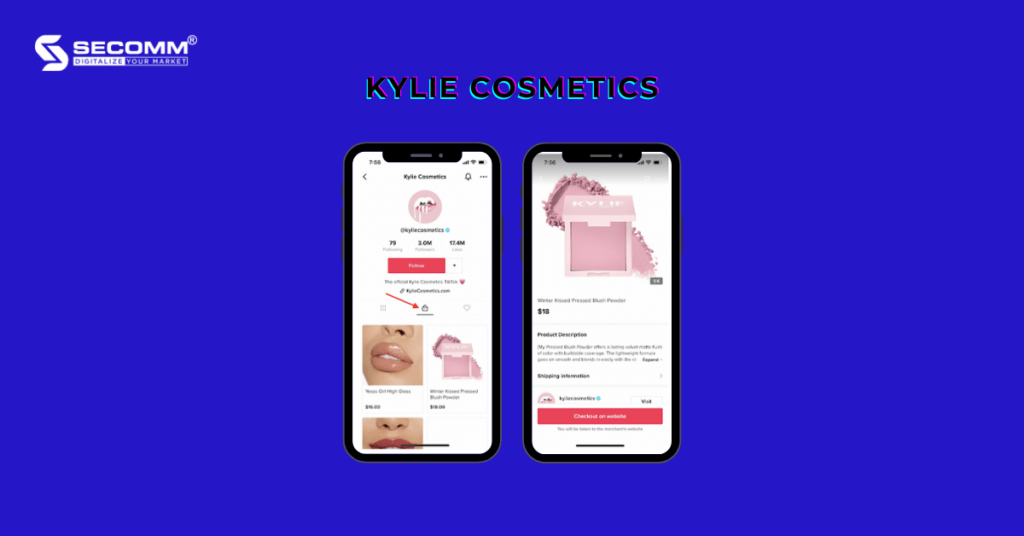
Moreover, the most popular content categories on TikTok include entertainment, sports/fitness, cooking, cosmetics, fashion, etc. Therefore, for businesses operating in these fields and targeting younger customer segments, building a quick presence on TikTok and leveraging the TikTok Shop feature is crucial to implement, as Kylie Cosmetics has done.
As soon as TikTok Shop was launched in the US market, Kylie Cosmetics was one of the first brands to get involved. To date, the brand’s TikTok account has over 3.5 million followers. Kylie Jenner once explained: “I built my business on social media; it’s where my fans go first to look for what’s new from Kylie Cosmetics. I have so much fun creating TikTok videos, and I love sharing posts of my fans using the products. That’s why I’m excited for Kylie Cosmetics to be one of the first to let customers shop directly on our TikTok!”.
If Influencer Marketing plays a crucial role in the brand’s success on other social platforms, TikTok is no exception. This strategy is primarily used to increase brand awareness, run promotional campaigns, and boost sales. TikTok is a place for creative and engaging short videos, so TikTok users have a special love and interest in creators with their unique style and creativity that attracts users’ attention.
TikTok Influencer Marketing is where business brands and personal brands are closely linked. Thus, some experts advise that in order to successfully implement TikTok Influencer Marketing, businesses should let their partners freely create promotional content as long as it meets ethical and cultural standards. This is because if TikTok videos are too focused on advertising, it will make users or potential customers “turn away”.
Walmart, the American retail chain, recently sponsored a dance challenge called “SavingsShuffle”, which required players to show how to save money while shopping at Walmart with their creative fun dance moves, and then post the recorded video on TikTok. Six influencers were chosen to promote this campaign, including Trinity, AdamW, Sam Hurley, Bdash, Kidrl, and Ajani.
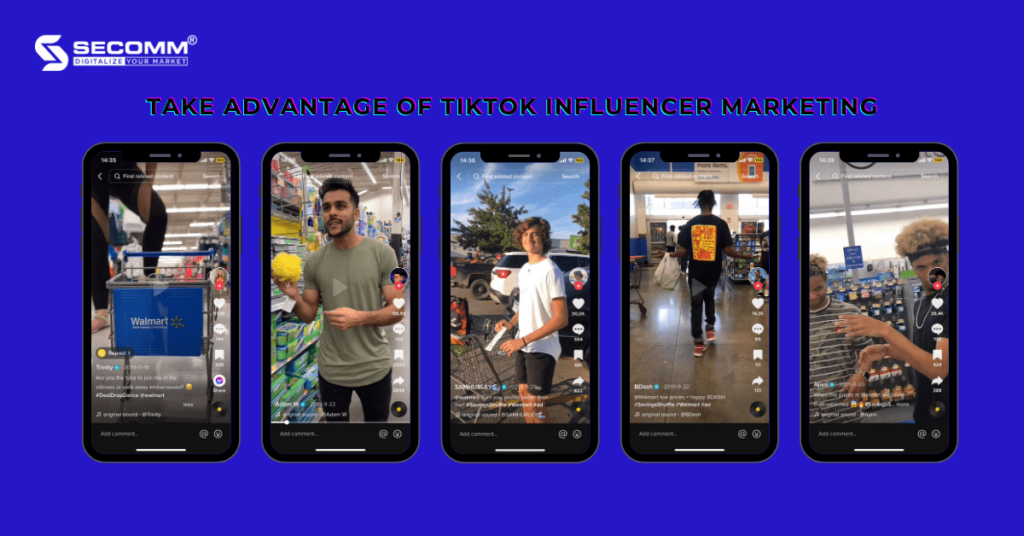
With many years of experience in successfully implementing eCommerce for many customers in many countries, SECOMM understands the difficulties and challenges of implementing eCommerce. Talk to our expert to get free advice on eCommerce implementation.
 2
2
 7,212
7,212
 1
1
 1
1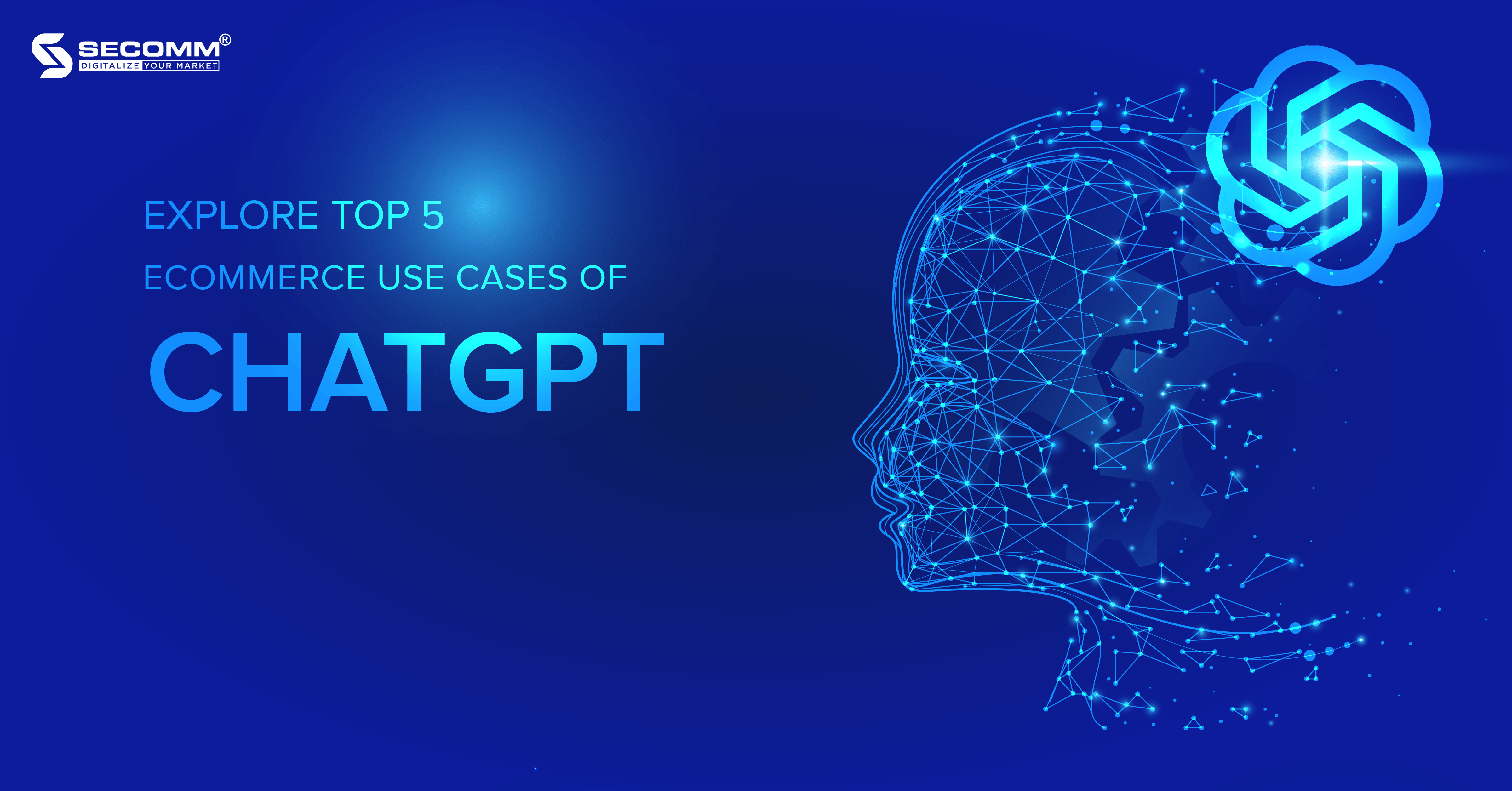
ChatGPT is a new popular AI-powered tool. With the ability to generate human-like text, ChatGPT has a variety of applications in healthcare, education, entertainment, and even in the eCommerce world.
In this article, we will share the top 5 use cases of ChatGPT that business owners can leverage to accelerate their eCommerce.
ChatGPT (Chat Generative Pre-training Transformer) is a large-scale language generation model developed by an AI company called Open AI, which was formed in 2015. ChatGPT is regarded as one of the most advanced language models available today since it can produce human-like text. It can be used for a variety of tasks, including answering questions, creating essays, emails, poems, and even programming.

You can simply use ChatGPT by visiting OpenAI’s website to create an account. Once you’ve logged into your OpenAI account, on the ChatGPT side of the website, you need to read through and accept ChatGPT terms. Then, you can start your conversation with it by asking questions.
Because it is still in the research and feedback-collection stage, it is free to use. But as of February 1, 2023, the OpenAI company launched a new version of ChatGPT Plus in the US for $20/month, while keeping the free version.
ChatGPT runs in a language modeling architecture called Generative Pre-training Transformer (GPT), specifically GPT-3. This type of AI model is trained on vast amounts of information from the Internet, including websites, books, articles, and so forth.

It is fine-tuned using reinforcement learning. Meaning that ChatGPT “learns” from information found on the Internet as well as the user input. Due to Reinforcement Learning from Human Feedback (RLHF), ChatGPT is unique.
RLHF enables human AI trainers to build conversation models in which humans act as both users and AI assistants, according to OpenAI. That helps ChatGPT learn new information rapidly and grow more intelligent.
ChatGPT is a language model to generate conversation with the end users, whereas Search Engines index web pages on the Internet to help users find what they desire. ChatGPT can understand and respond to input information quickly. But, it does not search on the Internet for the information, instead, it uses the training data to generate a response.
Another difference is that ChatGPT’s information update speed is still slower than that of search engines. Some search engines like Google can access the latest information but ChatGPT can only access data up to September 2021. Thus if you ask ChatGPT who is Miss Vietnam 2022, it would not be able to answer while Google could give you an immediate answer in just 0.6 seconds.
Using ChatGPT helps increase revenue and enhance eCommerce business operational effectiveness. Here are 5 great ways to use ChatGPT in eCommerce.

Because an eCommerce website has different product categories, writing a unique description for each product takes a lot of time and resources. ChatGPT can be used to automatically generate compelling product descriptions. This can save time and effort for business owners while still providing customers with high-quality information about the products. Moreover, this language model can create SEO-optimized descriptions that improve product visuality.
For example, a fashion retail brand has launched a new sportswear collection. ChatGPT will generate descriptions focused on moisture-wicking, comfortable fit, and the full range of motion and flexibility. It not only informs customers about the technical aspect of the product but also encourages them to shop with compelling and persuasive words.
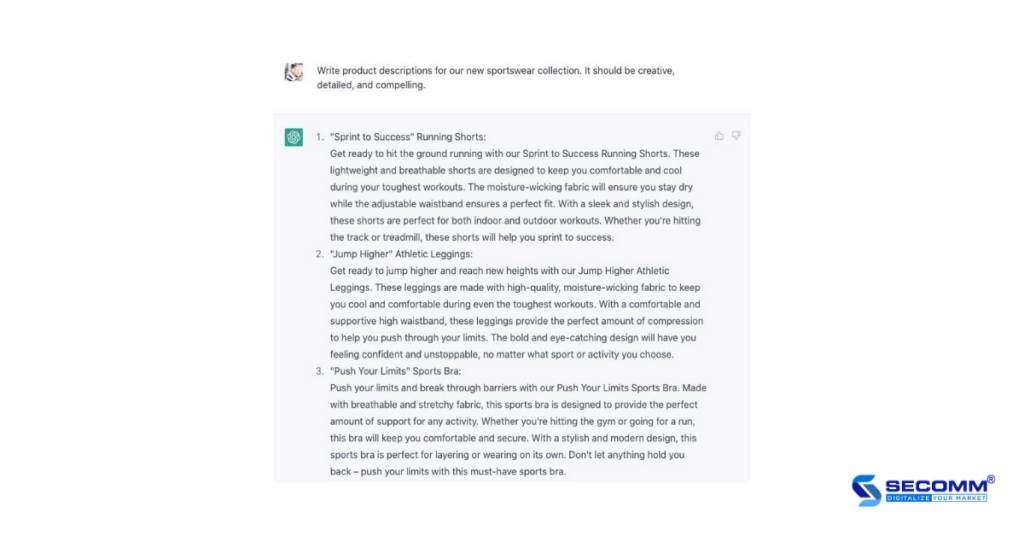
ChatGPT còn được các doanh nghiệp thương mại điện tử sử dụng trong việc đưa ra đề xuất cá nhân hoá sản phẩm. Bằng cách sử dụng dữ liệu khách hàng và lịch sử duyệt web, ChatGPT có thể đưa ra các đề xuất sản phẩm phù hợp cho từng khách hàng cụ thể.
Ví dụ: Gần đây có một khách hàng tên Mỹ đã mua một chiếc áo thun thể thao tại cửa hàng, doanh nghiệp có thể sử dụng ChatGPT để đưa ra đề xuất sản phẩm tương tự mà khách hàng này có thể quan tâm. Từ việc gợi ý sản phẩm phù hợp và cá nhân hoá có thể giúp tăng mức độ tương tác và doanh số bán hàng.
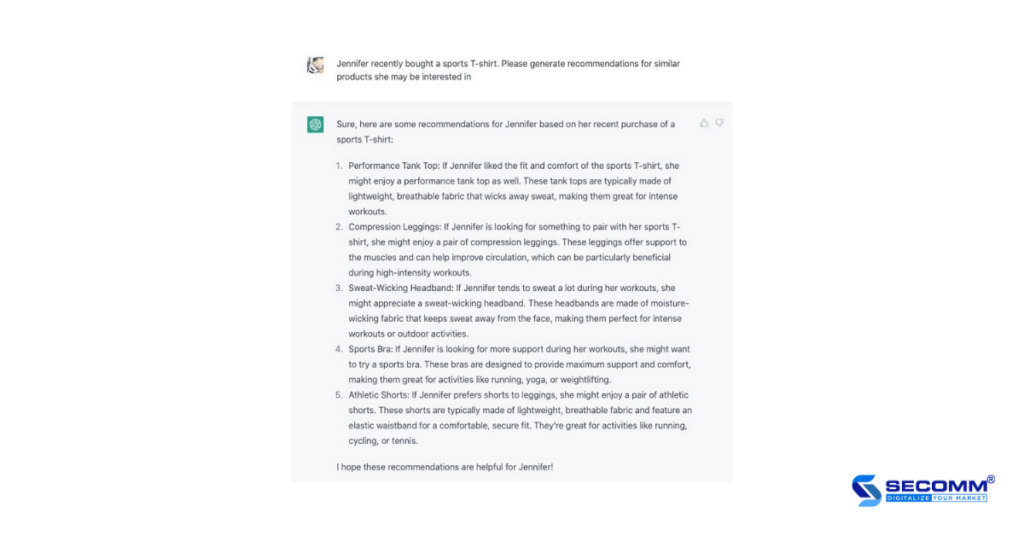
Another way to use ChatGPT is to generate engaging social media content.
For example, a company can use ChatGPT to generate promotional posts on social media platforms to introduce features and benefits of products engagingly and excitingly. Posts can include a caption, image, or video to highlight the advantages of that product. By leveraging the power of ChatGPT, businesses can promote their products and reach new customers on social networking sites effectively.
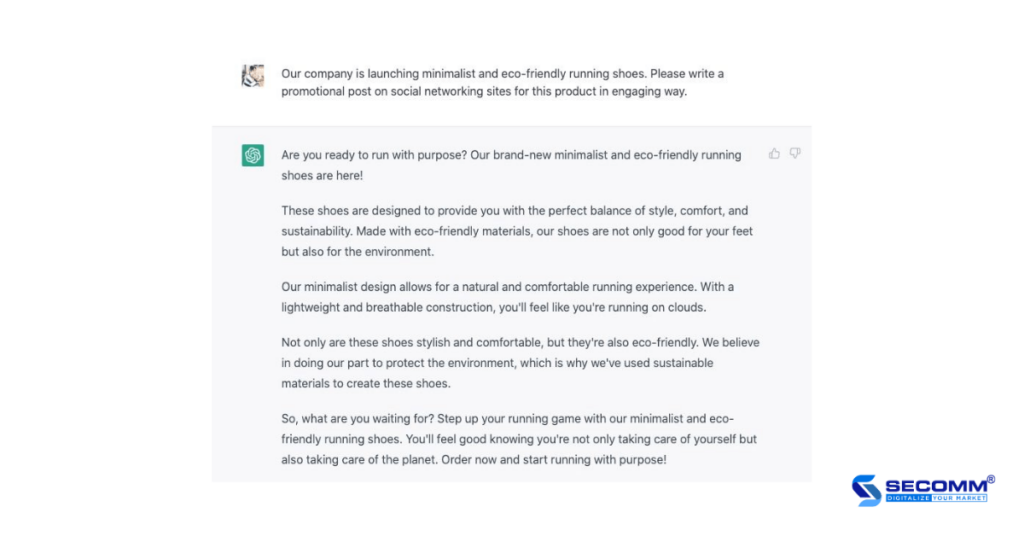
Running email marketing campaigns enables eCommerce businesses to build relationships with their customers, advertise their products and boost sales. By sending personalized ideal emails to customers and prospective customers, businesses can earn customer loyalty and encourage repeat purchases.
ChatGPT can be used in your email marketing campaigns targeting specific customer segments to achieve the desired results.
Example: Jennifer is a regular customer of a sports fashion company. Now the company launches eco-friendly sneakers with a minimalist design. The company uses ChatGPT to compose content for email marketing campaigns to introduce Jennifer to new products and ideal incentives for loyal customers.
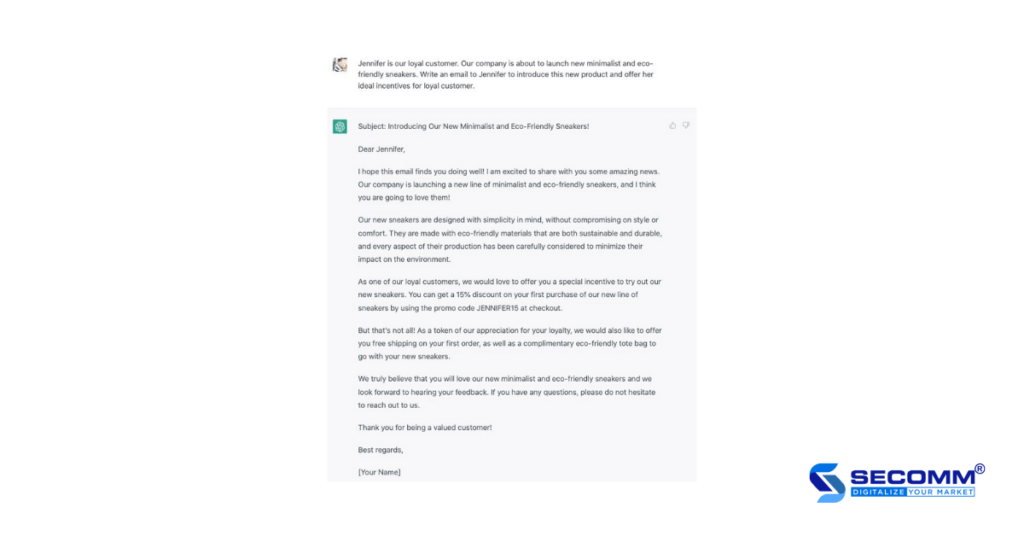
eCommerce business owners can use ChatGPT to handle customer requests in a personalized way. It could be responding to inquiries about order status, product availability, shipping fee, or return concerns. By providing ChatGPT demographic information such as age, gender, and interest, it will immediately generate text for a specific customer in a specific case. That helps increase customer engagement and conversion rate. Businesses will free up time and workload for the team to focus on more important tasks.
For example, if a customer named Jennifer asks for a return process, ChatGPT can generate a response with detailed information including requirements and time for return.
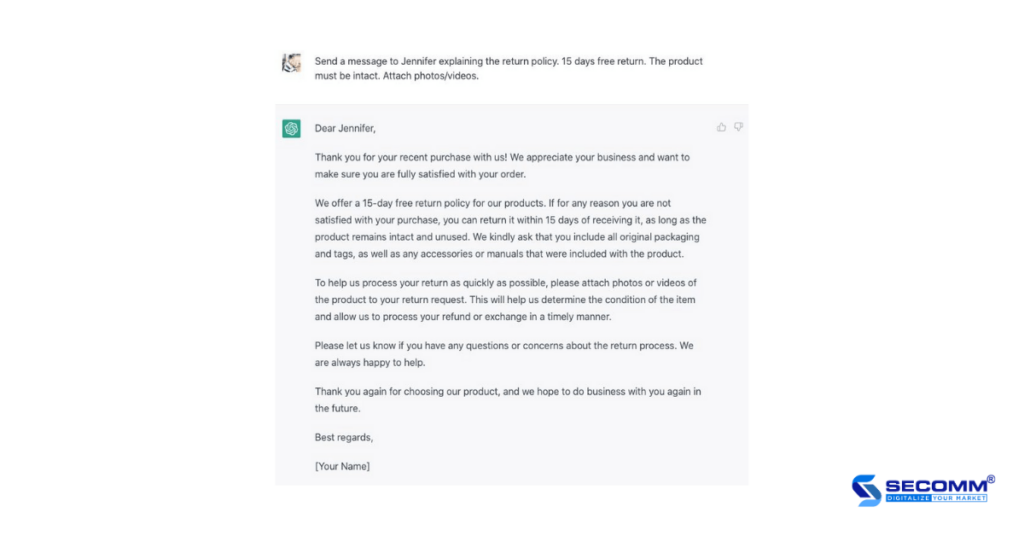
Like every AI-powered tool, ChatGPT has its downsides when used in eCommerce.
Firstly, although ChatGPT helps generate content for marketing campaigns quickly and automatically, it still can’t compete with the original writing by humans. If people depend too much on ChatGPT, their writing will become robotic and clunky which might affect their marketing campaigns the most.
In addition, as mentioned above, ChatGPT is trained by reinforced learning. This leaves room for issues since the information ChatGPT “learned” might not be accurate, hence generating wrong answers for users.
Last but not least, businesses should use ChatGPT with caution. They might want to clarify the information given by ChatGPT carefully before using or publishing their content, which could harm the businesses’ reputation when incorrect or misleading information is used.
Every business owner today can use the five most effective ways to use ChatGPT in eCommerce to stand out from the crowd. Yet, it’s not easy to use it properly and make it an important factor of eCommerce business without being dependent.
Talk to SECOMM now to get started.
 2
2
 4,694
4,694
 1
1
 1
1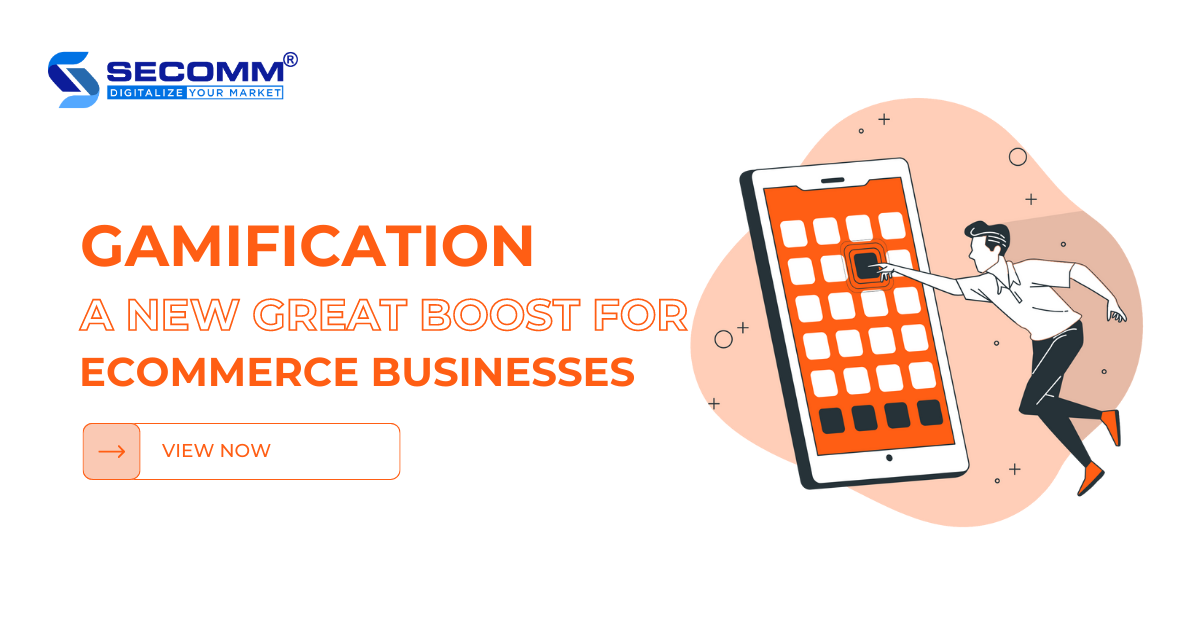
According to Research and Markets, the global gamification market was valued at over 10 million USD in 2020 and is expected to reach more than 38 million USD by 2026.
Gamification is a creative marketing strategy that has recently grabbed the attention of eCommerce business owners who are looking for ways to enhance customer engagement and achieve sales targets. In this article, we will discuss the ways Gamification empowers eCommerce.
Gamification hay trò chơi điện tử ứng dụng hoá, gọi tắt là Game hoá là thuật ngữ chỉ việc lồng ghép khéo léo cơ chế của trò chơi điện tử vào hoạt động marketing một cách sáng tạo, ấn tượng nhằm đạt được mục tiêu marketing đã đề ra.
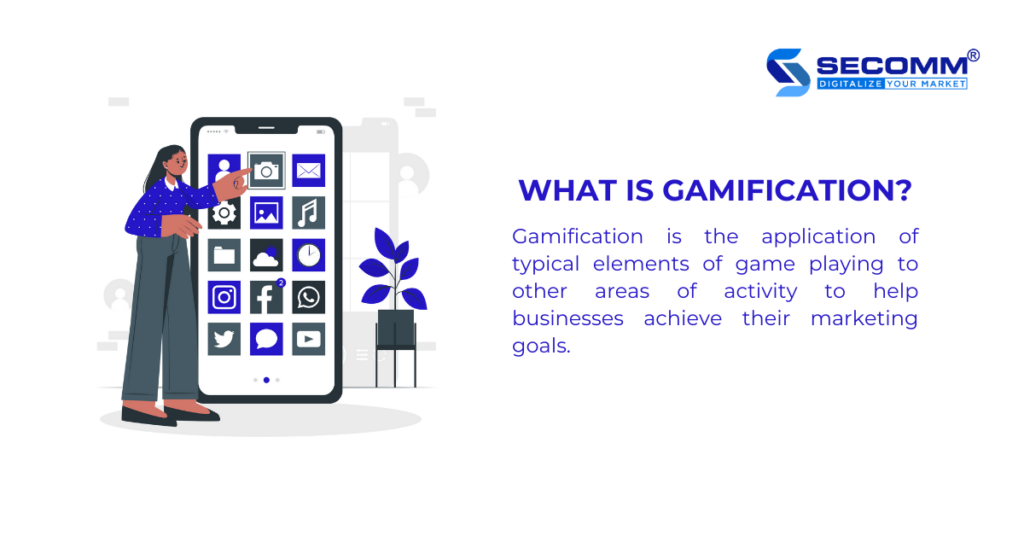
Gamification is the application of typical elements of game playing to other areas of activity to help businesses achieve their marketing goals.
Gamification emphasizes entertainment, making it a fantastic tactic for boosting brand loyalty and encouraging engagement with products or services. In recent years, eCommerce businesses have been accelerating the use of Gamification in the online shopping experience. Because customers today have more options, they also have higher expectations for their purchasing experiences. If an online store offers unique and enjoyable shopping experiences, customers are more likely to make a purchase quickly. Gamification will help eCommerce businesses stand out from the crowd.
Businesses can increase engagement by integrating Gamification into eCommerce websites and making shopping fun and interactive. Recent studies show that the eCommerce Gamification strategy will increase customer engagement by 47%.
Games usually ask players to complete tasks to earn reward points or to win the game (e.g sharing the game on social networks, inviting friends, browsing products, and adding to carts). If the game has some discount codes or vouchers, it will attract more players. That way, an eCommerce business can deliver its brand messaging directly to customers without pressuring or urging them into buying. An enjoyable shopping experience leads to an increased conversion rate.
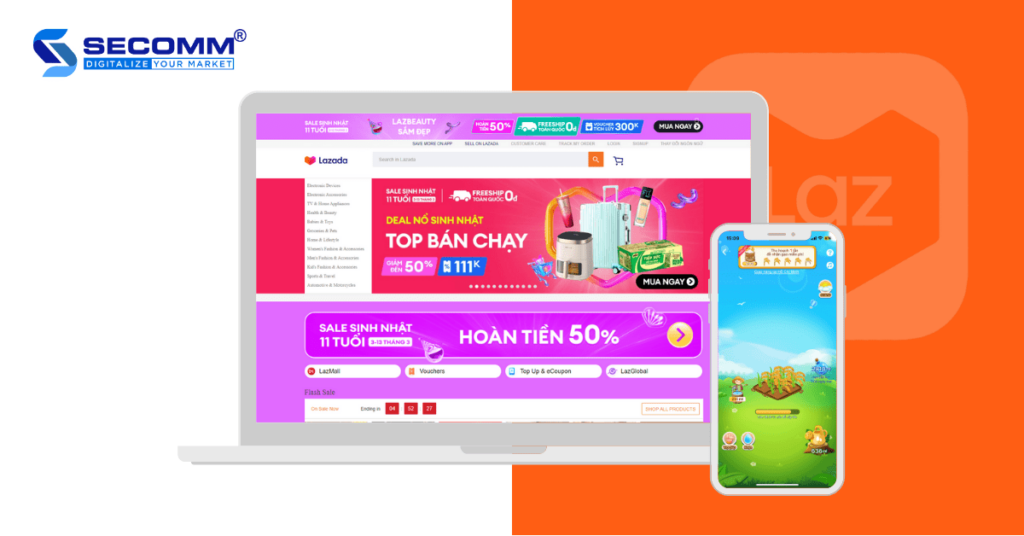
eCommerce Gamification strategy will help businesses boost sales if used effectively. When customers are engaged with the game, they are more likely to win discount codes and use them for later purchases which will make sales increase significantly.
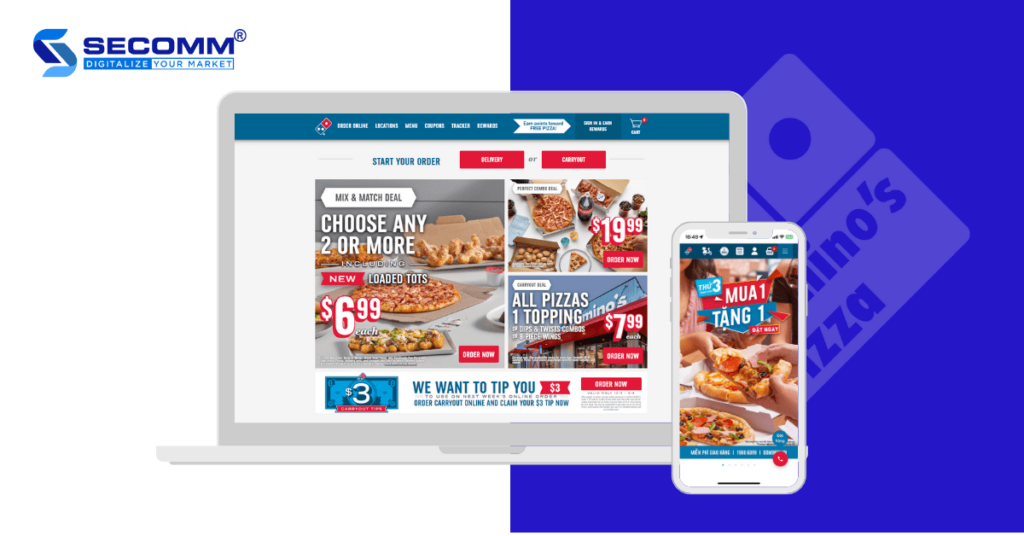
In 2021, Domino’s Pizza, one of the world’s leading pizza brands, increased its sales revenue by 30% with the help of Gamification. This company developed a game called Pizza Hero, in which users will make their pizzas on mobile devices. They can then click “Make an order” to order their pizza creation at a discounted price.
For brands, retaining customers and turning them into loyal customers is important. Gamification can help enhance brand loyalty by creating interesting experiences that encourage repeat visits. If a brand offers points or badges for reaching milestones, customers excited about earning rewards will be more likely to come back and play again. Whenever customers have shopping needs, they will recall and choose that brand.
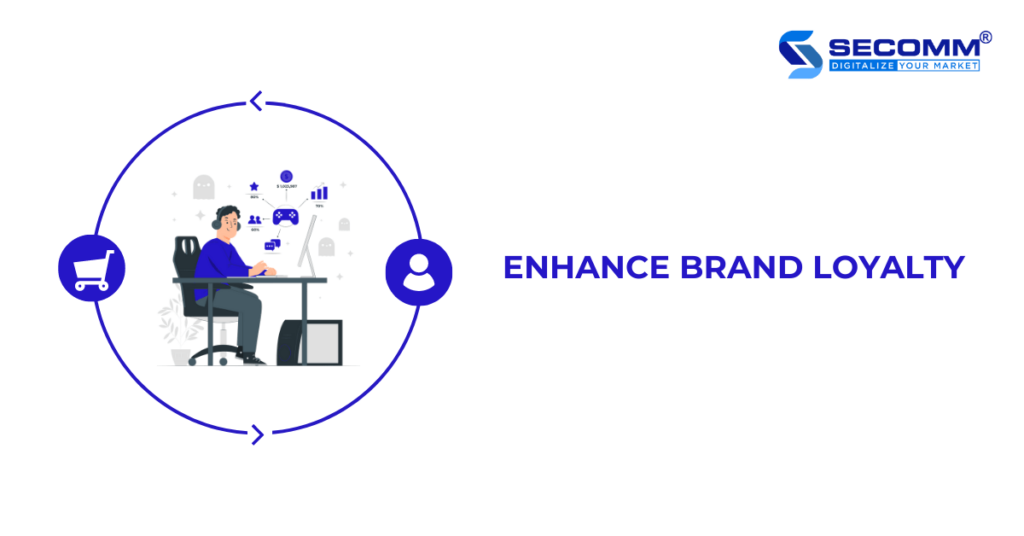
Although Gamification helps increase customer engagement, boost sales, and enhance brand loyalty, it still has potential drawbacks that eCommerce businesses should keep in mind before implementing it.
Developing amazing games requires creativity. Basic games like Quiz or Spin The Wheel are easy to create. These game experiences are too common among users so it’s unlikely to generate conversion. Hence, every business needs to get professional advice from creative agencies to design and develop engaging games that catch the eyes of users. However, it costs a lot of time and budget.
For example, creating a game with a variety of sound effects, images, videos, or personalized animated elements that enrich the user experience will increase the cost of implementation.
Among brands that have had success using Gamification, Starbucks would be the first one mentioned. Coffee brands usually offer vouchers or loyalty cards to encourage customers to return next time. Breaking out of the old rut, Starbucks developed a special game for its customers – “Flip the Cup”, in which the player chooses his favorite drink and could use one hand to flip the Starbucks cup. Each time, the player has 10 flips and each successful flip gets 10 points. Then, with the points achieved, the player can choose to play again or download vouchers. This exciting experience boosted engagement by 90% and the number of downloaded vouchers exceeded the targets by 110%.
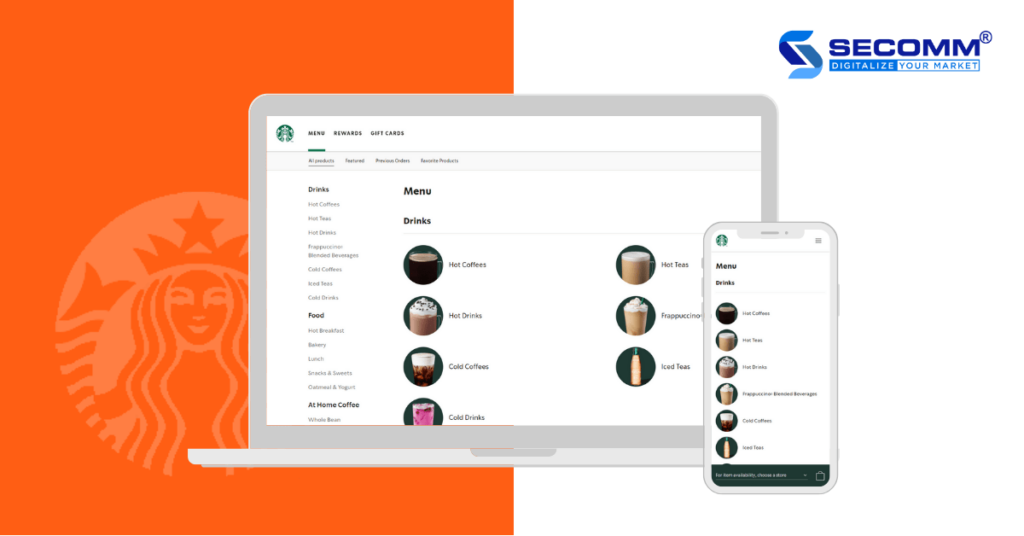
As mentioned above, Domino’s Pizza first entered the market in 2012, and that same year the company also launched Pizza Hero, the first game that gave pizza lovers a new way to order. In case they don’t know what to order, they can shake their mobile devices to ask the app for suggestions. Especially, users can customize their pizzas, find coupons, place orders at a nearby store, and track order progress right on their devices.
By using this strategy, Domino’s was able to boost online sales by 30% and achieve $1 billion in the US market alone. Pizza Hero received 140,000 downloads in the first two weeks after its debut, propelling it into the top 15 Lifestyle ranking on Google Play and the iTunes Store. Moreover, Pizza Hero and Domino’s Pizza both won the praise of Forbes, the most prestigious magazine in the world.

Gucci has taken eCommerce Gamification to a new level. Gucci Arcade is one of the fashion giant’s Gamification strategies to attract the attention of Generation Z. It offers customers amazing games to engage with such as Gucci Bee and Gucci Ace. This experience helps Guccis reach a wide pool of potential Gen-Z customers.
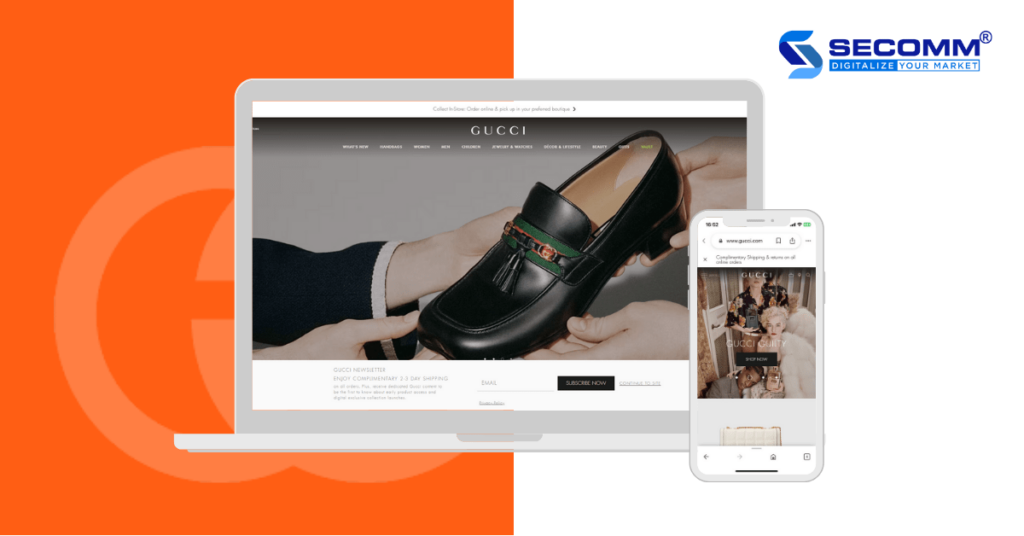
Gamification is a strategy that strengthens the development of eCommerce. It has become popular in the world as well as in Vietnam. Every business owner needs to seriously recognize its potential and plan for rapid implementation.
Talk to SECOMM today to get expert advice on eCommerce Gamification.
 4
4
 2,862
2,862
 0
0
 3
3
According to CommonThread, the global cosmetics eCommerce market size is valued at 483 billion USD in 2020 and grew to 511 billion USD in 2021 at a compound annual growth rate (CAGR) of 4.75%. The market size is anticipated to surpass 716 billion USD by 2025 and reach 784.6 billion USD by 2027.
The amazing growth rate of the online cosmetics sector demonstrates both the industry’s enormous potential to grow and its significant contribution to the global economy. Cosmetic companies must encourage the development of eCommerce websites to enter the market rapidly and take control of it in order to keep up with the economic trend as a whole.
It takes time to develop an online store for cosmetics, and SECOMM has detailed and analyzed the two key stages of the process.
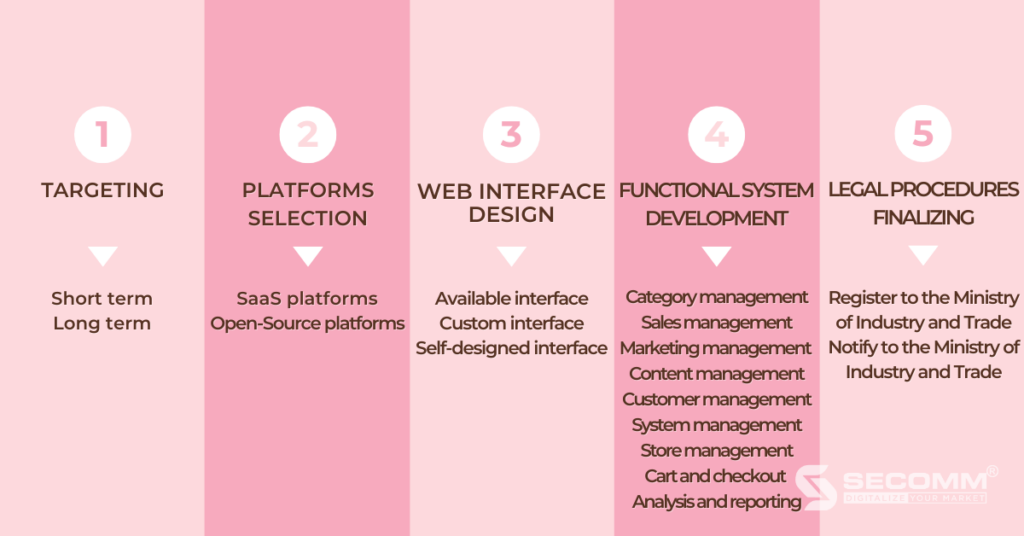
The first important thing a cosmetic business needs to do is to set goals and prioritize those goals in the short and long term.
In the short term, promotional activities, monitoring, analyzing, and measuring the effectiveness of marketing campaigns, especially user experience should be the top goals that need to be promoted.
In the long term, cosmetics eCommerce businesses should focus on increasing brand recognition and online business capabilities of their products.
At this stage, businesses do not have much data to analyze and evaluate for the whole process, so they can listen to a lot of advice from specialized eCommerce implementation consulting units with a lot of experience in long-term consulting to get the right list and priority of goals for both this period and beyond.
In today’s market, there are two types of platforms that are dedicated to building eCommerce websites, including SaaS platforms and Open Source platforms.
SaaS platforms
Service as a Software (SaaS) is a service-based software application distribution model for eCommerce business purposes.
In other words, the provider creates and maintains software to help build an eCommerce website and the business will pay a certain cost to use this service.
With SaaS, the entire website system is hosted on the provider’s server, so ownership and control of the source code and data will belong to the provider.
This means the SaaS service provider will be responsible for handling and fixing technical problems arising during the cosmetic eCommerce implementation.
Some of the popular SaaS platforms today are: Shopify, BigCommerce, Salesforce Commerce Cloud, etc
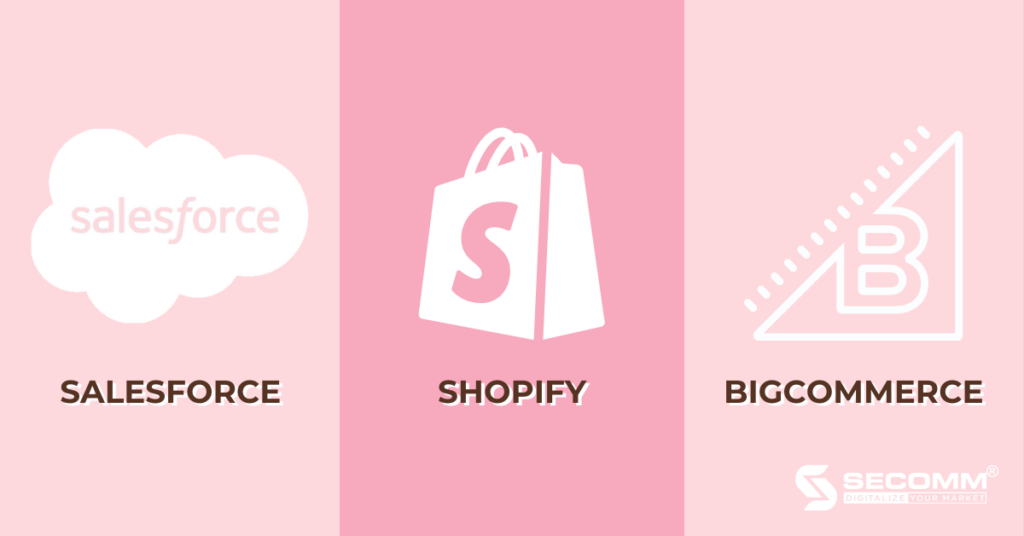
Open-Source platforms
An Open Source platform or an open source platform is software with a widely released source code that allows users to download, modify and upgrade necessary features for eCommerce business purposes.
The platform is often developed by a community of developers rather than a single company.
Moreover, this will be the ideal platform for implementing complex eCommerce website systems, specific to many fields including cosmetics thanks to in-depth customization functions.
This means that businesses need to cooperate with professional eCommerce website builders or develop a team of highly qualified internal staff to operate the website effectively.
The most prominent Open Source platforms on the market today: Magento, OpenCart, WooCommerce (WordPress Plugin), etc.
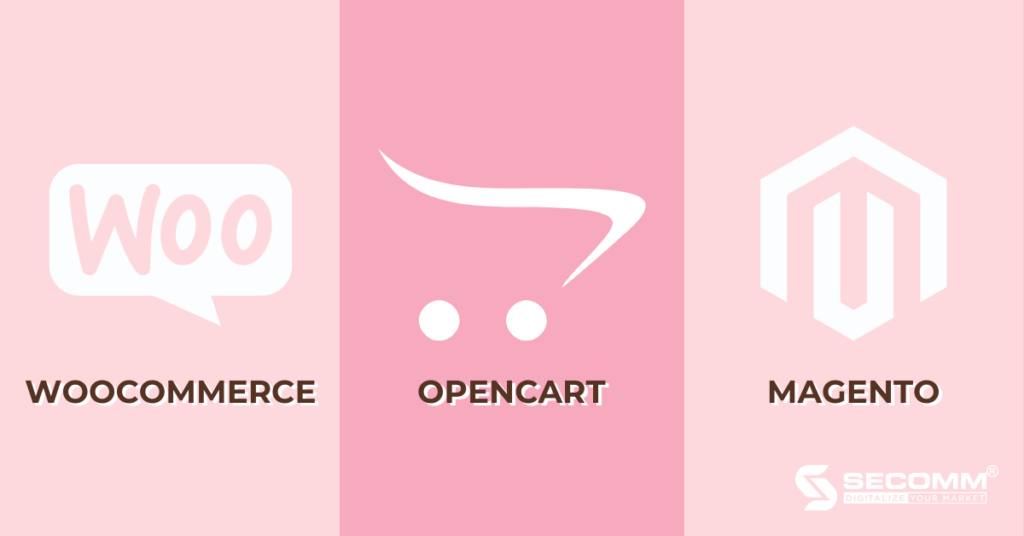
At this stage, businesses should choose a SaaS platform to start with to familiarize themselves with the eCommerce business as well as save budget for more important investments such as marketing,…
Then, when entering the second stage, the business scale has now grown and expanded, and switching to the Open Source platform is now necessary and reasonable to achieve the goal of eCommerce growth.
After choosing a platform to build a cosmetic eCommerce website, the business will design the website interface so that the standards of UI/UX are met in order to optimize the website, showing the characteristics of the brand and cosmetics industry.
So, businesses can choose one of the following three ways to design an eCommerce website interface:
Usually, in stage 1, businesses should only use the available interface or customize based on the available interface because the basic functionality system needed, most of the interfaces provided are already there.

In the first stage, businesses should prioritize developing the basic functional system needed for a complete cosmetic eCommerce website, specifically including:
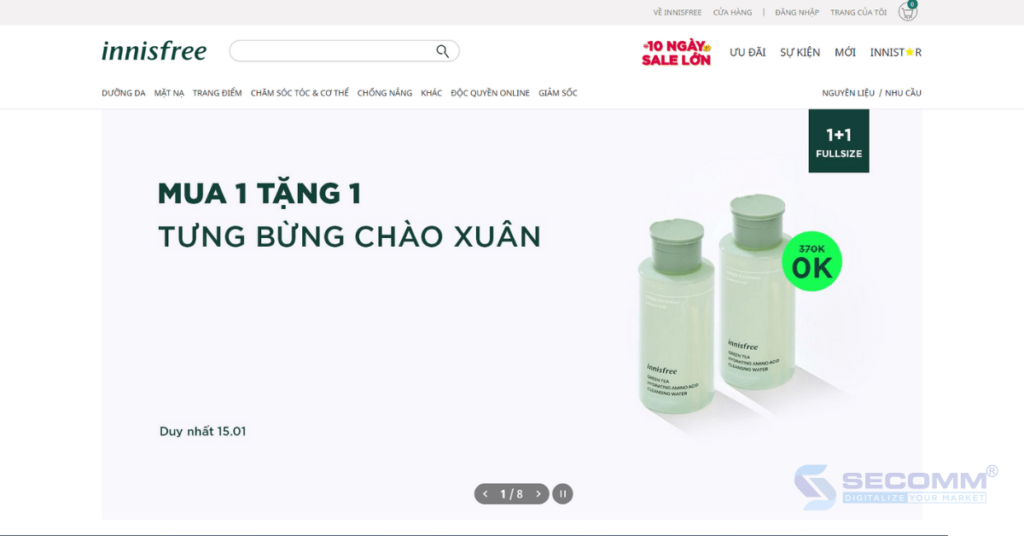
Functional system development
The final step of building a basic eCommerce website is completing the necessary legal procedures for the website to be allowed to operate legally.
Businesses can follow the simple registration steps as instructed at the eCommerce Management Portal.
This is a mandatory requirement of the Ministry of Industry and Trade for every individual or organization that owns an eCommerce website to sell goods and to perform the registration/notification obligation on time.
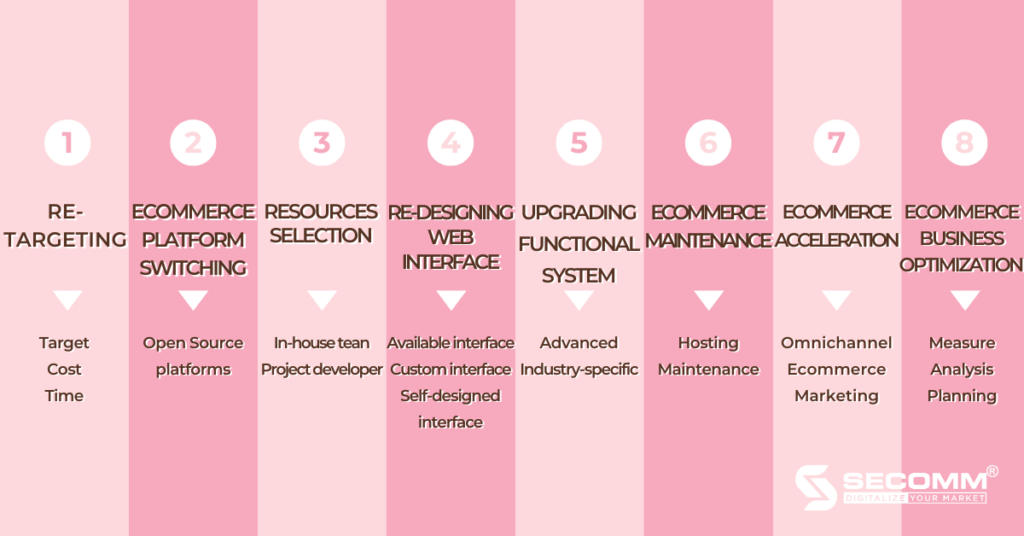
Along the business development journey that comes with the constant change of consumer behavior, business goals, and strategies need to be adjusted and re-established to match the current context of the eCommerce market. In addition, at this stage, businesses also have problems, data, and insights about online users, so setting goals will be easy.
In the short term, businesses can prioritize finding and attracting potential customers and growing online sales with effective marketing.
In the long term, a cosmetic business can consider the goal of expanding the market segment by identifying the target market segment and making a marketing strategy in accordance with the product characteristics and the direction of the business in the second stage.
In addition to short-term and long-term goals, businesses need to focus on considering the time and cost of investing in the cosmetic eCommerce website system because, at this stage, the cost and investment budget will often be large. much more than the basic construction phase above.
In the beginning, cosmetics businesses are advised to develop their initial eCommerce websites using SaaS platforms. However, the restricted capability and customizability of SaaS won’t be able to satisfy that expectation given the second phase’s objectives of growth and scalability.
To create more specialized cosmetic eCommerce websites at this moment, companies can think about moving to Open Source platforms with respected names like Magento, WooCommerce, etc.
Some suggested criteria to consider when choosing an Open Source platform:
Besides that, businesses should be aware of the costs associated with switching from a SaaS platform to an Open Source platform, the time required for staff to learn on the new platform, the danger of data loss, and any issues that may occur.
Unlike the basic eCommerce website building stage, in the second stage of the implementation process, businesses need to choose resources for development. Businesses can build an internal team or seek support from a specialized developer.
The business will hire and train skilled and specialized IT people on the chosen platform for internal team growth. In this case, it will require a lot of time and money from the company, but it will aid in better resource management, control, and active adjustment to develop the eCommerce website system in accordance with the original aim.
Businesses frequently work with a variety of firms to find “true love” in their collaboration with eCommerce website developers. As a result, businesses will receive the eCommerce websites they need as expected, the collaboration process will go smoothly, and businesses will gain more expert knowledge and website development experience from a partner, which will point them in the right direction in terms of the cosmetic eCommerce industry’s development trends.
These are the criteria that businesses should consider when choosing: In-depth knowledge and experience in eCommerce and the cosmetics industry; professional working team; clear and detailed working process; ability to quickly handle problems that arise during website development.

Businesses are not required to update the website interface while switching platforms. Redesigning the website interface to work with the Open Source platform, however, is today recognized as a wise company development approach that was introduced simultaneously with the deployment of advanced eCommerce websites.
Similar to the previous period, businesses have three options for designing e-commerce website interfaces, including using the available themes, customizing based on the available themes, and designing their own interface.
Usually, at this step, businesses should choose method 2 or 3 to design the interface to ensure the uniqueness of the brand and the specificity of the cosmetic eCommerce industry.
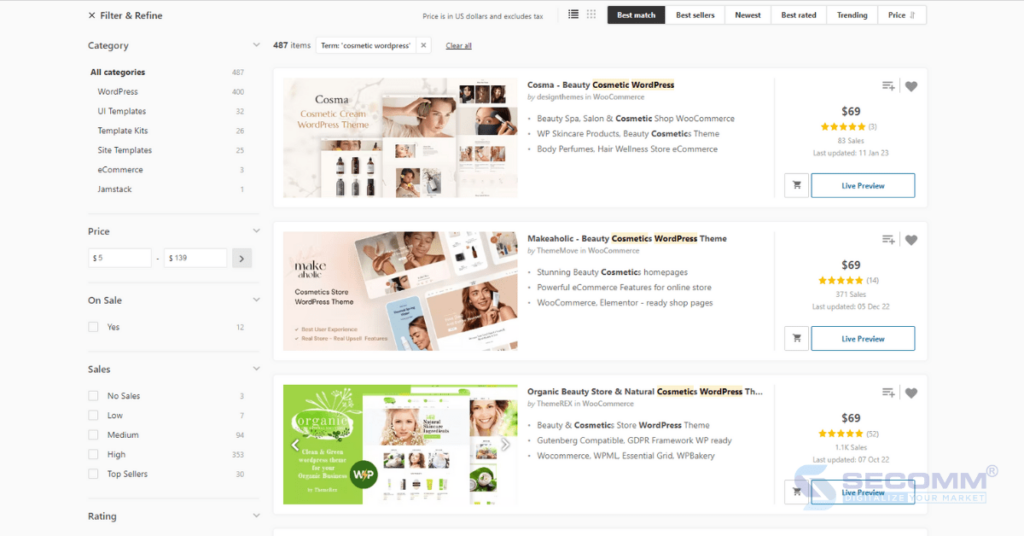
In addition to the basic functions that have been built for the eCommerce website system in stage 1, businesses should concentrate on developing a system of advanced and specific functions for the cosmetic industry in the later stages.
Today, several well-known cosmetic brands embrace AR (Augmented Reality) technology to improve the customer experience. Customers can now download the AR software, activate the camera, and sample the goods online rather than going physically trying it on in the store to see whether it will fit their face.
The Kylie Virtual World application, for instance, offers users an engaging product experience. Users of the newly released Kylie Cosmetics items, such as eye cream, foundation, and lipstick, can sample the product out in 360 degrees by using their phones to scan the QR code.
A sophisticated eCommerce website system demands a great deal of experience and effort to operate and maintain. This is the procedure of continuously maintaining, updating, and upgrading the entire system to aid firms in foreseeing and resolving problems (for example, sudden increase in traffic from the promotions that stimulate shopping).
That supports sustained and persistent online sales growth, which is important for eCommerce businesses in general and furniture eCommerce in particular as they compete for a market share of this “pie,” which is “delicious” but can be challenging to consume.
Furniture eCommerce enterprises readily accomplish growth above and beyond expectations by putting into practice efficient business and marketing strategies.
Therefore, the entire process—from planning through implementation—must be structured with effective, practical solutions that have been demonstrated to work. Implementing Omnichannel, eCommerce Marketing, and SEO optimization are some suggested methods for eCommerce enterprises to accelerate growth.
The journey of developing an eCommerce website ends with measuring, analyzing, and optimizing eCommerce business activities.
Businesses can use analytics tools such as Google Analytics, Google Tag Manager, Facebook Pixel, etc., to track, update and measure website performance metrics as well as the effectiveness of marketing campaigns.
From there, the eCommerce business strategy for the next stage of development will be carefully and methodically planned thanks to clear and detailed reports & analysis.

The journey of building a cosmetic eCommerce website with two stages from basic to advanced has been outlined in detail with meticulously analyzed implementation steps. Businesses in the industry can refer to it to draw their own development journey in this potential field.
With many years of experience in successfully implementing eCommerce for many customers in many countries in recent years, SECOMM understands the difficulties and challenges in the process of implementing an interior eCommerce website.
Contact SECOMM today for free support and advice.
 2
2
 2,539
2,539
 0
0
 1
1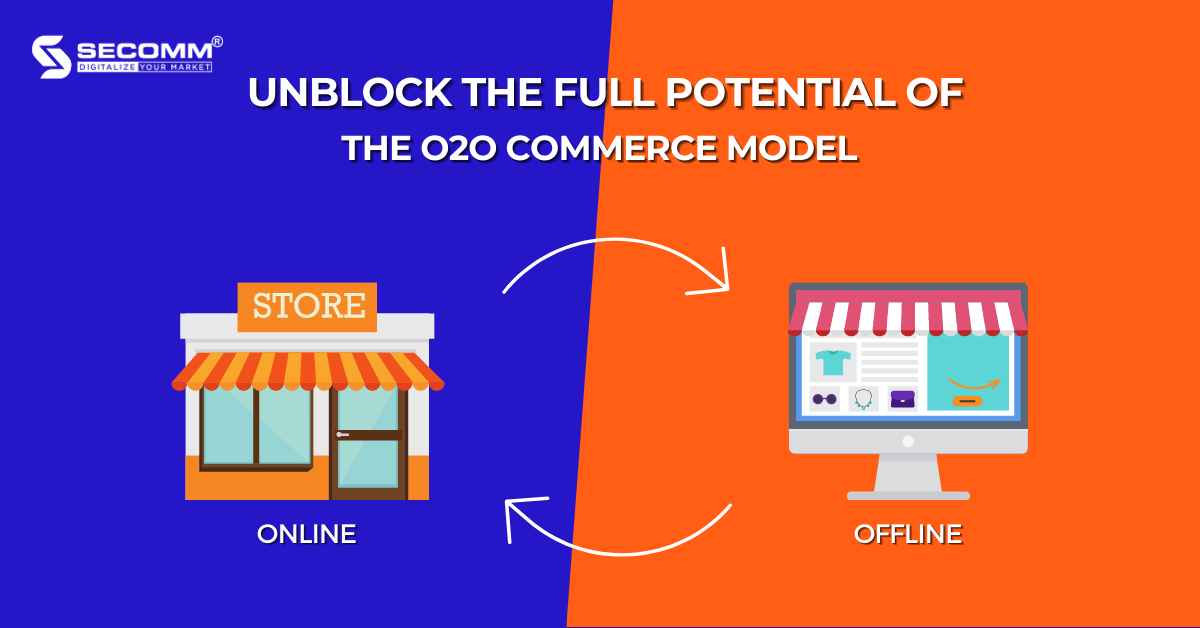
After Covid, eCommerce is on the rise and is expected to continue to thrive stronger and more resilient than ever. Global retail eCommerce sales reached $4.9 trillion in 2021, as stated by Statista. By 2025, this figure is projected to increase by 50% to approximately $7.4 trillion and there is no sign that the growth of online shopping will slow down anytime soon.
The expansion of eCommerce has raised concerns among physical store owners and urged them to embrace eCommerce quickly to avoid being left behind. It’s simple for businesses with a large budget, but other small and medium-sized businesses will not be able to move their entire operations online. Thus, the O2O Commerce model is the solution worth considering. Its popularity has been raised since 2021 and is expected to reach retailers soon.
O2O or Online-to-Offline Commerce Model is a business strategy that draws potential customers from online channels to make purchases in brick-and-mortar stores. This model aims to create a seamless shopping experience at all stages: before, during, and after purchasing.
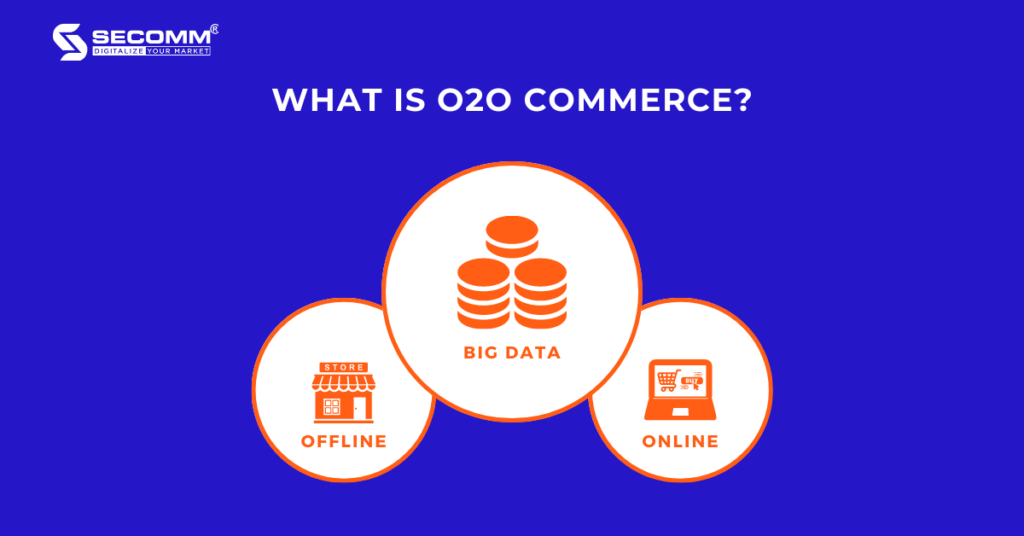
O2O Commerce combines online and offline business models. Its objective is to increase product awareness online, allowing customers to search for what they need before visiting a physical store to make a purchase. There are some O2O strategies that businesses can try including Buy Online Pick-up In-store (BOPIS), In-store Returns, Home Delivery, etc
For example:
That way, the customer can both take advantage of the discount code for the shirt, and try it on at the nearest store without having to wait for delivery. Moreover, he can completely return the shirt immediately and go to another store if he is not satisfied.
Home Delivery is also another popular strategy in the O2O world. It will take a few hours or a day. So, the man can buy his shirt online, select the home-delivery option and wait to get it. In another case, when going to the store to pick up the shirt, he sees and likes a jacket but needs help finding the right size or favorite color. He simply places an order online while in store and that desired jacket will be delivered to his door.
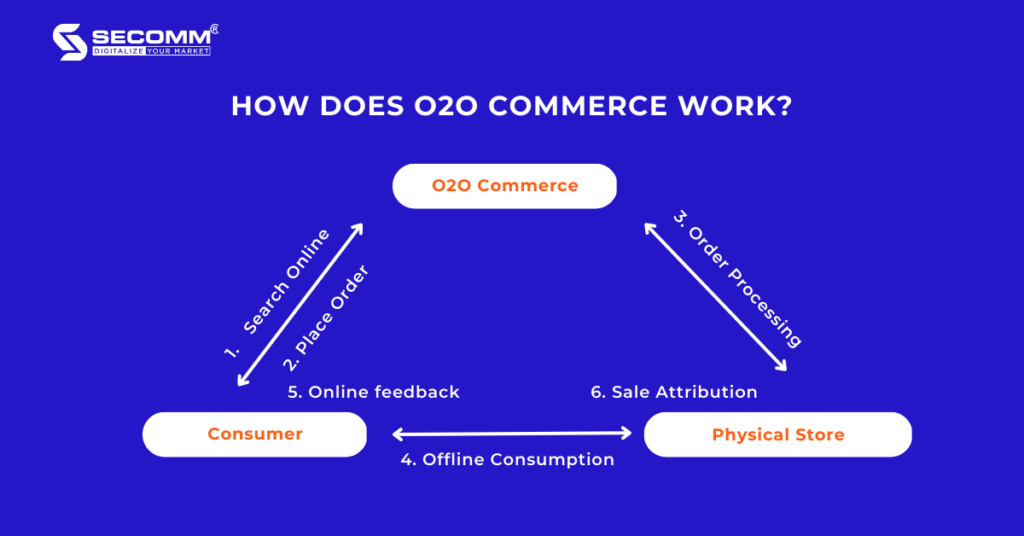
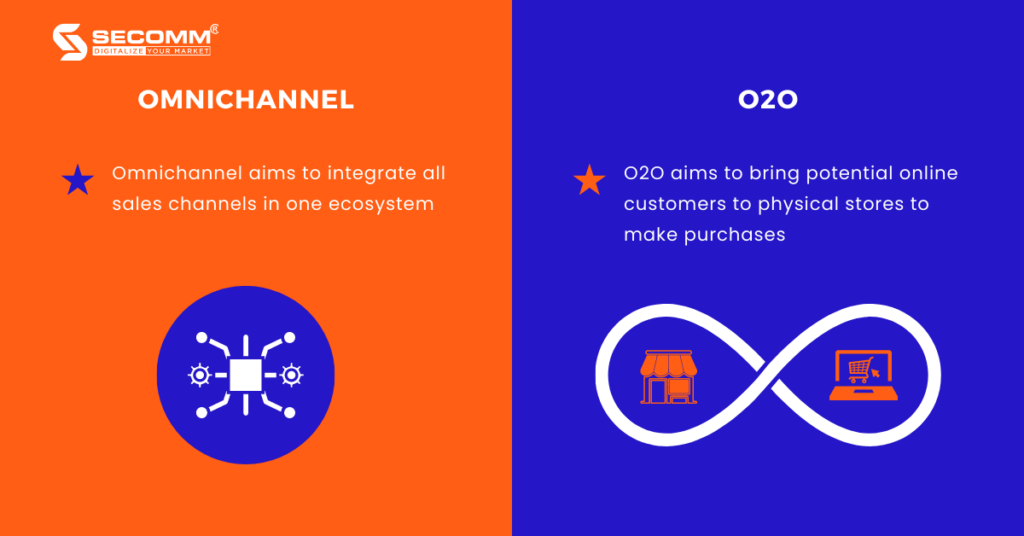
The example above may confuse the O2O commerce model and the Omnichannel commerce model. Although they both facilitate a more seamless shopping experience among channels, their main goals are quite different. While Omnichannel aims to integrate all sales channels in one ecosystem, O2O aims to bring potential online customers to physical stores to make purchases. Both strategies are designed to bridge the gap between online and offline sales, but O2O prioritizes a specific buying journey instead of multiple touchpoints in Omnichannel commerce.

One of the brands that understand what they are doing to connect in-store shopping with online shopping in a tight way is Topshop. By partnering with eCommerce website ShangPin to open retail stores in malls, with giant iPhones decorated in Topshop style, customers can access “The Mobile Adventure” by scanning a QR code to view and try on virtual Topshop fashion products in the store. Then they share their look on social media and place an order.
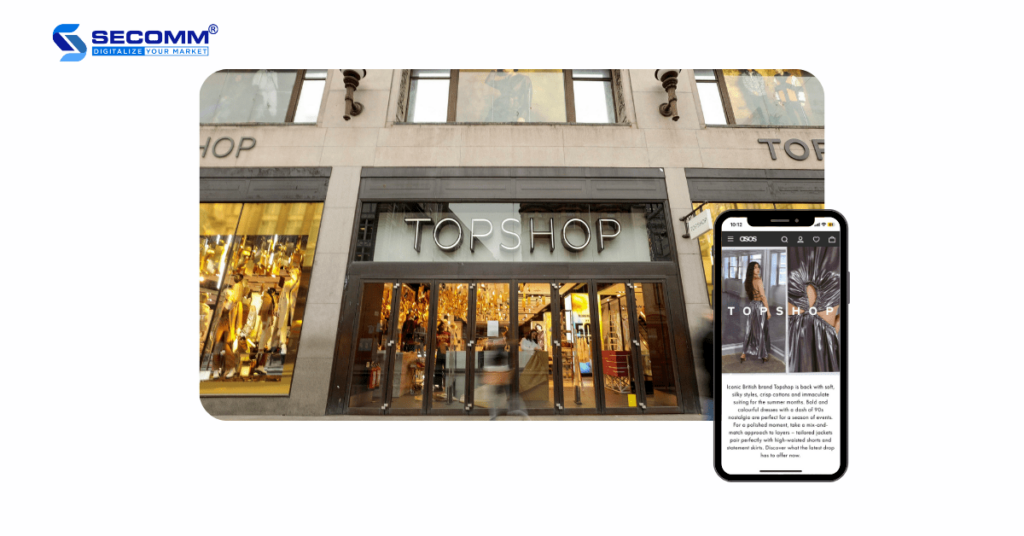
When it comes to fashion, Tommy Hilfiger has shown his agility when deploying the O2O model. In 2015, the brand launched digital showrooms, pioneering the fashion industry’s digital revolution. In 2016 they launched a chatbot through Facebook Messenger and in 2017 they launched the Hilfiger Club app with a loyalty program of personalized special offers and invitations to the brand’s events. All of that gives customers a good reason to come to the store.
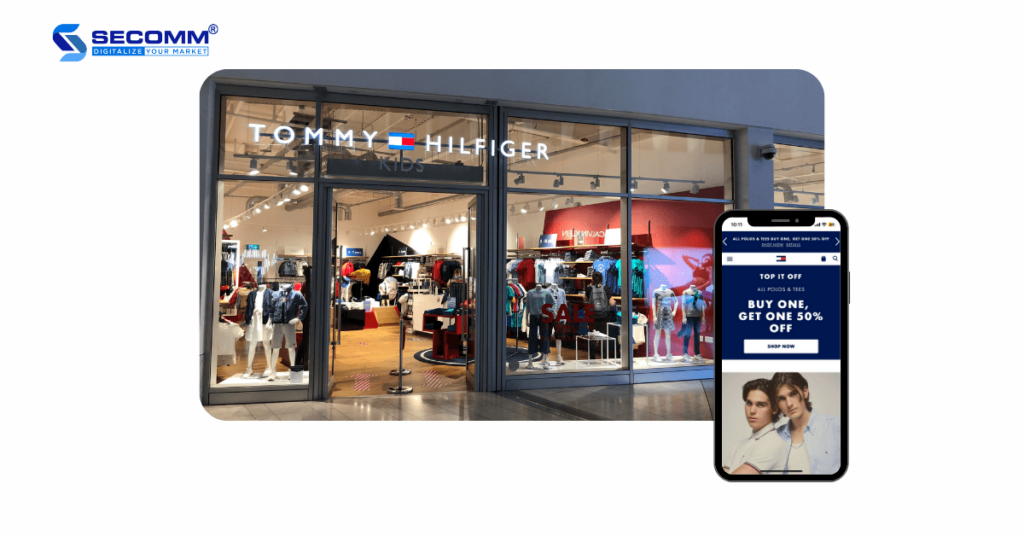
In recognition of the significance of an O2O commerce strategy, WeChat introduced a “Shake” feature that enables mobile users to connect to a nearby local business by shaking their phones. The retailer’s unique offers are then all accessible, encouraging customers to engage in the in-store buying experience.
Soon after, the 99 Ranch Market, a chain of Chinese-American supermarkets, benefited from the popularity of WeChat’s “Shake” feature and the rise of O2O among the Chinese community in the US. Customers can play a “beacon shake” game the company has created, which is activated by in-store beacons and gives them the chance to win a variety of prizes and coupons for their subsequent purchases.
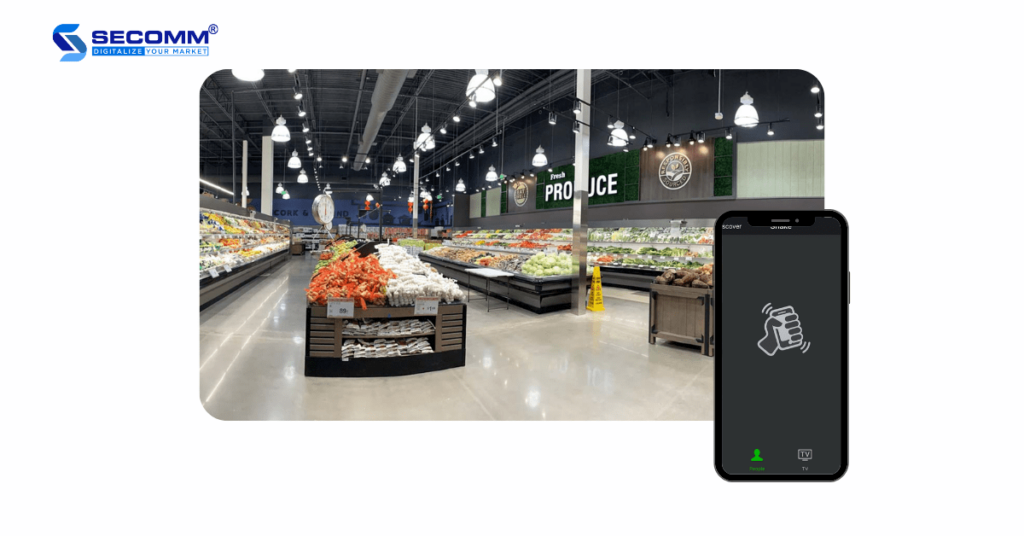
The O2O Commerce model is an incredible idea with great potential to change both online and offline sales in the eCommerce era. While customers can shop both in-store and online, brands can optimize engagement, conversion rates, and average order value.
Today, when customers’ expectations for online shopping are similar to offline shopping, one condition for physical stores to survive is to build their online presence quickly. The O2O strategy is about leveraging both online and offline channels, thereby enhancing brand loyalty, and providing a seamless Online-to-Offline shopping experience at all stages: before, during, and after purchases.
Want to know more? Contact our experts to learn more about O2O Commerce and how to implement it in your business.
 2
2
 4,779
4,779
 0
0
 1
1Subscribe to get the latest eBook!
Hotline